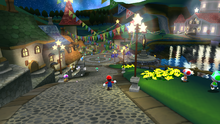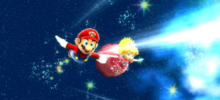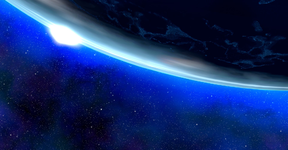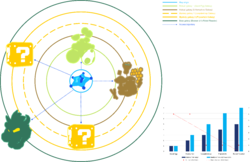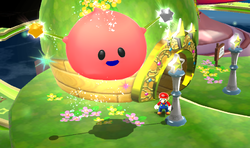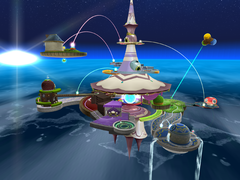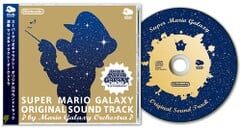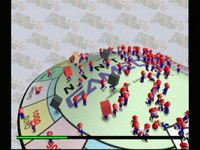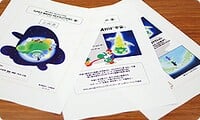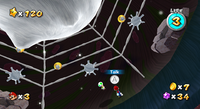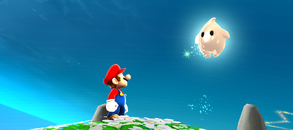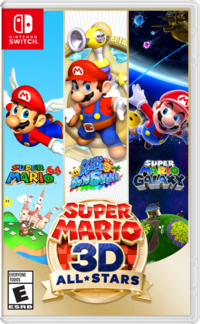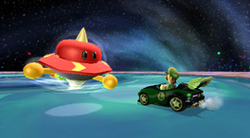Super Mario Galaxy: Difference between revisions
Nintendo101 (talk | contribs) m (→External links: TCRF) |
Tag: Reverted |
||
| Line 2,505: | Line 2,505: | ||
*''[[Mario + Rabbids Sparks of Hope]]'': [[Rabbid Rosalina]] is a playable character. The antagonist [[Cursa]] possesses Rosalina herself for most of the game. [[Spark (Mario + Rabbids Sparks of Hope)|Sparks]] are part Luma. An arrangement of "Rosalina in the Observatory" plays when Rabbid Rosalina obtains a [[Purified Darkmess Energy Crystal]]. A music box rendition of the main melody's first three notes also plays when Rabbid Rosalina uses her [[Ennui]] move. An arrangement of the theme also plays when Rabbid Rosalina is introduced in the game's cinematic trailer. | *''[[Mario + Rabbids Sparks of Hope]]'': [[Rabbid Rosalina]] is a playable character. The antagonist [[Cursa]] possesses Rosalina herself for most of the game. [[Spark (Mario + Rabbids Sparks of Hope)|Sparks]] are part Luma. An arrangement of "Rosalina in the Observatory" plays when Rabbid Rosalina obtains a [[Purified Darkmess Energy Crystal]]. A music box rendition of the main melody's first three notes also plays when Rabbid Rosalina uses her [[Ennui]] move. An arrangement of the theme also plays when Rabbid Rosalina is introduced in the game's cinematic trailer. | ||
*''[[The Super Mario Bros. Movie]]'': A [[Lumalee]] and [[Bat (Super Mario Galaxy)|bats]] are in the movie. "The Toad Brigade" is incorporated into "Strange New World". The piece overall is associated with [[Toad]]. An arrangement of "Gusty Garden Galaxy" plays in the credits. | *''[[The Super Mario Bros. Movie]]'': A [[Lumalee]] and [[Bat (Super Mario Galaxy)|bats]] are in the movie. "The Toad Brigade" is incorporated into "Strange New World". The piece overall is associated with [[Toad]]. An arrangement of "Gusty Garden Galaxy" plays in the credits. | ||
*''[[Super Mario Bros. Wonder]]'' Pumpkins bear a resemblance to [[Jack O'Goomba]] Pumpkins when a [[Wonder Effect]] is activated | |||
==Gallery== | ==Gallery== | ||
Revision as of 13:29, September 2, 2024
- "Mario Galaxy" redirects here. For the stage in Super Smash Bros. for Wii U and Super Smash Bros. Ultimate, see Mario Galaxy (stage).
- "Super Mario Wii" redirects here. For the game released in 2009, see New Super Mario Bros. Wii.
| Super Mario Galaxy | |||||||||||||||||||
|---|---|---|---|---|---|---|---|---|---|---|---|---|---|---|---|---|---|---|---|
 For alternate box art, see the game's gallery. | |||||||||||||||||||
| Developer | Nintendo EAD Tokyo | ||||||||||||||||||
| Publisher | Nintendo | ||||||||||||||||||
| Platform(s) | Wii, Wii U, Nvidia Shield TV (Mainland China only)[1] | ||||||||||||||||||
| Release date | Original release: Template:Release Nintendo Selects: Template:Release Wii U (digital download): Template:ReleaseNvidia Shield TV: Template:Release[?] | ||||||||||||||||||
| Language(s) | English (United Kingdom) English (United States) French (France) French (Canada) German Spanish (Spain) Spanish (Latin America) Italian Japanese Simplified Chinese1 Korean 1 - Only in the Nvidia Shield TV version. | ||||||||||||||||||
| Genre | Platformer, action-adventure | ||||||||||||||||||
| Rating(s) | Original release:
| ||||||||||||||||||
| Mode(s) | Single-player, two-player co-op | ||||||||||||||||||
| Format | Wii: Wii U: Nvidia Shield TV:
| ||||||||||||||||||
| Input | Wii: Wii U: Nvidia Shield TV:
| ||||||||||||||||||
| Serial code(s) | RVL-RMGJ-JPN (Japan) | ||||||||||||||||||
Super Mario Galaxy is a 3D action-adventure platform game for the Wii, first released in Japan on November 1, 2007. It is the eleventh entry in the Super Mario series,[2] the third 3D platformer, and the first of what would be recognized in retrospect as the "course clear-style" games of the series.[3][4] In this game, the player controls Mario in outer space, moving across spherical planetoids with their own centers of gravity. The levels are more linear than those found in its 3D predecessors Super Mario 64 (1996) and Super Mario Sunshine (2002). Similar to prior games, Mario collects Power Stars to rescue Princess Peach from Bowser, who is trying to establish his own galaxy at the center of the universe. Mario is aided by Luigi, a brigade of Toads, star-shaped creatures called Lumas, and a mysterious woman named Rosalina. The save data description for the game is "Launch into a cosmic adventure!"
Upon its release, Super Mario Galaxy was met with critical acclaim and commercial success. It received various awards and accolades, including from the Academy of Interactive Arts & Sciences, the Computer Entertainment Supplier's Association, and the British Academy of Film and Television Arts. It has sold 12.8 million copies, making it the ninth-best-selling Wii game.[5] It was rereleased in 2011 under the Nintendo Selects branding for having sold so well. It is one of the few Wii titles to have been rereleased on the Nvidia Shield TV console in 2018. Another rerelease with upscaled graphics was included in Super Mario 3D All-Stars alongside Super Mario 64 and Super Mario Sunshine on September 18, 2020, to correspond with the 35th anniversary of Super Mario Bros. (1985).[6] After its original release, a dedicated sequel, Super Mario Galaxy 2, was developed and released for the Wii on May 22, 2010.
Super Mario Galaxy has gone on to be considered one of the greatest video games of all time and a masterpiece.[7][8][9][10]
Story
From the instruction booklet
Every hundred years, a huge comet flies by in the skies above the Mushroom Kingdom. One year, that comet filled the entire sky, and from it fell a stream of shooting stars. The Toads scooped up the Star Bits and brought them to the castle, where they were reborn as a great Power Star. It was a happy time in the Mushroom Kingdom. Then one night Mario received a letter...
Dear Mario, I'll be waiting for you at the castle on the night of the Star Festival. There's something I'd like to give you. From Peach
With invitation in hand, Mario headed off to the castle just as the Star Festival was getting into full swing. Surrounded by Toads gleefully trying to catch falling Star Bits, Mario was looking forward to the night's festivities.
But then, something happened...
Every century, on the eve of the Star Festival, a comet passes over the Mushroom Kingdom and causes stars to fall to the planet below. Princess Peach invites Mario to her castle to join in the festivities and receive a special gift. As Mario arrives in the Castle Gardens, Bowser suddenly attacks the Toads with his airships and encases them in crystals. He "invites" Peach to the creation of his brand new galaxy and uses a UFO to lift the castle off the ground and carry it to the center of the universe, taking her and two Toads with it. Mario manages to reach the castle just before it is taken into outer space, but before he can get to Peach, Kamek suddenly appears and casts a spell at him, knocking him off the castle and deep into space. An apricot-colored Luma, whom Peach was carrying before her abduction, flees to look for Mario before Kamek uses another spell to warp the castle away.
Mario is awoken by the apricot-colored Luma on a small, grassy planet. Here, he meets other Lumas and Rosalina, a mysterious woman who acts as the protector of the galaxies and the mother of the Lumas. She tells Mario that her ship, the Comet Observatory, had its Power Stars stolen by Bowser. Without them, the Comet Observatory is unable to move through space. Rosalina asks him to reclaim her Power Stars and offers to help rescue Peach and defeat Bowser in exchange. To help him on his quest, Rosalina gives Mario the apricot-colored Luma, who grants Mario the ability to spin and travel through space. Together, they travel to various galaxies in opened domes to obtain Power Stars. Once a mission is completed in one galaxy, Mario collects a Power Star and unlocks the next mission. Most domes contain five galaxies. Once Mario has collected enough Power Stars, the next galaxy in the current dome is an enemy base, where the Grand Stars, which are larger and more powerful versions of Power Stars, would be in the possession of either Bowser or Bowser Jr. Rescuing a Grand Star unlocks the next dome, and when enough Power Stars are collected, the Comet Observatory is able to take Mario to the center of the universe.
After arriving at and traversing through Bowser's brand new galaxy, Mario defeats him, retrieves the last Grand Star, and rescues Peach. Just as they are about to leave, however, a large sun in Bowser's near-complete galaxy undergoes a supernova and becomes a supermassive black hole, which begins pulling in everything in sight. The Lumas from the Comet Observatory, including the apricot-colored Luma, throw themselves into the black hole in order to neutralize it, and it soon evaporates in a massive explosion. Mario appears in front of Rosalina, who saves him from the cataclysm and tells him that this is not the end, but a new beginning for the universe, which repeats its cycle indefinitely and slightly different across each repetition.
Mario later awakens in the Mushroom Kingdom near Peach's Castle, where he witnesses the various friends and foes he met throughout his adventure celebrating together. He then notices Bowser and Peach lying next to him as they begin to stir. When he looks into the sky, he notices a newborn galaxy and hears Rosalina's words echoing in his mind. Mario stands up and exclaims, "Welcome! Welcome new galaxy!" as the camera pans out into space, revealing the reconstructed universe. After 120 Power Stars have been collected, a special cutscene plays after the staff roll: Rosalina thanks the player and says, "I will watch over you from beyond the stars," before flying off with the Comet Observatory. Alone in the rubble left by the supermassive black hole, an apricot-colored Luma appears behind a decrepit starship. This alludes to the idea of how the universe repeats itself. The events of the past will carry out anew, with the lost apricot Luma searching for its mother.
Gameplay
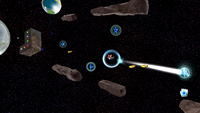
The player controls Mario,[note 1] who platforms mainly on spherical planetoids, and he completes levels by collecting Power Stars. His jumping actions allow him to hop between platforms and stomp enemies. Most enemies that cannot be stomped on can be taken out or dazed with a spin, a move new to the series. Rather than performed with button inputs, shaking the Wii Remote makes Mario spin. In addition to taking out enemies, spinning makes Mario engage switches, parry certain attacks, skate on ice, throw held items, and perform an extra small jump in the air. Several actions in Super Mario Galaxy are not strictly tied to button inputs and are instead performed by shaking, tilting, or rotating the remote. The game's camera organically pans across levels, but the player can manually angle it with ![]() . Pressing
. Pressing ![]() centers the camera behind Mario and pressing
centers the camera behind Mario and pressing ![]() enters a first-person perspective.
enters a first-person perspective.
There are scenarios in the game that change what button inputs do. In some missions, Mario rides on top of a Rolling Ball, surfs on the back of a manta ray, or travels through the air in a giant bubble. Power-ups change his appearance and give him a unique set of abilities in place of his usual ones (see below). While in water, Mario can swim. Pressing ![]() makes him dive. Pressing
makes him dive. Pressing ![]() makes Mario perform a breaststroke, propelling him forward.
makes Mario perform a breaststroke, propelling him forward.
Pointing the Wii Remote at the screen makes an on-screen reticle appear called the Star Pointer. It gives the player a way to engage with the game that is not tied to Mario. Passively moving the Star Pointer over Star Bits, small colorful items, automatically collects them. Pressing ![]() fires a Star Bit from the pointer. There are non-playable characters called Hungry Lumas that transform into new levels when shot at with Star Bits - their source of food. Most enemies become dazed when shot by a Star Bit. Mario kicks a stunned enemy just by making contact with it, defeating it and releasing collectible Star Bits.
fires a Star Bit from the pointer. There are non-playable characters called Hungry Lumas that transform into new levels when shot at with Star Bits - their source of food. Most enemies become dazed when shot by a Star Bit. Mario kicks a stunned enemy just by making contact with it, defeating it and releasing collectible Star Bits.
Mario's health is represented by a three-segmented life meter. Receiving damage removes one section, and losing all makes him lose a life. Collecting a Life Mushroom replenishes any lost health and adds a second health meter, giving Mario a total of six bars. If Mario is reduced to three bars again, the second meter permanently disappears and the effect of the Life Mushroom is lost. He does not take damage by falling from high areas, a departure from proceeding 3D games. While underwater, he gains an air meter that decreases and starts to deplete Mario's normal life meter when it hits zero.
Most levels are clusters of small planetary bodies with their own centers of gravity, causing Mario to organically bend around them as he moves or jumps. Not all planetary bodies are spherical, but they at least have rounded edges to compliment the concept.[11] Planets with sharp edges only have one gravitational plane, like the courses in Super Mario 64 and Super Mario Sunshine. Mario will fall and lose a life if he jumps off the edges of these planets. Some planetoids are so close to each other that Mario can simply jump between them, but others are very distant. In most cases, he can reach them by using Launch Stars, yellow objects that fire Mario through the sky. The levels in the game can be accessed by domes scattered across the Comet Observatory, the game's hub world. For more detail on level structure, galaxies, and the hub, see "Locations" below.
Co-Star Mode
The game has a multiplayer mode called Co-Star Mode. Connecting a second Wii Remote allows another player (P2) to join in and assist the first one (P1) by controlling a second Star Pointer. There are a number of actions that are available only to the second player. When Co-Star Mode is active, "1P" appears below Player 1's Star Pointer, and "2P" appears below Player 2's Star Pointer to help differentiate between them. Like the first player, P2 can collect Star Bits and fire them at enemies to briefly stun them. When P2 directs their Star Pointer at Mario and presses ![]() , he performs a unique action called the Co-Star Super Jump. Combining both jump techniques can make Mario jump higher than when controlled with only one controller. This works in midair, but it can be done only once before the player touches a horizontal surface.[12]
, he performs a unique action called the Co-Star Super Jump. Combining both jump techniques can make Mario jump higher than when controlled with only one controller. This works in midair, but it can be done only once before the player touches a horizontal surface.[12]
Luigi
Completing "The Fate of the Universe" after 120 Power Stars have been collected allows the player to replay the entire game as Mario's brother, Luigi, who otherwise appears as a non-playable character that assists Mario. Luigi can jump higher than him but has worse traction, making him skid. He also runs slightly faster than Mario but takes longer to reach top speed. Luigi loses air faster while underwater and loses a chunk of air every time he spins underwater. Cosmic Luigi, one of the rival characters, is more challenging than Cosmic Mario, and Luigi receives twenty 1-Up Mushrooms from Princess Peach instead of Mario's usual five (although if Luigi's life counter is too high, he only receives five). Outside of these changes, the storyline is almost completely unchanged and even includes the original NPC Luigi, who will now react with confusion at seeing a copy of himself (although his height is marginally different). When the player collects 120 Power Stars and replays "The Fate of the Universe", Grand Finale Galaxy becomes available for both Mario and Luigi, allowing the 121st Power Star to be collected by each of them.
This mode is referred to by Rosalina as "another world". In the Japanese version, she describes it as the world where Mario may come across his alternate self who is not him.[13]
Controls
When playing on a Wii or Wii U console by oneself (P1), the game requires one to use the Wii Remote attached to the Nunchuk. If the player attempts to access the game without the Nunchuk attached, it will prompt the player to do so before proceeding. One will not be able to access the rest of the game unless they do so. In Co-Star Mode, the second player (P2) is not required to have the Nunchuk attached to their Wii Remote but it still must be held vertically.
The controller for the Nvidia Shield TV has a more conventional layout, cannot display a pointer on screen, and lacks the same motion-sensing capabilities of the Wii Remote. To compensate, actions that originally involved shaking the Wii Remote are performed by pressing the X button. Actions involving the Star Pointer are instead performed with the right analog stick. In Co-Star Mode, both analog sticks can be used to control the Star Pointer.[14] The original tilt controls in the game is also replaced by the regular left analog stick control.[15][16]
For the control scheme of the iteration included in Super Mario 3D All-Stars for Nintendo Switch systems, click here.
| Action(s) | Input(s) | |||
|---|---|---|---|---|
| Wii Remote + Nunchuk | Nvidia Shield controller | |||
| Mario and Luigi controls | ||||
| Move | ||||
| Spin, engage object, throw item, skate | Shake |
|||
| Kick | Make contact with stunned enemy | |||
| Jump, speak, read, swim | ||||
| Double jump | (repeat twice) |
(repeat twice) | ||
| Triple jump | (repeat thrice) |
(repeat thrice) | ||
| Backward somersault | ||||
| Wall jump | ||||
| Side somersault | ||||
| Long jump | ||||
| Spin jump | Shake |
|||
| Ground pound | ||||
| Homing ground pound | Shake |
|||
| Grab or release pole | ||||
| Crouch, dive underwater | ||||
| Crawl | ||||
| Sweep kick | ||||
| Move camera | ||||
| Enter first-person view | ||||
| Reset camera | ||||
| Rolling ball | Tilt |
Tilt | ||
| Ray surfing | ||||
| Power-up controls | ||||
| Hover in Bee form | Hold |
Hold | ||
| Float in Boo form | ||||
| Phase through walls in Boo form | Shake |
|||
| Toss fireball in Fire form | Shake |
|||
| Bounce in Spring form | ||||
| Takeoff or ground in Flying form | Shake |
|||
| Change direction in Flying form | ||||
| Star Pointer controls | ||||
| Collect a Star Bit | Move Template:Chart icon over a Star Bit | Move | ||
| Shoot a Star Bit | Template:Chart icon + |
|||
| Rapidly shoot Star Bits | Template:Chart icon + hold |
|||
| Enter a Pull Star, blow air to direct bubble (P1 only) | Template:Chart icon + hold |
|||
| Fire cannon (P1 only) | Template:Chart icon + |
|||
| Fire from Sling Pod (P1 only) | Hold |
Hold | ||
| Stop an enemy (P2 only) | Move Template:Chart icon over an enemy + hold |
Move | ||
| Make Mario jump (P2 only) | Move Template:Chart icon over Mario + |
Move | ||
| Make Mario spin (P2 only) | Move Template:Chart icon over Mario while he is midair + |
Move | ||
| Make Mario do a powerful jump (P2 only) | Move Template:Chart icon over Mario + |
Move | ||
| Menu controls | ||||
| Navigate menu | Template:Chart icon | |||
| Confirm command | ||||
| Cancel command | ||||
| Select galaxy | ||||
| Display HOME menu | ||||
| Display pause menu | ||||
Locations
Setting
Super Mario Galaxy is set in outer space. With the exception of Grand Finale Galaxy, which is Princess Peach's Castle Gardens in the Mushroom Kingdom, all levels, which are referred to in the game as "galaxies", are staged on worlds far removed from Mario's home planet. This is the first entry in the series to explicitly include an outer space setting since the Space Zone in Super Mario Land 2: 6 Golden Coins (1992) and the first time it has been realized by Nintendo EAD, the studio responsible for most of the preceding Super Mario games.[17]
A galaxy is an isolated cluster of small planets and other planetary bodies. Some planets are shaped like spheres, but many are not. Most have their own gravitational pull, which lets Mario return to his starting position by continuing to move forward and prevents him from falling off the edge. Mario's movement, physics, and trajectory bend organically around a planet's shape.[18][19] Because they have their own pull, Mario can directly travel between sufficiently close planets just by jumping. More distant planets are reached by using objects such as Launch Stars and Pull Stars. Not all planets pull Mario inwards. When inside a planet, gravity may be inverted so that Mario walks on the underside of the ground. Many other planets are shaped like the more traditional courses of Super Mario 64 and Super Mario Sunshine, and thus have only one gravitational plane, which is communicated by sharp edges and steep drops along their sides. In contrast, planets that have their own gravity, even if they are not spheres, have rounded edges.[19] Some planets are on 2D planes and Mario's movement options are restricted accordingly (i.e. the player cannot tilt ![]() down to make him walk toward the camera and fall off the side). Gravity fields occur in the 2D sections of five galaxies that shift the direction of gravity from the floor to another plane.
down to make him walk toward the camera and fall off the side). Gravity fields occur in the 2D sections of five galaxies that shift the direction of gravity from the floor to another plane.
The theme of space is communicated in various ways throughout Super Mario Galaxy. Many galaxies include distant asteroid belts or views of massive, unreachable planets orbiting suns that peek over their horizons. Depending on the distance from the game's camera, the light from a visible sun retracts, mimicking the behavior of real sunlight. The skyboxes of the galaxies feature nebulas, auroras, and starry skies. Three-dimensional objects, including Mario himself, exhibit a soft Fresnel-like glow in certain positions as if struck by the light from distant stars. In many galaxies, black holes are present in place of bottomless pits. Super Mario Galaxy includes some motifs associated with science fiction, such as humanoid robots, fortified battle facilities, UFOs, starships, an orchestrated soundtrack, and theremin-like synthesizers. Much of the game's setting includes whimsical, tranquil, and surreal elements comparable to those found in children's books.[20][21][22] Locations are reached via a palace-like starship called the Comet Observatory, the game's hub world. It is overseen by a princess named Rosalina and is a nursery for spacefaring star children called Lumas. In lieu of aliens, the people found living in the galaxies include Star Bunnies, Honeybees, and penguins. Star Bits, small collectibles that fall from the sky like shooting stars, resemble konpeitō candies and can be fed to the Lumas. There are planets and entire galaxies that look like desserts.
According to director Yoshiaki Koizumi, the primary goal behind Super Mario Galaxy was to create a Super Mario game with spherical worlds. It was thought that these worlds would make it less likely for players to get disoriented or have to reposition the camera. These were issues he observed during the development of Super Mario 64, The Legend of Zelda: Ocarina of Time (1998), and Super Mario Sunshine that prevented complete immersion and intimidated inexperienced players.[18][19] The decision to stage the game in outer space was made because the development team thought that the spherical worlds would most intuitively make sense as planets.[17] In 2017, a figure was released by Nintendo that conveys that Super Mario Galaxy is structurally viewed as a different type of 3D Super Mario game from its immediate predecessors – the "sandbox-style" games Super Mario 64 and Super Mario Sunshine. Nintendo aligns it with the succeeding games Super Mario Galaxy 2 (2010), Super Mario 3D Land (2011), and Super Mario 3D World (2013) as a more linear, "course clear-style" game.[3] However, many of the levels in Super Mario Galaxy are structured similarly to the ones in its predecessors, particularly in the robust six-mission galaxies and the large planets that do not have their own centers of gravity.[19] The principals of the sandbox-style games derive from hakoniwa, or "box gardens", and Koizumi directly cites them as an influence behind the worlds in Super Mario Galaxy as well.[18][20][4]
Galaxies
Overview
- Main article: Galaxy
Bottom row: a figure of the Terrace's galaxies conveying their positioning from the Pull Star; how they are accessed; the correlations involving their distance from the Pull Star; and the three different types of galaxies within domes. These attributes generally are representative of all domes in the game.
Galaxies are accessed inside of domes on the Comet Observatory. They are spatially distributed across the hub, similar to the access points for levels in Super Mario 64 and Super Mario Sunshine. However, with the exception of the Garden, each dome contains a set of five different galaxies instead of just one dedicated course. Domes are unlocked unilaterally as the player completes certain criteria. These make the domes analogous to the worlds of the 2D Super Mario games like Super Mario Bros. 3 (1988). However, as in its 3D predecessors, the player is not restricted to linear course progression in Super Mario Galaxy.
Each galaxy contains objectives referred to as missions. Completing a mission has Mario acquire one of the galaxy's Power Stars, the same tokens used in Super Mario 64 for unlocking levels. One mission correlates with one Power Star. The start of each mission has a brief cinematic preview of the galaxy that hints at the location of the Power Star, as was similarly done in Super Mario Sunshine. Once a specified number of Power Stars has been accumulated, a new galaxy becomes unlockable at the player's discretion. Only half of the Power Stars in the game are required for progression. The minimum number of Power Stars needed to access the game's final level is 60 out of the game's total of 120. Consequently, completing as many missions as possible within one dome can result in all of the galaxies within the next dome being immediately unlockable upon entry.
At the center of every dome is a Pull Star that, upon being entered, brings Mario to an interactive selection screen of all the dome's galaxies, which all orbit around the Pull Star (the origin; see right). The display is directly comparable to models of solar systems, with each galaxy following a circular trajectory around the Pull Star. The distance of these orbital lines from the Pull Star has a positive correlation with the number of Power Stars required to unlock the galaxies and a negative correlation with the number of missions available within them. As such, the galaxies closest to the origin typically have the greatest number of missions and require the lowest number of Power Stars to unlock, while the galaxies furthest from the origin contain the fewest missions and require the highest number of Power Stars to unlock. Using the Terrace as an example, a dome contains three different types of galaxies:
- "Robust galaxies" that contain at least six missions. They either feature a high number of visitable planets or a small selection of large ones to explore. The missions build off of each other environmentally or narratively, meaning that the events that occur in one mission foreshadow the events of the subsequent mission. Two or more of the six missions typically involve a boss battle. Most domes contain two or three of these galaxies, and they are all listed together on the first page of the in-game Star List. They are the only galaxies orbited by Prankster Comets. The robust galaxies of the Terrace are Good Egg Galaxy and Honeyhive Galaxy.
- "Mystery galaxies" that each contain one mission. Before being unlocked, they are represented by course preview models shaped like ? Blocks. These galaxies are highly distinctive in theme and mission. Some of them entail minigames like ray surfing or ball rolling. Others are athletic obstacle courses. Mystery galaxies usually require completing a certain mission in another galaxy in addition to accumulating a specific number of Power Stars to unlock. Each dome contains one or two mystery galaxies. In the Terrace, they are Loopdeeloop Galaxy and Flipswitch Galaxy.
- Enemy bases[23] that each contain one mission. They have tilted orbits and feature linear obstacle courses that lead to a boss battle. Half of them involve Bowser Jr., either directly or as the inciter for another boss (such as Megaleg or King Kaliente). The other half of them feature Bowser himself. With the exception of the Garden, each dome contains one enemy base and it is always on the dome's outermost ring. These galaxies have the highest or second-highest Power Star threshold, and completing the mission in these galaxies is a criterion needed to unlock a subsequent dome and is required for game progression. The preview model in orbit resembles a bust of Bowser's head with glowing eyes. The enemy base in the Terrace is Bowser Jr.'s Robot Reactor.
Certain galaxies can be accessed outside of the domes. With the exception of Gateway Galaxy, these ones can also be categorized as mystery galaxies or enemy bases. Most of them are unlocked by feeding Hungry Lumas a requested number of Star Bits. These Lumas appear on the Comet Observatory once certain criteria are met within the dome galaxies (as seen in the chart below). There is a Hungry Luma associated with every dome, essentially functioning as an extra level for each one. A tiny house called the Gate rests on a grassy platform orbiting the observatory. It grants Mario access to Gateway Galaxy. This galaxy is the first level of the game, but it can only be revisited via the Gate once "King Kaliente's Spicy Return" is completed. Though it is not a dome, there is a Hungry Luma associated with it as well. A planetoid called the Planet of Trials orbits the observatory and has three galaxies of its own. It becomes reachable once all three of the secret Green Power Stars have been collected. A Launch Star leading to Grand Finale Galaxy appears here after the player has collected 120 Power Stars as both Mario and Luigi. Bowser's Galaxy Reactor is only reachable by speaking to Rosalina after 60 Power Stars have been collected.
Mario encounters his brother in four galaxies: Good Egg Galaxy, Honeyhive Galaxy, Battlerock Galaxy, and Ghostly Galaxy. In Ghostly Galaxy, Luigi is at the end of the mission "Luigi and the Haunted Mansion" and gives Mario a Power Star when reached. After Luigi is rescued, he appears in the observatory and offers to help Mario collect Power Stars. Whenever Luigi visits a galaxy, he gets stuck and sends a letter to Mario asking for help, with each letter including a picture that hints at his location. Finding him within a galaxy awards Mario with a secret Power Star.
Table
There are 42 dedicated galaxies in the game. Of this total, 15 are robust galaxies, 20 are mystery galaxies, and 6 are enemy bases. If the Comet Observatory, its library, and its domes are considered individual levels, then the true total number is 50. Some galaxies have tiny otherworldly subareas reached via pipes that contain an interactive side objective. If each of these areas were to be considered levels as well, then the true number is even higher. The table below lists the galaxies of the game roughly as they are listed on the Star List. Each galaxy is given a brief description, an in-game screenshot, and a list of their missions. There is a legend at the bottom of the table detailing what the symbols used in it represent.
| Galaxies | ||
|---|---|---|
| 01. Good Egg Galaxy Template:Chart icon×6 Template:Chart icon×19 Template:Chart icon×3 |
Missions | |

|
Template:Chart icon Dino Piranha | Template:Chart icon A Snack of Cosmic Proportions |
| Template:Chart icon King Kaliente's Battle Fleet | Template:Chart icon Dino Piranha Speed Run | |
| Template:Chart icon Purple Coin Omelet | Template:Chart icon Luigi on the Roof | |
| A galaxy in low orbit of an earth-like planet. Each planet is highly distinctive, but most of them have grassy knolls and are shaped like food. It introduces the reoccurring Electrogoombas and King Kaliente. Unlock criterion: complete "Grand Star Rescue" | ||
| 02. Honeyhive Galaxy Template:Chart icon×6 Template:Chart icon×7 Template:Chart icon×2 |
Missions | |

|
Template:Chart icon Bee Mario Takes Flight | Template:Chart icon Trouble on the Tower |
| Template:Chart icon Big Bad Bugaboom | Template:Chart icon Honeyhive Cosmic Mario Race | |
| Template:Chart icon The Honeyhive's Purple Coins | Template:Chart icon Luigi in the Honeyhive Kingdom | |
| The Honeyhive Kingdom – a forested galaxy inhabited by Honeybees. Its planets have large trees and clear bodies of water. Some areas are covered in honey. The kingdom is invaded by Mandibugs. Unlock criterion: collect 3 Power Stars | ||
| 03. Loopdeeloop Galaxy Template:Chart icon×1 Template:Chart icon×3 |
Mission | |

|
Template:Chart icon Surfing 101 | |
| A looping stretch of water. Penguins surf on the backs of rays here. Coach explains the basics to Mario. Unlock criterion: collect 5 Power Stars | ||
| 04. Flipswitch Galaxy Template:Chart icon×1 Template:Chart icon×1 |
Mission | |

|
Template:Chart icon Painting the Planet Yellow | |
| Flipswitch Panels arranged like a cube around a black hole. Spikes move along suspended tracks over the panels. Unlock criterion: collect 7 Power Stars | ||
| 05. Bowser Jr.'s Robot Reactor Template:Chart icon×1 Template:Chart icon×2 Template:Chart icon×1 |
Mission | |

|
Template:Chart icon Megaleg's Moon | |
| A metal sphere with Bill Blasters and an artificial moon orbiting an earth-like planet. Bowser Jr.'s robot, Megaleg, is on the moon. Unlock criterion: collect 8 Power Stars | ||
| Template:Chart icon Sweet Sweet Galaxy Template:Chart icon×1 Template:Chart icon×3 |
Mission | |

|
Template:Chart icon Rocky Road | |
| An athletic course made of cakes, cookies, and other sweets. It has long stretches of continuously moving platforms with shapes cut out of them. Unlock criteria: collect 7 Power Stars and feed the Hungry Luma 400 Star Bits | ||
| 06. Space Junk Galaxy Template:Chart icon×6 Template:Chart icon×16 Template:Chart icon×2 |
Missions | |

|
Template:Chart icon Pull Star Path | Template:Chart icon Kamella's Airship Attack |
| Template:Chart icon Tarantox's Tangled Web | Template:Chart icon Pull Star Path Speed Run | |
| Template:Chart icon Purple Coin Spacewalk | Template:Chart icon Yoshi's Unexpected Appearance | |
| A stretch of rocks and space debris. Large portions of the galaxy are navigated via Pull Stars and Sling Pods. A giant spider lives here and traps members of the Toad Brigade in its web. Unlock criteria: collect 9 Power Stars and complete "Megaleg's Moon" | ||
| 07. Rolling Green Galaxy Template:Chart icon×1 Template:Chart icon×4 |
Mission | |

|
Template:Chart icon Rolling in the Clouds | |
| Flat, grassy planets arranged like a golf course. They can only be navigated by riding the Rolling Ball. Most planets have flowerbeds and groups of Goombas. Unlock criterion: collect 11 Power Stars | ||
| 08. Battlerock Galaxy Template:Chart icon×7 Template:Chart icon×11 Template:Chart icon×2 |
Missions | |

|
Template:Chart icon Battlerock Barrage | Template:Chart icon Breaking into the Battlerock |
| Template:Chart icon Topmaniac and the Topman Tribe | Template:Chart icon Topmaniac's Daredevil Run | |
| Template:Chart icon Purple Coins on the Battlerock | Template:Chart icon Battlerock's Garbage Dump | |
| Template:Chart icon Luigi under the Saucer | ||
| A battle facility equipped with electric traps and artilleries. Cannons and Bill Blasters line the Battlerock and start firing when Mario is in close proximity. The galaxy introduces the Topman Tribe. Unlock criterion: collect 12 Power Stars | ||
| 09. Hurry-Scurry Galaxy Template:Chart icon×1 Template:Chart icon×2 |
Mission | |

|
Template:Chart icon Shrinking Satellite | |
| Shrinking platforms arranged into a rhombicuboctahedron. A black hole is at the center of the planet. Notes cover the tiles. Collecting each one causes the black hole to disappear. Unlock criterion: collect 18 Power Stars | ||
| 10. Bowser's Star Reactor Template:Chart icon×1 Template:Chart icon×4 Template:Chart icon×1 |
Mission | |

|
Template:Chart icon The Fiery Stronghold | |
| A stone fortress orbiting a giant sun. It features a twisting path and gravity fields. Fire Bars and Thwomps obstruct the path. It feeds into a big staircase leading to Bowser. Unlock criterion: collect 15 Power Stars | ||
| Template:Chart icon Sling Pod Galaxy Template:Chart icon×1 Template:Chart icon×2 |
Mission | |

|
Template:Chart icon A Very Sticky Situation | |
| A cluster of Fire Bars, Space Mines, and cannons above a black hole. The galaxy is only traversable with Sling Pods. Unlock criteria: complete "Tarantox's Tangled Web" and feed the Hungry Luma 400 Star Bits | ||
| 11. Beach Bowl Galaxy Template:Chart icon×6 Template:Chart icon×3 |
Missions | |

|
Template:Chart icon Sunken Treasure | Template:Chart icon Passing the Swim Test |
| Template:Chart icon The Secret Undersea Cavern | Template:Chart icon Fast Foes on the Cyclone Stone | |
| Template:Chart icon Beachcombing for Purple Coins | Template:Chart icon Wall Jumping up Waterfalls | |
| A beach galaxy inhabited by penguins. Its largest planet is a hemisphere filled with water. The second is an obstacle course with Thwomps and Tox Boxes. A third, secret planet has waterfalls and Cataquacks. Unlock criteria: collect 16 Power Stars and complete "The Fiery Stronghold" | ||
| 12. Bubble Breeze Galaxy Template:Chart icon×1 Template:Chart icon×2 |
Mission | |

|
Template:Chart icon Through the Poison Swamp | |
| One giant planet covered in toxic sludge. Areas are separated by stone columns. It can only be navigated in a bubble. Space Mines and rotating objects within the areas can pop the bubble. Unlock criterion: collect 19 Power Stars | ||
| 13. Ghostly Galaxy Template:Chart icon×6 Template:Chart icon×12 Template:Chart icon×2 |
Missions | |

|
Template:Chart icon Luigi and the Haunted Mansion | Template:Chart icon A Very Spooky Sprint |
| Template:Chart icon Beware of Bouldergeist | Template:Chart icon Bouldergeist's Daredevil Run | |
| Template:Chart icon Purple Coins in the Bone Pen | Template:Chart icon Matter Splatter Mansion | |
| Decrepit planets orbiting a dimly-lit sun. Luigi is held captive in the largest planet, a haunted mansion. The ghost that captured him lives in this galaxy.[24] Unlock criterion: collect 20 Power Stars | ||
| 14. Buoy Base Galaxy Template:Chart icon×2 Template:Chart icon×2 |
Missions | |

|
Template:Chart icon The Floating Fortress | Template:Chart icon The Secret of Buoy Base |
| Two planets filled with water. Its largest planet is a hemisphere with a fortress at its center. It is equipped with rotating platforms, Water Shooters, and other hazards. The second is a sphere equipped with Ball Beamers. Unlock criteria: collect 30 Power Stars and complete "Sunken Treasure" | ||
| 15. Bowser Jr.'s Airship Armada Template:Chart icon×1 Template:Chart icon×4 Template:Chart icon×1 |
Mission | |

|
Template:Chart icon Sinking the Airships | |
| Bowser's airship fleet. Airships must be boarded to navigate the fleet, each one carrying enemies. A lift brings Mario to Bowser Jr. A tiny planetoid can be visited that has a bouncy surface. Unlock criterion: collect 23 Power Stars | ||
| Template:Chart icon Drip Drop Galaxy Template:Chart icon×1 Template:Chart icon×1 |
Mission | |

|
Template:Chart icon Giant Eel Outbreak | |
| An ocean planet where penguins swim. The birds are troubled by Gringills. A sunken airship and damaged Starshroom rest at the bottom of the ocean. Unlock criteria: complete "Sunken Treasure" and feed the Hungry Luma 600 Star Bits | ||
| 16. Gusty Garden Galaxy Template:Chart icon×6 Template:Chart icon×20 Template:Chart icon×2 |
Missions | |

|
Template:Chart icon Bunnies in the Wind | Template:Chart icon The Dirty Tricks of Major Burrows |
| Template:Chart icon Gusty Garden's Gravity Scramble | Template:Chart icon Major Burrows's Daredevil Run | |
| Template:Chart icon Purple Coins on the Puzzle Cube | Template:Chart icon The Golden Chomp | |
| Flowery planets above a sea of clouds. Floaty Fluffs grow here: they can be used to travel on gusts of wind to reach other planets. Star Bunnies live in this galaxy and grow flowers. They are chased by Undergrunts. Unlock criteria: collect 24 Power Stars and complete "Sinking the Airships" | ||
| 17. Freezeflame Galaxy Template:Chart icon×6 Template:Chart icon×5 Template:Chart icon×1 |
Missions | |

|
Template:Chart icon The Frozen Peak of Baron Brrr | Template:Chart icon Freezeflame's Blistering Core |
| Template:Chart icon Hot and Cold Collide | Template:Chart icon Frosty Cosmic Mario Race | |
| Template:Chart icon Purple Coins on the Summit | Template:Chart icon Conquering the Summit | |
| A galaxy with cold and hot planets. The cold planet features Freezy Peak, a snowy mountain with freezing water at its base. The hot planet is a molten sphere split in half. Stone platforms enable traversal between the two halves. Unlock criterion: collect 26 Power Stars | ||
| 18. Dusty Dune Galaxy Template:Chart icon×7 Template:Chart icon×14 |
Missions | |

|
Template:Chart icon Soaring on the Desert Winds | Template:Chart icon Blasting through the Sand |
| Template:Chart icon Sunbaked Sand Castle | Template:Chart icon Sandblast Speed Run | |
| Template:Chart icon Purple Coins in the Desert | Template:Chart icon Bullet Bill on Your Back | |
| Template:Chart icon Treasure of the Pyramid | ||
| Sandy planets under a desert sun. Shifting and rising sand makes platforms move rapidly or sink underground. One planet is a floating pyramid that can be entered, and some are covered in quicksand. Unlock criterion: collect 29 Power Stars | ||
| 19. Honeyclimb Galaxy Template:Chart icon×1 Template:Chart icon×3 |
Mission | |

|
Template:Chart icon Scaling the Sticky Wall | |
| Giant slabs of honeycombs. The Bee Mushroom appears here. Meteors and Mandibugs appear as hazards. Unlock criterion: collect 42 Power Stars | ||
| 20. Bowser's Dark Matter Plant Template:Chart icon×1 Template:Chart icon×5 Template:Chart icon×1 |
Mission | |

|
Template:Chart icon Darkness on the Horizon | |
| A dark world containing a trap-filled obstacle course. It features gravity fields and concentrations of dark matter. Most of the course is on a two-dimensional plane. The course leads to Bowser. Unlock criterion: collect 33 Power Stars | ||
| Template:Chart icon Bigmouth Galaxy Template:Chart icon×1 Template:Chart icon×1 |
Mission | |

|
Template:Chart icon Bigmouth's Gold Bait | |
| A giant stone fish orbiting a massive ocean planet. The belly of the fish contains two lakes, whirlpools, beds of seaweed, and Boos. Penguru comes here when he wants to be alone. Unlock criteria: complete "Soaring on the Desert Winds" and feed the Hungry Luma 800 Star Bits | ||
| 21. Gold Leaf Galaxy Template:Chart icon×6 Template:Chart icon×6 Template:Chart icon×1 |
Missions | |

|
Template:Chart icon Star Bunnies on the Hunt | Template:Chart icon Cataquack to the Skies |
| Template:Chart icon When It Rains, It Pours | Template:Chart icon Cosmic Mario Forest Race | |
| Template:Chart icon Purple Coins in the Woods | Template:Chart icon The Bell on the Big Tree | |
| Wooded planets inhabited by Honeybees. Its largest planet mirrors the Honeyhive Kingdom. Cataquacks live on the surrounding wooden planets. Unlock criteria: collect 34 Power Stars and complete "Darkness on the Horizon" | ||
| 22. Sea Slide Galaxy Template:Chart icon×6 Template:Chart icon×3 |
Missions | |

|
Template:Chart icon Going after Guppy | Template:Chart icon Faster Than a Speeding Penguin |
| Template:Chart icon The Silver Stars of Sea Slide | Template:Chart icon Underwater Cosmic Mario Race | |
| Template:Chart icon Purple Coins by the Seaside | Template:Chart icon Hurry, He's Hungry | |
| An ocean galaxy with penguins. Its largest planet is a cavernous sphere with a looping stretch of water feeding through it. There is a teardrop-shaped planet with tidal pools at the galaxy's center. Unlock criterion: collect 36 Power Stars | ||
| 23. Toy Time Galaxy Template:Chart icon×6 Template:Chart icon×14 Template:Chart icon×1 |
Missions | |

|
Template:Chart icon Heavy Metal Mecha-Bowser | Template:Chart icon Mario Meets Mario |
| Template:Chart icon Bouncing Down Cake Lane | Template:Chart icon Fast Foes of Toy Time | |
| Template:Chart icon Luigi's Purple Coins | Template:Chart icon The Flipswitch Chain | |
| A playroom galaxy. Its planets are shaped like wooden blocks, puzzle pieces, colored pencils, and model trains. Some areas resemble cakes and other sweets. The galaxy is maintained by Gearmos, some of which are trapped within a giant robot. Unlock criterion: collect 40 Power Stars | ||
| 24. Bonefin Galaxy Template:Chart icon×1 Template:Chart icon×2 Template:Chart icon×1 |
Mission | |

|
Template:Chart icon Kingfin's Fearsome Waters | |
| A cavernous planet with conical mountains. Beneath its surface is an ocean with hydrothermal vents. The shark Kingfin swims here. Unlock criteria: collect 55 Power Stars and complete "Giant Eel Outbreak" | ||
| 25. Bowser Jr.'s Lava Reactor Template:Chart icon×1 Template:Chart icon×3 Template:Chart icon×1 |
Mission | |

|
Template:Chart icon King Kaliente's Spicy Return | |
| A lava planet that looks like a red giant. Metal platforms dot the planet's surface. They sink into the lava when stepped on. King Kaliente is in the northern pole of the planet. A rocky planetoid orbits the lava planet. Unlock criterion: collect 45 Power Stars | ||
| Template:Chart icon Sand Spiral Galaxy Template:Chart icon×1 Template:Chart icon×4 |
Mission | |

|
Template:Chart icon Choosing a Favorite Snack | |
| A galaxy with several power-ups. Its biggest planet is a giant barrel filled with Boos and quicksand. A glowing moon orbited by rocky paths lies at the back of the barrel. Its starting planet is a damaged airship. Unlock criteria: complete "Luigi and the Haunted Mansion", "Faster Than a Speeding Penguin", and feed the Hungry Luma 1000 Star Bits | ||
| 26. Deep Dark Galaxy Template:Chart icon×6 Template:Chart icon×6 Template:Chart icon×3 |
Missions | |

|
Template:Chart icon The Underground Ghost Ship | Template:Chart icon Bubble Blastoff |
| Template:Chart icon Guppy and the Underground Lake | Template:Chart icon Ghost Ship Daredevil Run | |
| Template:Chart icon Plunder the Purple Coins | Template:Chart icon Boo in a Box | |
| A galaxy of strange planets. Its largest has a rocky beach with an underwater lake and a wrecked airship. Other planets include a replica of Gateway Galaxy and a hollow sphere containing a watermelon. Unlock criteria: collect 46 Power Stars and complete "King Kaliente's Spicy Return" | ||
| 27. Dreadnought Galaxy Template:Chart icon×6 Template:Chart icon×15 Template:Chart icon×2 |
Missions | |

|
Template:Chart icon Infiltrating the Dreadnought | Template:Chart icon Dreadnought's Colossal Cannons |
| Template:Chart icon Revenge of the Topman Tribe | Template:Chart icon Topman Tribe Speed Run | |
| Template:Chart icon Battlestation's Purple Coins | Template:Chart icon Dreadnought's Garbage Dump | |
| Topman facilities. Its largest planet is a dreadnought equipped with cannons. Its interior contains gravity fields. A large landing strip mounted with Pulse Beams and smaller planetoids surround the dreadnought. Unlock criterion: collect 48 Power Stars | ||
| 28. Matter Splatter Galaxy Template:Chart icon×1 Template:Chart icon×4 |
Mission | |

|
Template:Chart icon Watch Your Step | |
| Stone ruins within a dark void. The ruins materialize and become tangible when struck by bouncing droplets of matter. Contact is accompanied by a flash of green light. Unlock criteria: collect 50 Power Stars and complete "Heavy Metal Mecha-Bowser" | ||
| 29. Melty Molten Galaxy Template:Chart icon×6 Template:Chart icon×14 Template:Chart icon×1 |
Missions | |

|
Template:Chart icon The Sinking Lava Spire | Template:Chart icon Through the Meteor Storm |
| Template:Chart icon Fiery Dino Piranha | Template:Chart icon Lava Spire Daredevil Run | |
| Template:Chart icon Red-Hot Purple Coins | Template:Chart icon Burning Tide | |
| Several sun-like planets covered in lava. Volcanic debris travels between lava pools and suns at various sites. One planet has a sinking mountain called the Lava Spire, and another has a path for the Rolling Ball. Unlock criterion: collect 52 Power Stars | ||
| Template:Chart icon Snow Cap Galaxy Template:Chart icon×1 Template:Chart icon×2 |
Mission | |

|
Template:Chart icon Star Bunnies in the Snow | |
| A capsule-shaped planet covered in light snow. The snow can be removed with the Star Pointer. Star Bunnies live here. The starting area is a planetoid resembling a glass orb. Unlock criterion: complete "The Sinking Lava Spire" and feed the Hungry Luma 1600 Star Bits | ||
| 30. Gateway Galaxy Template:Chart icon×2 Template:Chart icon×4 |
Missions | |

|
Template:Chart icon Grand Star Rescue | Template:Chart icon Gateway's Purple Coins |
| The first course of the game. Its starting planet is an ethereal sphere covered in flowers and small cottages. This sphere orbits Mario's homeworld and is frequented by Rosalina. A hollow planetoid and artificial planets covered with Goombas appear in "Grand Star Rescue". Unlock criteria: complete the prologue (first visit); complete "King Kaliente's Spicy Return" (revisit) | ||
| 31. Bowser's Galaxy Reactor Template:Chart icon×1 Template:Chart icon×10 Template:Chart icon×1 |
Mission | |

|
Template:Chart icon The Fate of the Universe | |
| Bowser's galaxy generator at the center of the universe. It contains a series of gravity-bending traps and a system of environmental planets: one covered in lava; one in ice; and one in quicksand. It orbits a large sun. Unlock criteria: collect 60 Power Stars and complete "Darkness on the Horizon" | ||
| Template:Chart icon Boo's Boneyard Galaxy Template:Chart icon×1 Template:Chart icon×2 |
Mission | |

|
Template:Chart icon Racing the Spooky Speedster | |
| A skull-shaped planet in a starless sky. Its interior is a network of interconnected caverns navigated by the Spooky Speedster. Unlock criteria: complete "Luigi and the Haunted Mansion", "Gateway's Purple Coins", and feed the Hungry Luma 1200 Star Bits | ||
| Rolling Gizmo Galaxy Template:Chart icon×1 Template:Chart icon×4 |
Mission | |

|
Template:Chart icon Gizmos, Gears, and Gadgets | |
| One of the Trial Galaxies. It is a Rolling Ball course similar to Rolling Green Galaxy, but it resembles a Rube Goldberg machine with many shifting platforms. Unlock criterion: collect all 3 Green Power Stars | ||
| Bubble Blast Galaxy Template:Chart icon×1 Template:Chart icon×2 |
Mission | |

|
Template:Chart icon The Electric Labyrinth | |
| Another Trial Galaxy, this one navigated via bubble. It is similar to Bubble Breeze Galaxy, but involves navigating a maze bordered by electric fields that destroy the bubble on impact. Unlock criterion: collect all 3 Green Power Stars | ||
| Loopdeeswoop Galaxy Template:Chart icon×1 Template:Chart icon×6 |
Mission | |

|
Template:Chart icon The Galaxy's Greatest Wave | |
| A Trial Galaxy similar to Loopdeeloop Galaxy, where Ray is surfed along a watery course. This course has sharper turns, spikes, and twists that makes it more challenging than its predecessor in the Terrace. Unlock criterion: collect all 3 Green Power Stars | ||
| Grand Finale Galaxy Template:Chart icon×1 Template:Chart icon×1 |
Mission | |

|
Template:Chart icon The Star Festival | |
| Princess Peach's Castle Gardens in the Mushroom Kingdom. A small village of Toads and a large lake flank the road to the castle. The locals are in the midst of celebrating the Star Festival. Unlock criteria: begin a new save file (first visit); collect 120 Power Stars as Luigi (revisit) | ||
| Table information and legend: Galaxies accessed from inside a dome are designated with a number that correlates with the galaxy's distance from its dome's origin. It roughly correlates with their order on the Star List. Galaxies accessed by feeding Hungry Lumas are not located within domes and are denoted with Template:Chart icon. Trial Galaxies lack numerical designation because they are unlocked concurrently and can be accessed in any order. Three symbols convey attributes about each galaxy: Template:Chart icon denotes the total number of obtainable Power Stars; Template:Chart icon denotes the total number of reachable planets and/or areas; and Template:Chart icon denotes the number of boss battles. The name of each mission is accompanied by a star symbol indicating the type of mission it is and the type of Power Star obtained. | ||
Prankster Comets
- Main article: Prankster Comet
Prankster Comets are objects that interfere with a galaxy by either altering its attributes or giving it a new one. All 30 of the Comet Stars are obtained by completing special missions in the robust galaxies, namely speed runs, in which the Power Star must be reached within a given time limit; "daredevil" runs, in which Mario is defeated if he takes a single hit; races against Cosmic Mario; and missions in which the speed of enemies and obstacles is doubled. These only appear after the corresponding normal mission (e.g. Ghostly Galaxy's "Beware of Bouldergeist") is completed, either immediately or at a later point in the game. In some cases, such as in Space Junk Galaxy, all normal missions within a galaxy must first be completed before a comet can appear. Prankster Comets appear and disappear every other time a mission is completed, meaning that if a mission is completed while a Prankster Comet is active, all Prankster Comets disappear until a second mission is beaten. There are two Prankster Comets in each of the 15 robust galaxies: one of the comet types just described, plus a Purple Comet where Mario must collect 100 Purple Coins. These comets only begin to appear after "The Fate of the Universe" is completed at least once. The location and selection of Prankster Comets that appear can be manipulated by feeding Comet Tico 20 Star Bits.
The Comet Observatory
- Main article: Comet Observatory
The Comet Observatory is the hub world of the game. It is a bridge between domes and serves as a place for the player to rest in between missions.[21] It is a sprawling structure similar to a palace, with a tall central spire and ornamental architecture. These attributes visually make it reminiscent of Peach's Castle, the hub of Super Mario 64. The core of the observatory is a comet called the beacon that is fueled by Power Stars. The beacon is what allows the Comet Observatory to travel through space, but it remains in orbit around Mario's home planet throughout most of the game. The observatory has two extraplanetary satellites: the Planet of Trials and a grassy platform that holds the Gate. The platform is directly anchored to the observatory via Warp Pads, unlike the Planet of Trials.
Including Gateway Galaxy, there are nine galaxies that can be directly accessed from the Comet Observatory, six of which come from the Hungry Lumas affiliated with each dome. Unlike the hub worlds of Super Mario Galaxy's predecessors, there are no hidden Power Stars directly found on the observatory, though accessing the Planet of Trials, entering the Gate, and the arrival of Hungry Lumas are framed similarly. Five 1-Up Mushrooms are hidden in the observatory. Most of the observatory is obscured by darkness when Mario first arrives due to the abduction of its Power Stars, leaving the Terrace as the only accessible room. As Mario collects Power Stars, energy is restored to the observatory and new areas become lit to convey that they are now accessible. Throughout the Comet Observatory are several Warp Pads, which can be used to quickly reach adjacent locations on the hub. A Red Star appears above the Bedroom once Mario completes "Gateway's Purple Coins". Touching it transforms him into Flying Mario and allows him to freely soar through the skies of the observatory. Mario cannot take damage while on the observatory and is safely returned to solid ground if he falls off its edge.
The Comet Observatory is a nursery ground for Lumas, who are cared for by Rosalina as if they were her children. As light is restored to the observatory, more and more Lumas appear. The Comet Observatory was built by Rosalina during her childhood with an apricot-colored Luma. Over time, as more Lumas arrived and needed care, she expanded its size. The Comet Observatory visits Mario's home world once every hundred years, which is celebrated in the Mushroom Kingdom as the Star Festival. When the beacon is at its maximum size, Rosalina can make the observatory fold into the shape of a rocket ship and soar through space like a comet. The domes are framed as an extension of the observatory that provide a view of the cosmos. Each one is themed around rooms in a house, such as a bedroom, kitchen, and so on. There are two locations similar in concept that are not domes on the observatory: the garage and the library. The garage is framed as an intergalactic repair shop that starships can dock to. This is where the Toad Brigade and Luigi establish themselves once "Bee Mario Takes Flight" and "Luigi and the Haunted Mansion", respectively, are completed.
The library is a closed off space behind the beacon that becomes accessible once "The Fiery Stronghold" is completed. Although it is entered like a dome, the library does not contain any galaxies or tangible incentives for visiting it, and as such, the player is never required to enter it. This is where Rosalina reads a storybook to the Lumas. New chapters become available as Mario[note 1] collects more Power Stars. The book details her personal backstory, the history of the Comet Observatory, and provides insight into the past of the apricot-colored Luma that travels with Mario. This part of the game was created by Yoshiaki Koizumi and included at the discretion of Shigeru Miyamoto.[20] While Miyamoto considers complex narrative elements to be extraneous for a Super Mario game, Koizumi believes they help the player foster an emotional resonance with the game that keeps them motivated.[25] In his view, the optional storybook chapters do this without burdening disinterested players, as well as contextualize the game's premise.[20] Rosalina's Story is noted for its heartfelt and melancholy elements.[21] The illustrations on the pages[22] and narrative themes of the story have been likened to The Little Prince.[21][26]
Characters
Playable characters
| Name | Description |
|---|---|
 Mario |
The game's protagonist. Princess Peach invites him to her castle to celebrate the Star Festival, but the celebration is cut short when Bowser arrives and kidnaps her. After a failed rescue attempt, Mario winds up on a tiny planet far from home. It is here that he meets an apricot-colored Luma and his caretaker - the mysterious Rosalina. With the Luma giving him the power to travel through space, Mario sets off to collect Power Stars, rescue Princess Peach, and stop Bowser from creating his galaxy at the center of the universe. |
 Luigi |
Mario's younger twin brother. The player can replay the game as Luigi after they have collected 120 Power Stars and completed "The Fate of the Universe" as Mario. He can jump higher and run faster than Mario, but at the cost of poorer acceleration and traction. This causes Luigi to skid as he moves, thus increasing the risk of him falling off of a platform or colliding with an obstacle. In addition, the Spin Jump's height difference between shaking the Wii Remote and Nunchuk is switched. He otherwise appears as a supporting character who goes on quests to locate Power Stars for his brother. He still fulfills this supporting role during Luigi's playthrough, leading to a situation where there are two of them. Luigi can be quite cowardly and is afraid of ghosts. |
Non-playable characters
With the exception of Princess Peach, Toads, and penguins, all of the characters encountered by the player are completely new to the Super Mario franchise. Most characters are met within galaxies, although Rosalina, the Toad Brigade, and the Lumas are found on the Comet Observatory. In addition to the characters listed below, Yoshi has a cameo in Space Junk Galaxy and can be set as the file select icon for the player's saved file. Miis can also be set as the file select icon, marking their first appearance in a Super Mario game.
Some non-playable characters can be spoken to by pressing ![]() while in close proximity, but many will share a brief line of dialogue when Mario is near without prompting. These lines appear as text boxes above their heads and do not inhibit the player's movements. Almost all characters can be jumped on or spun, and will react accordingly. However, this does not harm them or change how they interact with Mario. Some characters, such as Toads, seem to enjoy being spun.
while in close proximity, but many will share a brief line of dialogue when Mario is near without prompting. These lines appear as text boxes above their heads and do not inhibit the player's movements. Almost all characters can be jumped on or spun, and will react accordingly. However, this does not harm them or change how they interact with Mario. Some characters, such as Toads, seem to enjoy being spun.
| Name | Description | Locations |
|---|---|---|
 Apricot Luma |
Mario's traveling companion – a young Luma who resides under his cap. He grants Mario[note 1] the ability to spin and travel through space. Before being kidnapped, Princess Peach intended to give this Luma to Mario as a gift during the Star Festival. It is implied that he is a reincarnation of the first Luma that Rosalina ever encountered. | All galaxies |
 Princess Peach |
The ruler of the Mushroom Kingdom. She is kidnapped by Bowser on the night of the Star Festival and taken to the center of the universe, leading to Mario's quest to save her. She periodically sends letters of encouragement to Mario that contain five 1-Up Mushrooms. She sends letters containing twenty 1-Up Mushrooms during Luigi's playthrough, but they specifically remain addressed to Mario. Rosalina refers to Peach as Mario's "special one". | Castle Gardens, Bowser's Galaxy Reactor |
 Rosalina |
A mysterious woman who serves as the guardian of the cosmos. She travels through space in the Comet Observatory, a vessel she built for the Lumas. It is abruptly stopped and stripped of its power source, the Power Stars, by Bowser, leaving it stranded in space. When she meets Mario, they make an arrangement where he will collect Power Stars to restore power to the observatory. In exchange, Rosalina will help him stop Bowser and rescue Princess Peach. Her past is revealed to the player via Rosalina's Story as they accumulate Power Stars. The Lumas recognize Rosalina as their mother, who in turn sees them as her family. | Comet Observatory, Gateway Galaxy |
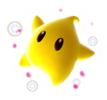 Lumas |
Star children that make their home in the Comet Observatory. Lumas appear in some galaxies to aid Mario, typically by transforming into Launch Stars, Sling Stars, and Pull Stars. Lumas become celestial bodies when they grow up, and which ones they become is dependent on their color. Lumas eat Star Bits and squeal with delight when fed via the Star Pointer. | Comet Observatory, Good Egg Galaxy, Battlerock Galaxy, Bowser's Star Reactor, Bowser Jr.'s Airship Armada, Bowser's Dark Matter Plant, Gateway Galaxy, Dreadnought Galaxy, Bowser's Galaxy Reactor |
 Polari |
An elderly Luma who serves as Rosalina's advisor. He appears within each dome of the observatory and grants access to the map when prompted. He teaches the player how to use the Star Pointer. | Comet Observatory |
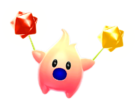 Hungry Lumas |
Big Lumas. The ones on the Comet Observatory transform into galaxies when fed a specified number of Star Bits. When encountered in dome galaxies, they transform into planets. Visiting them triggers a hidden mission. | Comet Observatory, Good Egg Galaxy, Space Junk Galaxy, Battlerock Galaxy, Dusty Dune Galaxy, Sea Slide Galaxy, Toy Time Galaxy, Melty Molten Galaxy |
 Lumalees |
Big Lumas that run Luma Shops. One typically proceeds a boss encounter and transforms into a mushroom of choice in exchange for thirty Star Bits. | Battlerock Galaxy, Ghostly Galaxy, Bowser Jr.'s Airship Armada, Melty Molten Galaxy, Dreadnought Galaxy |
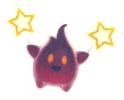 Comet Tico |
A Hungry Luma that is knowledgeable about Prankster Comets. It provides details on these comets to the player when prompted. Alternatively, it can shift where a Prankster Comet appears in exchange for twenty Star Bits. | Comet Observatory |
 Toads |
Denizens of the Mushroom Kingdom. They are mushroom people that come in a variety of colors. Toads are celebrating the Star Festival when Peach is abducted. Pink-capped Toads in red dresses appear in the prologue that look like Toadette. | Castle Gardens, Grand Finale Galaxy |
 The Toad Brigade |
A five-member team of Toads looking for Princess Peach. They travel through space in search of Power Stars aboard their Starshrooms, mushroom-shaped starships built for them by the Lumas. Outside of the red-capped leader and purple-capped mail carrier, the brigade contains three other Toads: a knowledgeable blue Toad who typically provides information on an area of interest; a green Toad who carries a pickaxe and constructs cannons for Mario; and a sleepy yellow Toad. | Comet Observatory, Honeyhive Galaxy, Sweet Sweet Galaxy, Space Junk Galaxy, Hurry-Scurry Galaxy, Bubble Breeze Galaxy, Ghostly Galaxy, Bowser Jr.'s Airship Armada, Freezeflame Galaxy, Dusty Dune Galaxy, Bigmouth Galaxy, Sea Slide Galaxy, Toy Time Galaxy, Sand Spiral Galaxy, Deep Dark Galaxy, Grand Finale Galaxy |
 Toad Brigade Captain |
The captain of the Toad Brigade. This red Toad self-designated himself as the brigade captain and typically sends his teammates into dangerous situations without his direct involvement. According to the blue Toad, the captain is the most cowardly member of the team. | All galaxies that feature the Toad Brigade |
 Mailtoad |
A member of the Toad Brigade who runs a postal service for Mario on the Comet Observatory, delivering mail from Princess Peach or Luigi. He also periodically sends his own letters to the player through the Wii Message Board. When out on missions with the brigade, the Mailtoad is not carrying his satchel and sometimes wears a snorkel. | All galaxies that feature the Toad Brigade |
 Star Bunnies |
Spacefaring rabbits that like to play and typically award Mario a Power Star for catching them. The Star Bunnies of Gusty Garden Galaxy like to garden and are hunted by Undergrunts. Some Star Bunnies are Lumas in disguise. Unlike them, the real rabbits often end their sentences with "boiyoing" or wear vests. | Gateway Galaxy, Bowser Jr.'s Airship Armada, Gusty Garden Galaxy, Gold Leaf Galaxy, Snow Cap Galaxy, Grand Finale Galaxy |
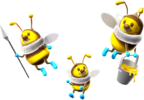 Honeybees |
Bee people that collect honey and teach Mario how to use his Bee form. Most Honeybees are members of the Honeyhive Kingdom and are in the midst of a dispute with Mandibugs. The bees of Gold Leaf Galaxy keep Cataquacks as pets. | Honeyhive Galaxy, Sea Slide Galaxy, Gold Leaf Galaxy, Grand Finale Galaxy |
 Queen Bee |
The ruler of the Honeyhive Kingdom. She has a large body that can be clung to by the player while in their Bee form. When she meets Mario for the first time, she mistakes him for a physician and asks him to take care of an "itchiness" for her. | Honeyhive Galaxy |
 Boards |
Talking boards that explain unique mechanics to Mario, with each board covering a different topic: Gil Board teaches Mario how to Wall Jump; Bill Board teaches him how to use the Rolling Ball; Phil Board teaches him how to use the Bubble; and Jill Board reminds him how to use his Boo form. | Honeyhive Galaxy, Rolling Green Galaxy, Bubble Breeze Galaxy, Gusty Garden Galaxy, Melty Molten Galaxy, Boo's Boneyard Galaxy, Rolling Gizmo Galaxy, Bubble Blast Galaxy, Grand Finale Galaxy |
 Ray |
The manta ray that Mario surfs on during ray surfing. Safely reaching the finish line within a specified time limit awards Mario with a Power Star. | Loopdeeloop Galaxy, Loopdeeswoop Galaxy |
 Penguins |
Flightless birds who love to swim. Some penguins share swimming techniques with Mario when prompted, while others try to play with him. Most penguins are young and slightly shorter than Mario, while the two adult penguins, Coach and Penguru, tower over him. The penguin in Freezeflame Galaxy calls Mario an "old man" and challenges him to a race. | Loopdeeloop Galaxy, Beach Bowl Galaxy, Buoy Base Galaxy, Drip Drop Galaxy, Freezeflame Galaxy, Sea Slide Galaxy, Loopdeeswoop Galaxy, Grand Finale Galaxy |
 Coach |
A big penguin who has a paternal disposition and teaches the young penguins how to swim. Coach is the host of the ray surfing minigame and gives Mario a tutorial on how to move Ray. | Loopdeeloop Galaxy, Beach Bowl Galaxy, Loopdeeswoop Galaxy, Grand Finale Galaxy |
 Penguru |
An elderly penguin who likes to fish. While he oversees young penguins, he prefers spending time by himself. | Drip Drop Galaxy, Bigmouth Galaxy, Sea Slide Galaxy, Grand Finale Galaxy |
 Penguin Racers |
A four-member swimming team. While most penguins are blue, each member of this team is a different color. Mario can compete with them when he talks to the red-colored leader. This penguin awards Mario a Power Star for outswimming them. | Sea Slide Galaxy, Grand Finale Galaxy |
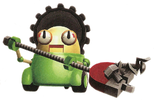 Gearmos |
Maintenance robots. Gearmos can be found upkeeping battle stations affiliated with the Topman Tribe, but they themselves are not enemies. The Gearmos of Toy Time Galaxy teach the player how to use their Spring form. An overworked Gearmo hosts Bob-omb Blasting, while another helps maintain the Comet Observatory's Engine Room. One Gearmo in Battlerock Galaxy refers to herself as an "iron old lady". | Comet Observatory, Battlerock Galaxy, Buoy Base Galaxy, Toy Time Galaxy, Dreadnought Galaxy, Grand Finale Galaxy |
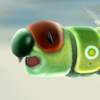 Worm |
A giant caterpillar with its own gravitational pull that enables Mario to walk along its body. It lives inside one of the apple-shaped planets in Gusty Garden Galaxy, where Ground Pounding a stump forces the worm to the surface and tunnel into the next nearest planet. This creates a permanent bridge between them. | Gusty Garden Galaxy |
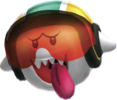 Spooky Speedster |
An Atomic Boo who challenges Mario to a race when prompted. He begrudgingly gives Mario a Power Star if he reaches the finish line before him. When Mario races him in "A Very Spooky Sprint", he must use Pull Stars to reach the goal. In "Racing the Spooky Speedster", he is in his Boo form. | Ghostly Galaxy, Boo's Boneyard Galaxy |
 Guppy |
An orca who bullies the Penguin Racers. He only relents if Mario can complete his eight-ring swim challenge, as well as award him a Power Star. Unlike most other characters, Guppy cannot be jumped on and knocks Mario back if touched, although this does not cause damage. | Sea Slide Galaxy, Deep Dark Galaxy |
 Cosmic Mario |
An entity that resembles Mario and mirrors his abilities. He challenges him to a footrace to a Power Star when a Cosmic Comet is in orbit during Mario's playthrough. Making contact with Cosmic Mario during the race makes him release Star Bits. | Honeyhive Galaxy, Freezeflame Galaxy, Gold Leaf Galaxy, Sea Slide Galaxy |
 Cosmic Luigi |
An entity that resembles Luigi. Like Cosmic Mario, he only appears when a Cosmic Comet is in orbit during Luigi's playthrough. Unlike Cosmic Mario, Cosmic Luigi makes more frequent use of shortcuts and Long Jumps, making him a more challenging opponent. | Honeyhive Galaxy, Freezeflame Galaxy, Gold Leaf Galaxy, Sea Slide Galaxy |
Enemies and obstacles
Enemies
Roughly ninety enemies are in Super Mario Galaxy. Most enemies drop coins if stomped on or Star Bits if spun into. If an enemy actively tracks Mario,[note 1] it will usually stop moving for a moment after successfully causing damage, allowing the player time to recover before responding. Some enemies, such as Piranha Plants, laugh at Mario when they successfully land a hit.
About fifty of the enemies and varieties in Super Mario Galaxy are wholly new to the series. Some of them are incorporated into subsequent Super Mario games or have inspired staple elements. Notable groups include: octopus enemies that spit rocks; spinning top-like enemies; and stationary beamers that discharge rings of electricity. Some of the new enemies are derivative of creatures that appeared in earlier Super Mario games in both design and behavior. Some of them even resemble recurring enemies in The Legend of Zelda series, such as bats (which resemble Keese) and the octopus enemies (which resemble Octoroks). The Japanese name for Rocto directly derives from "Octorok".
Super Mario Galaxy makes use of the Super Mario series' back catalog of enemies. This game represents the first instance that some of these enemies were ever integrated into a 3D platformer. There are enemies in Super Mario Galaxy that, with the exception of rereleases or remakes, never appeared outside of their debut titles. The enemies that are incorporated contrast greatly with the ones in the previous 3D Super Mario game, a title that made a conservative use of past enemies and introduced ones that largely never appeared again.
Sorting the "galaxy" columns organizes them by occurrence in-game, not alphabetically.
| Name | Description | Galaxies | Spoils | New | |
|---|---|---|---|---|---|
| First | Last | ||||
 Goomba |
Squat mushroom creatures that chase Mario when he is in their line of sight. A Goomba is defeated when stomped. Spinning or shooting one with a Star Bit knocks it over and makes it spin like a top, leaving it vulnerable to being kicked. | Gateway Galaxy | Rolling Gizmo Galaxy | Template:Chart icon×1 Template:Chart icon×3 Template:Chart icon×1 |
— |
 Grand Goomba |
A giant Goomba. It is defeated only when spun and kicked. | Gateway Galaxy | Template:Chart icon×1 | — | |
 Micro Goomba |
Little Goombas. Like normal-sized ones, they charge towards Mario. They are defeated when spun. | Gateway Galaxy | Rolling Gizmo Galaxy | Template:Chart icon×1 | — |
 Pumpkinhead Goomba |
Slow-moving Goombas with Jack-o'-lanterns covering their heads. A Pumpkinhead Goomba sometimes drops a blue flame behind it that burns Mario on contact. Ground Pounding one defeats it. Spinning one breaks the pumpkin and reverts it into a normal Goomba. | Ghostly Galaxy | Template:Chart icon×1 | Template:Chart icon | |
 Goombeetle |
Helmeted Goombas that cannot be stomped. Spinning one flips it upside down, exposing its vulnerable underside. | Bowser Jr.'s Robot Reactor | Dreadnought Galaxy | Template:Chart icon×1 | Template:Chart icon |
 Meteor |
Fiery space rocks. Bowser shoots them from his mouth to destroy the big staircase in Bowser's Star Reactor, and Bowser Jr. fires them from the cannons in his airship. They otherwise occur raining from the sky. | Gateway Galaxy | Bowser's Galaxy Reactor | None | Template:Chart icon |
 Electrogoomba |
Goomba-like octopus enemies. An Electrogoomba shuffles side to side along a set path and keeps its eyes locked onto Mario when he is near. When in close proximity, it attempts to strike him with the hair-like appendage on its head. Electrogoombas are defeated when stomped or spun. | Good Egg Galaxy | Toy Time Galaxy | Template:Chart icon×1 Template:Chart icon×3 |
Template:Chart icon |
![Artwork of a Rocto from Super Mario Galaxy.[1] It has subsequently been used for Super Mario Galaxy 2. This specific image was scanned from its guidebook by Shokora (talk).](https://mario.wiki.gallery/images/thumb/9/94/SMG_Octopus_Artwork.png/72px-SMG_Octopus_Artwork.png) Rocto |
Big octopuses that sit in barrels. Roctos spit coconuts[note 2] and flaming rocks at Mario. The coconuts can be ricocheted back with a well-timed spin. This is the only way to defeat a Rocto. | Good Egg Galaxy | Dreadnought Galaxy | None | Template:Chart icon |
 Octoguy |
Red octopuses that spit rocks. Octoguys shuffle backward from Mario when approached and only stop to attack Mario. One is defeated when stomped or spun. They usually occur in groups. | Honeyhive Galaxy | Deep Dark Galaxy | Template:Chart icon×1 Template:Chart icon×3 |
Template:Chart icon |
 Slurple |
Leech-like octopuses. They latch onto Mario and gradually deplete his life meter. Spinning defeats them. | Good Egg Galaxy | Sea Slide Galaxy | Template:Chart icon×1 | Template:Chart icon |
 Ruby Rock |
Boulders with red gems in their center. Ruby Rocks roll around in circles or off the sides of platforms, damaging Mario on contact. Spinning into the gem of one breaks it. There are caves that indefinitely release Ruby Rocks in several galaxies. | Good Egg Galaxy | Melty Molten Galaxy | Template:Chart icon×7 | — |
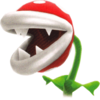 Piranha Plant |
Carnivorous plants that try to bite Mario when near and laugh if they land a hit. They idly hold their heads skyward like normal flowers until they are approached. Piranha Plants are defeated when stomped or spun, and stunned when struck by a Star Bit. Defeating a Piranha Plant sometimes causes a Sproutle Vine to erupt from the ground. | Good Egg Galaxy | Gold Leaf Galaxy | Template:Chart icon×1 Template:Chart icon×3 Template:Chart icon×1 |
— |
 Spiny Piranha Plant |
Large Piranha Plants that slam their heads into the ground. Spinning one stuns it and leaves to vulnerable to being stomped. | Good Egg Galaxy | Gusty Garden Galaxy | Template:Chart icon×7 Template:Chart icon×1 |
Template:Chart icon |
 Tracks |
Invisible purse-like creatures. Tracks are only visible when the stop moving. They are otherwise only perceptible by tracking their footsteps. Defeating one awards Mario with a large number of Star Bits. | Good Egg Galaxy | Gateway Galaxy | Template:Chart icon×20 | Template:Chart icon |
 Prickly plant |
Plants with damaging, needle-like flowers. One is destroyed only through the use of projectiles, like rubbery bulbs. | Good Egg Galaxy | Bowser's Galaxy Reactor | Template:Chart icon×1 Template:Chart icon×3 Template:Chart icon×1 |
Template:Chart icon |
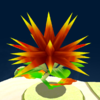 Giant prickly plant |
Giant prickly plants damage Mario on contact and are destroyed only through indirect means. Airborne ones appear in Gusty Garden Galaxy. | Good Egg Galaxy | Dusty Dune Galaxy | Template:Chart icon×7 Template:Chart icon×1 |
Template:Chart icon |
 Pokeynut |
Giant Pokeys. A Pokeynut slam its body forward to strike Mario. It falls apart when struck by a coconut[note 2], causing its head to fall and become embedded in the surrounding sand. Stomping the head defeats it. | Good Egg Galaxy | Dusty Dune Galaxy | Template:Chart icon×1 | — |
Pokeyplant |
A red Pokey. It shimmies away from Mario while attempting to slam him. The Pokeyplant can be defeated by destroying each of its body segments, or by stomping on its head from above. If reduced to just a head, it attempts to flee the area. | Dusty Dune Galaxy | Template:Chart icon×7 | Template:Chart icon | |
 Pokey Head |
Green Pokeys. They are buried with only their flowers visible. When approached by Mario, they burst out of the ground and start hopping towards him. A Pokey Head bounces in place if it successfully strikes Mario. They are defeated when stomped or spun. | Gusty Garden Galaxy | Dusty Dune Galaxy | Template:Chart icon×1 Template:Chart icon×3 |
— |
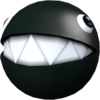 Chomp |
Rolling metal enemies. They bark when in close proximity. Chomps are defeated only when struck by Rainbow Mario. | Good Egg Galaxy | Ghostly Galaxy | Template:Chart icon×7 | — |
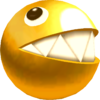 Golden Chomp |
A Chomp made of gold. It is destroyed by Mario only if he collides with it in his Rainbow form. | Gusty Garden Galaxy | Template:Chart icon×1 | Template:Chart icon | |
 Mini Chomp |
Little Chomps that roll out of doghouses. Mini Chomps are destroyed only when all nearby Flipswitch Panels are activated. | Dreadnought Galaxy | Template:Chart icon×3 | Template:Chart icon | |
 Bullet Bill |
Missiles fired from Bill Blasters. Bullet Bills directly target Mario when he is within their proximity. Mario can lure Bullet Bills towards cages and fences to break them. Their eyes flash red and their bodies twirl when they lock onto Mario. | Good Egg Galaxy | Bubble Blast Galaxy | None | — |
 Banzai Bill |
Slow-moving missiles. Their line of trajectory is fixed in one direction, and they slowly rotate as they move. | Bowser's Galaxy Reactor | None | — | |
 Torpedo Ted |
Underwater missiles. Their eyes flash red and they home in on Mario when he is in close proximity. They can be lured towards cages to break them. | Buoy Base Galaxy | Drip Drop Galaxy | None | — |
 Lava Bubble |
Floating drops of lava. Lava Bubbles appear during the battle with King Kaliente. Shooting one with a Star Bit defeats it. They otherwise burnout and disappear on their own. | Good Egg Galaxy | Melty Molten Galaxy | Template:Chart icon×1 | — |
 Flipbug |
Insect enemies that eat bees. Flipbugs attempt to flee from Mario when he is near, ultimately tiring out and collapsing upside-down on the ground. If spotted in his Bee form, they chase him. | Honeyhive Galaxy | Gold Leaf Galaxy | Template:Chart icon×1 Template:Chart icon×3 |
Template:Chart icon |
 Mandibug |
Big stink bug enemies. Mandibugs charge at Mario after making visual contact, snapping their jaws. They are defeated when Ground Pounded. One trembles if Mario stands on its back, but eventually shakes him off. | Honeyhive Galaxy | Gold Leaf Galaxy | Template:Chart icon×3 | Template:Chart icon |
 Wiggler |
Caterpillars that walk around in circles. Performing a Ground Pound on nearby earth or directly spinning a Wiggler flips it onto its back. If it is not defeated within five seconds, it becomes angry and uprights itself. An enraged Wiggler is faster and cannot be harmed. It calms down after a few seconds. Ground Pounding a Wiggler defeats it in a single blow. | Honeyhive Galaxy | Gold Leaf Galaxy | Template:Chart icon×7 | — |
 Water Shooter |
Mounted nozzles that shoot Water Balls over great distances. A ball traps Mario if he is within its trajectory and carries him with it. He is freed if he spins. | Honeyhive Galaxy | Sand Spiral Galaxy | Template:Chart icon | Template:Chart icon |
 Fire Shooter |
Mounted flamethrowers that shoot streams of fire. The flames recede in set intervals that can be timed. | Bowser's Star Reactor | Bubble Blast Galaxy | Template:Chart icon | Template:Chart icon |
 Spring Vault |
Topman-like beamers. Jumping on one's head launches Mario high into the air. | Flipswitch Galaxy | Dreadnought Galaxy | None | Template:Chart icon |
 Sentry Garage |
A Spring Vault that expels Topminis. Its head bounces Mario into the air. | Buoy Base Galaxy | None | Template:Chart icon | |
 Spoing |
Spiders that hop up and down. A Spoing is stunned when shot by a Star Bit. It is defeated when stomped. Spoings stop to laugh if they strike Mario. | Space Junk Galaxy | Ghostly Galaxy | Template:Chart icon×1 Template:Chart icon×3 |
Template:Chart icon |
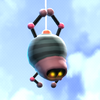 Sprangler |
Spiders hanging from silk. Spranglers sway back and forth to strike Mario. Spinning one stuns it. It otherwise can be stomped. | Ghostly Galaxy | Sea Slide Galaxy | Template:Chart icon×1 Template:Chart icon×3 |
Template:Chart icon |
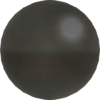 Zap Ball |
Floating, charged orbs that travel in circles and damage Mario on contact. Zap Balls typically occur in pairs. | Space Junk Galaxy | Toy Time Galaxy | Template:Chart icon | — |
 Amp |
Smiling, electrical orbs. They typically travel in circular patterns. | Buoy Base Galaxy | Bubble Blast Galaxy | Template:Chart icon | — |
 Magikoopa |
Robed Koopas that teleport. Magikoopas toss magical fireballs at Mario with their wand, which they also use to block shot Star Bits. The Magikoopa in one of the opening cutscenes is localized into English as "Kamek". | Space Junk Galaxy | Sand Spiral Galaxy | Template:Chart icon×1 | — |
 Koopa Troopa (Green) |
Green-shelled turtles. Koopa Troopas walk back and forth in straight lines. One retreats into its shell when stomped, allowing Mario to pick it up. | Space Junk Galaxy | Bigmouth Galaxy | Template:Chart icon×1 | — |
 Koopa Troopa (Red) |
A red-shelled Koopa Troopa that walks around in a circle. Jumping on it gives Mario access to a Red Shell. | Sea Slide Galaxy | Template:Chart icon×1 | — | |
 Dry Bones |
Undead Koopa Troopas. Dry Bones chase down and tackle Mario on sight. If one is stomped, spun, or hit with a shell, it crumbles into a pile of bones, but reassembles after a few seconds. There are three ways to truly defeat a Dry Bones: by luring a Bullet Bill into it, by running into it as Rainbow Mario; or by luring it into quicksand. | Dusty Dune Galaxy | Bowser's Galaxy Reactor | Template:Chart icon×3 | — |
 Spiky Topman |
Top enemies. Spiky Topmen do not directly harm Mario, but they can knock him into hazards or off platforms. The spike on one's head protects it from being stomped and damages Mario on contact. Spiky Topmen are defeated if knocked into an electric rail or off the side of a platform. | Battlerock Galaxy | Dreadnought Galaxy | Template:Chart icon×1 | Template:Chart icon |
 Spring Topman |
Green Topmen. Stomping a Spring Topman stuns it and allows Mario to use it like a springboard. Some Spring Topmen produce Topminis. | Buoy Base Galaxy | Dreadnought Galaxy | None | Template:Chart icon |
 Topmini |
Little Topmen. Topminis cannot damage Mario and are immediately defeated when spun. There are small portals that continuously produce Topminis. | Buoy Base Galaxy | Dreadnought Galaxy | Template:Chart icon×1 | Template:Chart icon |
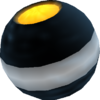 Cannonball |
Ammunition shot from enemy cannons. They slowly travel in straight lines and burst when they make contact with Mario. Shooting a cannonball with a Star Bit destroys it. | Battlerock Galaxy | Dreadnought Galaxy | Template:Chart icon×1 | — |
 Space Mine |
Midair Mikey Mines. Most are inert, but some move along purple streaks of light. A Space Mine explodes when touched, causing damage. Shooting one with a Star Bit destroys it. | Battlerock Galaxy | Bubble Blast Galaxy | None | Template:Chart icon |
 Mikey Mine |
Naval mines that bob up and down on chains. Mikey Mines keep their eyes shut unless Mario is in close proximity. They regenerate after detonating. | Deep Dark Galaxy | None | Template:Chart icon | |
 Bob-omb |
Walking bombs. Bob-ombs actively pursue Mario until they explode. Stomping one disengages it, turning it into a grabbable bomb. | Battlerock Galaxy | Rolling Gizmo Galaxy | None | — |
 Monty |
Moles that sit in hatches and throw wrenches at Mario. One retreats into the hatch when approaches. Ground Pounding nearby earth stuns Montys, leaving them open to attack. They are also stunned when struck by Star Bits. | Battlerock Galaxy | Dreadnought Galaxy | Template:Chart icon×1 Template:Chart icon×3 |
Template:Chart icon |
 Undergrunt |
Burrowing Montys. Undergrunts leave trails of disturbed dirt as they dig. Ground Pounding nearby earth forces them to the surface, dazed and vulnerable. Their spiked helmets protects them from stomps. The helmets protrude from the ground as the Undergrunts burrow, allowing one to track their movements. | Gusty Garden Galaxy | Gold Leaf Galaxy | Template:Chart icon×3 | Template:Chart icon |
 Sentry Beam |
Hovering beamers that fire lasers at Mario when he is close. Standing on top of a Sentry Beam temporarily prevents it from firing. | Battlerock Galaxy | Toy Time Galaxy | Template:Chart icon | Template:Chart icon |
 Thwomp |
Grimacing stones. Thwomps suspend themselves above ground and periodically slam into the earth below. Crushing Mario fully depletes his life meter. The tops and sides of a Thwomp can be used as platforms and walls. Slightly smaller ones appear in the 2D sections of several galaxies. | Bowser's Star Reactor | Bowser's Galaxy Reactor | Template:Chart icon | — |
 Gringill |
Conger eel enemies. Gringills lunge at Mario if he approaches the mouth of their caves. They can only be defeated by projectile shells. In some galaxies, Gringills occur swimming in open water. | Beach Bowl Galaxy | Bigmouth Galaxy | Template:Chart icon×7 | Template:Chart icon |
 Giant Gringill |
Large Gringills restricted to underwater caves. They snap at Mario when approached. Giant Gringills react slower than the normal-sized ones. | Beach Bowl Galaxy | Deep Dark Galaxy | Template:Chart icon×1 | Template:Chart icon |
 Urchin |
Sea creatures with protractible spines. Urchins roll towards Mario when in close proximity. They are damaged only by shells and fireballs. | Beach Bowl Galaxy | Deep Dark Galaxy | Template:Chart icon×5 | — |
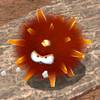 Ground Urchin |
Red Urchins found in warm areas. When Mario draws near, they protract their spines and roll towards him. Ground Urchins can only be defeated by fire and lava. There is a box-like stone sculpture in Freezeflame Galaxy that continuously expels Ground Urchins. | Freezeflame Galaxy | Deep Dark Galaxy | Template:Chart icon×5 | Template:Chart icon |
 Clampy |
A giant clam that opens and closes its mouth. Star Chips or coins can be found inside it. Snapping shut with Mario inside damages him. | Beach Bowl Galaxy | Template:Chart icon | Template:Chart icon | |
 Bat |
Hog-nosed bats that roost in caves. They swoop down to attack Mario. A bat stops to laugh when it lands a hit. Stomping or spinning one defeats it. | Beach Bowl Galaxy | Toy Time Galaxy | Template:Chart icon×1 Template:Chart icon×3 |
Template:Chart icon |
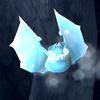 Ice bat |
White bats. Making direct contact freezes Mario. They are defeated only by fire. | Freezeflame Galaxy | Template:Chart icon×3 | Template:Chart icon | |
 Cataquack |
Duck-like creatures that toss Mario high into the air. Cataquacks immediately charge towards Mario after making visual contact. They otherwise idly walk in circles or sleep on the ground. Spinning one or performing a Ground Pound dazes it. They drown if led into water. | Beach Bowl Galaxy | Gold Leaf Galaxy | None | — |
 Tox Box |
Stone boxes that roll around in set trajectories. Tox Boxes are the same width of the paths they travel, making them difficult to avoid. One of their sides is open and can be safely stood under. | Beach Bowl Galaxy | Toy Time Galaxy | Template:Chart icon | — |
 Boo |
Ghost enemies. Boos pursue Mario when his back is turned towards them. If Mario looks directly at one, it stops moving and shields its eyes. Spinning one shifts its position and forces it through nearby walls, but it is undamaged. Boos are weak only to light – including the headlamp of the Toad Brigade Captain. Some Boos are found underwater. Mario can transform into one via the Boo Mushroom, which causes nearby Boos to become enamored and give chase. | Ghostly Galaxy | Sand Spiral Galaxy | Template:Chart icon×1 Template:Chart icon×1 |
— |
 Atomic Boo |
A large Boo. It is defeated only with a light source. The Spooky Speedster is an Atomic Boo. | Deep Dark Galaxy | Template:Chart icon×1 | — | |
 Bomb Boo |
Explosive Boos that pursue Mario on sight. Unlike normal Boos, Bomb Boos do not cower when Mario looks at them. When spun, Mario grabs onto a Bomb Boo's tongue and swings it like a lasso. It detonates if it is swung into an object or wall. If Mario does not release the Bomb Boo, it is pulled in closer and damages him. Bomb Boos are conjured by Bouldergeist and can destroy the boss's stone armor. | Ghostly Galaxy | None | Template:Chart icon | |
 Blooper |
Underwater squids. Bloopers swim erratically when approached by Mario to strike him. Spinning one or striking it with a shell defeats it. They release a cloud of ink when defeated. | Buoy Base Galaxy | Deep Dark Galaxy | Template:Chart icon×3 | — |
 Bomp |
Stones that shift in and out of walls. They cannot damage Mario directly, but they are positioned to push him off of platforms and solid ground. The tops of their bodies can be stood on. | Buoy Base Galaxy | Freezeflame Galaxy | Template:Chart icon | — |
 Ball Beamer |
Yellow beamers that discharge wide-range shockwaves on the surface of spherical planets. The shockwaves damage Mario on contact and are discharged in consistent, three-part intervals that can be timed. Most Ball Beamers lack interactive components, but there is one in Buoy Base Galaxy with a gold screw on its top. Spinning it disengages the Ball Beamer and opens up the metal planet it is fastened to. | Buoy Base Galaxy | Deep Dark Galaxy | Template:Chart icon | Template:Chart icon |
 Pulse Beam |
Spiked beamers that discharge shockwaves. One damages Mario when touched. | Toy Time Galaxy | Dreadnought Galaxy | Template:Chart icon | Template:Chart icon |
 Spiny Cheep-Cheep |
Porcupinefish enemies that protract their spines and charge towards Mario on sight. They are only found within sunken treasure chests. | Drip Drop Galaxy | Template:Chart icon×7 | — | |
 Cheep Cheep |
Pudgy red fish. Underwater, they passively swim in circles. On land or shallow water, they bounce around in a set trajectory. They are defeated when stomped or spun. | Deep Dark Galaxy | Template:Chart icon×1 Template:Chart icon×3 |
— | |
 Ice Bubble |
Floating ice enemies that freeze Mario on contact. Spinning an Ice Bubble neutralizes its icy cloud and grounds it, leaving it vulnerable to being kicked. Neutralized Ice Bubbles propel themselves towards the nearest pools of freezing water to restore their clouds. | Freezeflame Galaxy | Toy Time Galaxy | Template:Chart icon×1 | Template:Chart icon |
 Li'l Cinder |
Floating fire enemies that burn Mario on contact. Li'l Cinders otherwise behave like Ice Bubbles. Grounded Li'l Cinders hop towards the nearest lava to reignite. | Freezeflame Galaxy | Melty Molten Galaxy | Template:Chart icon×1 | Template:Chart icon |
 Cluckboom |
Plurp-like enemies that lay explosive eggs. Cluckbooms fly in set paths, fluttering back and forth. One falls to the ground when shot be a Star Bit, leaving it open to attack. | Dusty Dune Galaxy | Template:Chart icon×1 Template:Chart icon×3 |
Template:Chart icon | |
 Bone Twister |
Whirlwinds that move along set paths. Bone Twisters trap Mario on contact, but this does not damage him. Mario is propelled high into the air like a bamboo-copter if he spins while inside. Some Bone Twisters carry jagged rocks that damage Mario if he makes contact. | Dusty Dune Galaxy | Template:Chart icon | Template:Chart icon | |
 Crabber (Blue) |
Sidestepping crabs that scuttle away from Mario. Crabbers have hard shells that protect them from stomps and spins head-on, but their fleshy rears are exposed and can be struck. Blue Crabbers bury themselves underground in an attempt to escape and resurface shortly after. | Dusty Dune Galaxy | Bigmouth Galaxy | Template:Chart icon×1 | Template:Chart icon |
 Crabber (Red) |
Red Crabbers actively pursue Mario but move slowly. | Dusty Dune Galaxy | Bigmouth Galaxy | Template:Chart icon×3 | Template:Chart icon |
 Mecha-Bowser |
Mechanical Koopas that breathe fire. Spinning Mecha-Bowsers swing their heads back and delay their fire attack. They are defeated when Ground Pounded. | Toy Time Galaxy | Dreadnought Galaxy | Template:Chart icon×1 | — |
 Bonefin |
Undead sharks. They appear alongside Kingfin, who summons them from a hydrothermal vent as he accumulates damage. Bonefins lock onto Mario when he is near. Striking one with a shell defeats it, as does leading it to the water's surface defeats it. All Bonefins disappear when Kingfin is defeated. | Bonefin Galaxy | Template:Chart icon×7 | Template:Chart icon | |
 Jammyfish |
Jellyfish that swim in schools along set paths. They damage Mario on contact but do not actively pursue him. | Deep Dark Galaxy | Bigmouth Galaxy | Template:Chart icon×1 | Template:Chart icon |
 Jam-o'-War |
Large Jammyfish that idly float in place and electrocute Mario when touched. Striking a Jam-o'-War with a shell twice defeats it. The first strike turns it green. | Deep Dark Galaxy | Bigmouth Galaxy | Template:Chart icon×1 | Template:Chart icon |
Obstacles
| Name | Description | Galaxies | ||
|---|---|---|---|---|
| First | Last | |||
 Banzai Bill Cannon |
Giant cannons that shoot Banzai Bills. | Bowser's Galaxy Reactor | ||
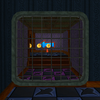  Bars / Crystal |
Thin barriers that can only be phased through by Boo Mario while he is invisible. | Ghostly Galaxy | Boo's Boneyard Galaxy | |
 Bill Blaster |
Cannons that shoot Bullet Bills. Bill Blasters are mounted onto the surface of planets, integrated into the walls of terrain, and attached to the sides of airships. Many Bill Blasters are built into the body of Megaleg. The cannons do not shoot more than one Bullet Bill at a time. | Good Egg Galaxy | Bubble Blast Galaxy | |
Black hole |
Bottomless voids with their own gravity. Mario is pulled into black holes if he gets too close and lose a life. They exist in the center of several spherical planets and function similarly to bottomless pits. | Good Egg Galaxy | Bubble Blast Galaxy | |
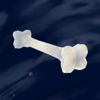 Bone[27] |
Floating barriers in courses where Mario races the Spooky Speedster. They can obstruct Mario's path. Most bones have simple designs and are purely obstructive, but some are ribs that shift up and down. Some are encased in meat that bounce Mario on contact. Few are cackling skulls. | Ghostly Galaxy | Boo's Boneyard Galaxy | |
 Bramble |
Thick, thorn-covered vines that damage Mario on contact. | Gusty Garden Galaxy | ||
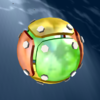 Bumper |
Floating objects that bounce Mario on contact. | Bubble Blast Galaxy | ||
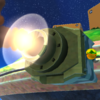 Burner |
Cannons that create small explosions. It takes a few seconds for them to charge up. | Good Egg Galaxy | ||
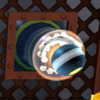 Cannon |
Enemy cannons that shoot cannonballs. They are built into the sides of terrain. Cannons fire continuously in set intervals that can be timed. | Battlerock Galaxy | Dreadnought Galaxy | |
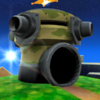 Chomp box |
Giant turrets that release Chomps. Little doghouse-like Chomp boxes release Mini Chomps. | Good Egg Galaxy | Dreadnought Galaxy | |
 Crushing pillar[28] |
Walls that shift up and down. Mario loses a life if crushed. | Battlerock Galaxy | Dreadnought Galaxy | |
 Dark matter |
Dark matter disintegrates Mario on contact, costing him a life. | Bowser's Dark Matter Plant | ||
 Electric Ball[29] |
Metal orbs that spin around the sides of disc-shaped planetoids. They are similar to Amps and electrocute Mario on contact. | Battlerock Galaxy | Dreadnought Galaxy | |
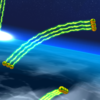 Electric rail |
Electric barriers. They emit either green or red electricity and move horizontally in some galaxies. Spiky Topmen are defeated when spun into electric rails. This is also the only way to damage Topmaniac. | Good Egg Galaxy | Bubble Blast Galaxy | |
 Eye Beamer |
Beamers with flat backs that are suspended above ground. Eye Beamers fire electric beams that damage Mario on contact. Some move while others are stationary. Their backs are nondamaging and can be used as platforms. | Dusty Dune Galaxy | Dreadnought Galaxy | |
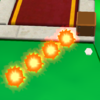 Fire Bar |
Rotating bars of fireballs that burn Mario on contact. | Battlerock Galaxy | Sling Pod Galaxy | |
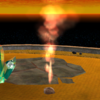 Fire geyser |
Hot steam forced from the ground. Making contact burns Mario. | Space Junk Galaxy | Bowser's Galaxy Reactor | |
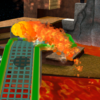 Fireball |
Trailing balls of lava. They move slowly and burn Mario on contact. They typically move in arches. | Freezeflame Galaxy | Bowser's Galaxy Reactor | |
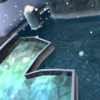 Freezing water |
Water so frigid that it gradually depletes Mario's life meter if he tries to swim through it. When Mario enters freezing water, the screen is briefly disrupted by a static-like visual effect, readily differentiating it from normal bodies of water. During "Hot and Cold Collide", this water rises and falls on one of the planets. | Freezeflame Galaxy | ||
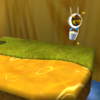 Honey |
A sweet substance collected by Honeybees. Honey reduces Mario's movement the same way mud does. | Honeyhive Galaxy | ||
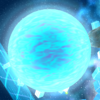 Ice sphere |
An ice planet. The surface is so cold that direct contact makes Mario leap as if he was burned and reduces his life meter. | Bowser's Galaxy Reactor | ||
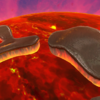 Lava |
Direct contact with lava burns Mario and makes him bounce into the air with his hands on his rear. Some small planets are completely covered in it. On others, the lava rises and falls like the tide. | Good Egg Galaxy | Bowser's Galaxy Reactor | |
Lava Geyser |
Lava Geysers rise and fall in set intervals that can be timed. A rise is always proceeded by rapid bubbling on the lava's surface. | Freezeflame Galaxy | Bowser's Galaxy Reactor | |
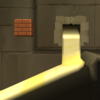 Moving sand |
Rapidly flowing sand. Mario can stand on it but is brought down his intended trajectory and potentially into hazards. During "Treasure of the Pyramid", the sand rises inside of a pyramid. | Dusty Dune Galaxy | ||
 Mud |
Mario's movement speed and jump height is reduced while he is in mud. This puts him at potential risk if dangerous enemies are nearby. | Good Egg Galaxy | ||
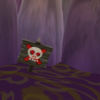 Poison swamp |
Poisonous sludge. If Mario falls into the poison, he sinks and loses a life. | Bubble Breeze Galaxy | Toy Time Galaxy | |
 Quicksand |
Shifting sands. It functions identically to poison in that it rapidly causes Mario to sink and lose a life. | Dusty Dune Galaxy | Bowser's Galaxy Reactor | |
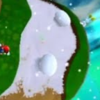 Snow |
Powdery snow that reduces Mario's speed when walked through. The snow is cleared when the Star Pointer is waved over it or with fireballs. | Snow Cap Galaxy | ||
 Spikes |
Spikes damage Mario on contact, and generally appear attached to terrain and shifting objects. Lifts with spikes embedded into their sides appear in a few galaxies, and bergy bits in "Wall Jumping up Waterfalls" are covered in ones made of ice. | Good Egg Galaxy | Toy Time Galaxy | |
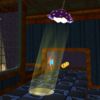 Spotlight |
The light defeats enemy Boos, but it also forces Boo Mario back into his normal form. | Ghostly Galaxy | Deep Dark Galaxy | |
 Spring |
Floating springs in narrow caverns. They knockback Boo Mario on contact but do not cause damage. | Boo's Boneyard Galaxy | ||
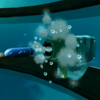 Torpedo tube |
Underwater cannons that shoot Torpedo Teds. | Buoy Base Galaxy | ||
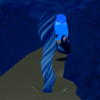 Whirlpool |
Swirling vortices of water. Contact pushes Mario and temporarily stuns him, but it does not cause damage. | Sea Slide Galaxy | Bigmouth Galaxy | |
Bosses
Bosses are listed in the order that they are first encountered.
| Name | Description | Missions |
|---|---|---|
 Dino Piranha |
A Piranha Plant boss with a clubbed tail. It charges after Mario when he is in its line of sight. Spinning into its club knocks it at its head, damaging it. It charges faster after the first strike. | Dino Piranha, Dino Piranha Speed Run |
 King Kaliente |
A giant Rocto that sits in lava. He shoots coconuts[note 2] and flaming rocks at Mario. Spinning into a coconut sends it back and damages him. He starts to parry these attacks as the fight progresses. | King Kaliente's Battle Fleet |
 Mandibug Stack |
A Mandibug that carries its child on its back. Both can be defeated by performing a Ground Pound. Defeating the child angers the parent and makes it harder to strike. | Trouble on the Tower |
 Bugaboom |
A giant, winged Mandibug that tries to bite Mario with its jaws and can be damaged with a Ground Pound. Bugaboom takes flight after being struck once and starts releasing explosive droppings as it flies. | Big Bad Bugaboom |
 Megaleg |
A giant robot. Its legs are covered with gravitational panels that enable Mario to walk up its body. Bill Blasters are built into its body. A Grand Star is caged on its head that can be freed with a lured Bullet Bill. | Megaleg's Moon |
 Kamella |
A Magikoopa boss. She launches magical fireballs and Green Shells from her wand. Striking her with shells is the only way to damage her. She starts to erratically teleport as the fight progresses. | Kamella's Airship Attack, The Underground Ghost Ship, Ghost Ship Daredevil Run |
 Tarantox |
A giant spider cocooned in silk. The green orbs covering its body are its weak points, which Mario can damage by launching himself at them with Sling Pods. It spits acid after being hit once. | Tarantox's Tangled Web |
 Topmaniac |
A large Topman with serrated edges. Jumping on its head makes the blades retract, allowing Mario to safely spin it into an electric rail. | Topmaniac and the Topman Tribe, Topmaniac's Daredevil Run, Revenge of the Topman Tribe, Topman Tribe Speed Run |
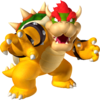 Bowser |
The fire-breathing king of Koopas. He launches himself to the sky and back to generate shockwaves. Luring him above a glass panel causes him to crash through and burn his tail on lava. This leaves him vulnerable to a spin attack. He can conjure stone armor and roll like a Ruby Rock. He refers to Mario as his "archenemy".[30] | The Fiery Stronghold, Darkness on the Horizon, The Fate of the Universe |
Bouldergeist |
A ghost covered in rocks. It launches rocks and erects stone spikes from the ground to damage Mario. Attacking it with Bomb Boos destroys its armor and leaves it vulnerable to attack. During the second phase, it constructs giant hands to attack Mario and protect its body. It is the one who kidnaps Luigi.[24] | Beware of Bouldergeist, Bouldergeist's Daredevil Run |
 Bowser Jr. |
Bowser's son. He rides a miniature airship that fires Bullet Bills and cannonballs at Mario. Magikoopas aide Bowser Jr. during the fight. Throwing shells at the airship damages it and eventually makes it sink. Bowser Jr. otherwise has a recurring story presence throughout the game. | Sinking the Airships |
 Major Burrows |
A giant Undergrunt chasing a Star Bunny. He burrows towards Mario before bursting from the ground with swiping claws. Performing a Ground Pound on the earth when his head is exposed forces him to the surface and leaves him vulnerable to a spin attack. | The Dirty Tricks of Major Burrows, Major Burrows's Daredevil Run |
 Baron Brrr |
A big Ice Bubble. He fires ice balls that freeze Mario on contact. If close, he thrusts himself downward and generates a freezing shockwave. Being close to the ground leaves him vulnerable to being spun, which extinguishes his icy aura. | The Frozen Peak of Baron Brrr |
 Water Bazooka |
Blue rotating cannons operated by Undergrunt Gunners. They fire drops of water that trap Mario on contact. The glass-encased cockpit is the weak point. | When It Rains, It Pours, Bubble Blastoff |
 Mecha-Bowser |
An enormous robot modeled after Bowser. Gearmos are trapped inside of its mouth. To free them and destroy the robot, the stack of stone wheels on top of its head must be Ground Pounded. | Heavy Metal Mecha-Bowser |
 Electric Bazooka |
A yellow cannon operated by an Undergrunt Gunner. This one shoots balls of electricity that home-in on Mario. | Bouncing Down Cake Lane |
 Kingfin |
A massive shark that is guarded by a school of Bonefins. It is vulnerable to shells. As it swims, it destroys underwater pillars. It does not actively pursue Mario, but it summons more Bonefins as the battle progresses. | Kingfin's Fearsome Waters |
 King Kaliente (Black) |
A stronger variant of King Kaliente. He launches more projectiles and can immediately parry attacks. He causes meteors to rain from the sky during the battle. | King Kaliente's Spicy Return |
 Dino Piranha (Black) |
A fast Dino Piranha. Its clubbed tail periodically catches fire. The flames burn Mario and prevent him from spinning the club. After making a successful strike, the Dino Piranha becomes faster, leaving walls of flames in its wake as it spews giant fiery balls. Defeating this boss without being damaged requires well-timed precision. | Fiery Dino Piranha |
Items and objects
Items
These are collectibles, pickups, and health-restoring objects.
| Name | Description | Name | Description |
|---|---|---|---|
 Power Stars |
Objects that power the Comet Observatory. They are stolen by Bowser to create a galaxy of his own at the center of the universe. Collecting them completes missions and unlocks new levels. It is inferred that yellow Lumas can become Power Stars at the end of their lifespans. |  Green Power Stars |
Hidden Power Stars. Collecting one attracts a green-colored Luma to the observatory. Collecting all three grants Mario[note 1] access to the Planet of Trials and its Trial Galaxies. The green Lumas become these Power Stars at the end of their lifespans. |
 Red Power Star |
A Power Star affiliated with the Red Star power-up. Only one mission involves this Power Star, and collecting it makes the Red Star available in the Comet Observatory. Red Lumas can become these at the end of their lifespans. |  Silver Stars |
Small Stars that represent one-fifth of a Power Star and are contained in bubbles. Silver Stars squeal like Lumas and trail after Mario when he pops their bubbles. When five are collected, they merge to form a full Power Star. |
 Grand Stars |
Giant Power Stars of considerable energy. They are usually in the possession of bosses. Collecting them makes the beacon expand in size, restores light to the observatory, and unlocks new domes. |  Star Bits |
Colorful objects that are eaten by Lumas. They are found floating in space and raining from the sky. They are collected when Mario makes physical contact or when they are touched with the Star Pointer. The Star Pointer works like a reticle: pressing |
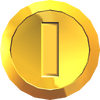 Coins |
Collecting a coin restores one bar to Mario's life meter. Collecting fifty during a mission gives Mario an extra life. If Mario loses a life during a mission, he loses all of the coins he collected within that specific mission. | 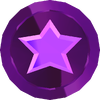 Purple Coins |
Coins that only appear in a galaxy when Purple Comets are in orbit. Collecting 100 awards Mario with a Power Star. |
 ? Coins |
Big coins with inconsistent properties. Making contact with one has different results depending on the level. Touching one can make a power-up, mushroom, note, or another ? Coin appear. They do not contribute to Mario's coin count. | 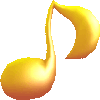 Notes |
Music notes which can appear when Mario touches a ? Coin. They appear in trails in the immediate vicinity and disappear after a few seconds. Collecting every note before they can disappear awards Mario with a power-up, a mushroom, or a Power Star. |
 Green Shells |
Shells of green Koopa Troopas. Mario grabs one when he makes contact or spins near it. Shaking |
 Red Shells |
Shells of red Koopa Troopas. They home-in on nearby targets when thrown. They give Mario a greater speed boost underwater than Green Shells. |
 Gold Shells |
Golden Koopa Shells. Of all the shells, these ones give Mario the greatest speed boost. They function identically to a Green Shell when thrown. |  Bombs |
Disengaged Bob-ombs that can be picked up and tossed. They explode on impact. Bombs are used during Bob-omb Blasting to clear trash. |
 1-Up Mushrooms |
Green mushrooms that give Mario an extra life when obtained. They are sold at Luma Shops. |  Life Mushrooms |
Red mushrooms that doubles the amount of bars in Mario's health meter from three to six. If Mario loses three bars, they cannot be restored. The life meter returns to just three bars when Mario completes the mission, even if at full health. This mushroom is sold at Luma Shops. |
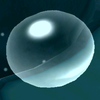 Bubbles |
Air bubbles appear underwater, often released by bubblers on the seafloor. Making contact with one refills Mario's air meter. |  Keys |
Collecting a key opens a corresponding case or Key Door, granting Mario access to a new area. |
 Yellow Star Chips |
Star fragments that each represent one-fifth of a Launch Star or Sling Star. Collecting five causes them to merge into either depending on the level context. |  Blue Star Chips |
Collecting five Blue Star Chips turns them into a Pull Star. |
Power-ups
Items that transform Mario's appearance and give him unique abilities.
| Power-up | Form | Description | |
|---|---|---|---|
| Template:Chart icon | Template:Chart icon | ||
 Bee Mushroom |
 Bee Mario |
 Bee Luigi |
Touching the Bee Mushroom transforms Mario[note 1] into Bee Mario. Holding |
 Rainbow Star |
 Rainbow Mario |
 Rainbow Luigi |
Making contact with the Rainbow Star transforms Mario into Rainbow Mario for thirty seconds. He is invincible and can defeat enemies on contact. Running in this form makes Mario build speed and shortens the height of his jump. Attempting to collect a different power-up in this form will instead launch it up without collecting it. |
 Boo Mushroom |
 Boo Mario |
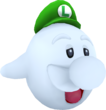 Boo Luigi |
Mario is transformed into a Boo when he touches the Boo Mushroom. Shaking |
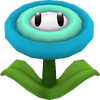 Ice Flower |
 Ice Mario |
 Ice Luigi |
Contact with the Ice Flower transforms Mario into Ice Mario for thirty seconds. In this form, Mario creates hexagonal ice platforms when he makes contact with water or lava, enabling him to wall jump between waterfalls. Because he produces ice under his feet, Ice Mario can continuously skate over water and lava. |
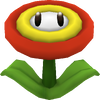 Fire Flower |
 Fire Mario |
 Fire Luigi |
The Fire Flower transforms Mario into Fire Mario for thirty seconds. Shaking |
 Spring Mushroom |
 Spring Mario |
Spring Luigi |
Making contact with the Spring Mushroom transforms Mario into Spring Mario. Mario continuously jumps in this form. Pressing |
 Red Star |
 Flying Mario |
 Flying Luigi |
The Red Star transforms Mario into Flying Mario for sixty seconds. Shaking |
Objects
Objects are interactable elements of the environment that cannot be picked up or collected by Mario. For objects that primarily function as obstructions or hazards, see above.
| Name | Description | |
|---|---|---|
| Transportation objects | ||
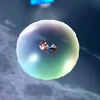 Bubble |
Big bubbles that are moved by the Star Pointer. Mario becomes stuck inside one when he touches it. The Star Pointer turns into an air-blowing nozzle (Template:Chart icon) that pushes the bubble with | |
 Cannon |
Cannons that launch Mario to distant areas. They are accessed like pipes. Entering one shifts the screen perspective to inside the cannon and turns the Star Pointer into a reticle symbol (Template:Chart icon). Aiming the reticle on screen and pressing | |
 Floaty Fluff |
Dandelion seeds that are carried on gusts of wind. Mario grabs onto one by spinning. It slowly descends as it floats. It ascends briefly by shaking | |
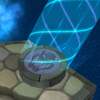 Gravity spotlight |
Blue beams of light that have their own gravity. When Mario walks into one, he is pulled towards the direction that the light is being beamed. It enables him to walk on walls and ceilings, but only where the light is being directly struck. | |
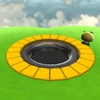 Hole |
Indentations in the ground for the Rolling Ball. Yellow-rimmed holes launch the Rolling Ball from one planetoid to another. The blue-rimmed ones are the final goals of their courses. They break the Rolling Ball and allow Mario to collect its Power Star. | |
 Key Door |
Doors that open when Mario makes contact with a key. | |
 Launch Star |
Floating stars near the surface of planets. They launch Mario to distant areas when spun near. Some yellow Lumas transform into Launch Stars when freed by Mario. | |
 Pipe |
Entering a pipe brings Mario to a new area. He enters one when | |
 Pull Star |
Floating stars that are interacted with the Star Pointer. Moving the cursor over a Pull Star and holding | |
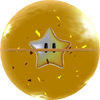 Rolling Ball |
Mario takes control of a Rolling Ball when he jumps on top of it. It is steered by shifting the | |
 Sling Pod |
Clumps of spider silk. Mario becomes stuck to one when he makes contact with it. Pointing on the Sling Pod with the Star Pointer and holding | |
 Sling Star |
Small Launch Stars that sling Mario towards a neighboring planet when spun near. | |
Tornado |
Tornados moves back and forth along set paths. Making contact traps Mario within its gusts. He is propelled high into the air like a bamboo-copter if he tries to spin, enabling him to reach distant platforms and avoid hazards. Tornados function similarly to Bone Twisters, but have no means of harming Mario. | |
 Underwater ring |
Dash rings found suspended in water. Swimming through one gives Mario a burst of speed. | |
Warp Pad |
Transport panels that move Mario along a curved beacon of light from one part of the Comet Observatory to another. More Warp Pads become available as energy is restored to the observatory. | |
| Blocks and containers | ||
 ? Block |
Floating blocks that contain items. One releases its content when Mario jumps underneath it. ? Blocks that contain coins and some that have Star Bits can be jumped under in rapid succession to release more than one. Most ? Blocks become empty blocks when there contents are exhausted. There are ? Blocks containing Star Bits that burst immediately when jumped under. Some are invisible and only become viewable once interacted with. | |
 Block |
Blocks that contain nothing and cannot be broken. Coin Blocks and some ? Blocks become these when their contents are exhausted. | |
 Brick |
Some are Coin Blocks that contain multiple coins like ? Blocks. Others are empty and fall apart when jumped under. | |
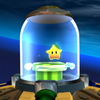 Case |
Cloche domes that trap Lumas, Power Stars, and other objects of interest. Most open when Mario acquires a nearby key, but some require the completion of a more cryptic task. | |
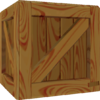 Crate |
Crates contain items or Goombas. They release their contents when spun near or ground-pounded. Crates are only found on the ground and break completely when struck. | |
 Gold Treasure Box |
A treasure chest that only opens when struck by a Gold Shell. It contains a Power Star and the Toad Brigade Captain. | |
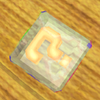 Sliding block |
Flat blocks only found on a planet in Gold Leaf Galaxy. They slide across the surface like hockey pucks and can damage Mario on impact. Striking one with a Ground Pound releases an item. | |
 Snow sculpture |
Blocks in Snow Cap Galaxy that melt when struck by fireballs. Each snow sculpture contains a coin. | |
 Stone block |
Big blocks in Rolling Gizmo Galaxy. They are destroyed when struck by the Rolling Ball. | |
 Treasure chest |
Wooden treasure chests that contain items. One opens when a Koopa Shell is thrown at it. | |
| Strikable and spinnable objects | ||
 Bolt |
Mario pushes bolts into the ground when he spins on top of them. Doing so grants him access to new areas or triggers nearby events. | |
 Bowser Statue |
Stone statues of Bowser that contain items. They are destroyed when struck by Bomb Boos or Bullet Bills. | |
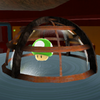 Cage |
Glass spheres. They contain objects of interest such as pipes, Star Bits, or Power Stars. In one mission, Luigi is trapped in a cage. They shatter when hit by Bullet Bills. | |
  Coconut / Watermelon |
Green fruits that can be launched when spun. Some enemies and bosses fire coconuts. Watermelons permanently replace them once Mario accumulates 9999 Star Bits on one save file. One otherwise appears in the center of a transparent planet in Deep Dark Galaxy. | |
 Crystal |
Gemstones that break when spun into. Most crystals are small, contain Star Bits, and are broken with a single spin. Others are large, contain Power Stars, and require three spins to be broken. | |
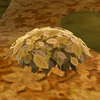 Leaf pile |
Leaf piles release Star Bits or coins when spun in. | |
 Rock spire |
Stalagmites. They fall apart when spun into. Some contain items. | |
 Rubbery bulb |
Bulbous plants. Spinning into one flings it forward and return with the same force exerted. Mario receives knockback if hit by the rebound. The plants rebound is halted if it collides with an enemy or object. They can be used to break objects and defeat enemies. | |
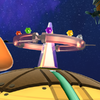 Shock Wave Generator |
Spires that release waves of electricity when struck, stunning nearby enemies. | |
 Snowman |
Snowmen are destroyed with fireballs. They obstruct narrow paths in some instances. | |
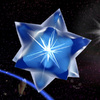 Star Piece Cluster |
Giant Star Bits that float in the set trajectory of Launch Stars. Colliding with one breaks it into seven collectible Star Bits. | |
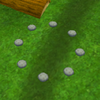 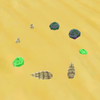 Stone circle / Shell circle |
A circle of eight objects embedded in the ground. Spinning inside the circle transforms the objects into Star Bits. | |
 Tiny lamp |
A shimmering protrusion in the ground. Firing a Star Bit at a tiny lamp turns it into a coin. | |
 Torch |
Lighting torches with fireballs solves puzzles and sometimes provides access to new areas. | |
 Trash |
Piles of garbage from Bob-omb Blasting. They are cleared with bombs. | |
 Valve |
Most valves release Star Bits when spun into the ground. One prevents the flow of water in Sea Slide Galaxy. | |
| Ground-poundable objects | ||
 Stone wheel |
Stone discs. Ground Pounding one breaks it and usually releases an item. Breaking a stone wheel sometimes changes an element of the area it is in. In some galaxies, there are multiple stone wheels stacked on top of each other. | |
 Stump |
Ground Pounding a stump either produces a coin or triggers an event that enable level progression, similar to Ground-Pound Switches. | |
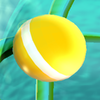 Tennis ball |
Yellow balls within a clear planet in Deep Dark Galaxy. Ground Pounding one launches it at a watermelon in the planet's center and makes it expand. | |
 Trampoline |
Trampolines bounce Mario into the air. Ground Pounding the surface of a trampoline launches Mario higher. | |
| Climbable objects | ||
 Banandelion |
Big dandelions. Mario grabs onto one by spinning. Continuing to spin makes Mario ascend up the flower and flings him. | |
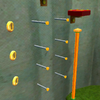 Bar |
Metal rods embedded into the caverns of Deep Dark Galaxy. Mario can swing from them to reach higher areas. | |
 Honey wall |
Hexagonal panels attached to the side of walls within levels. Mario can cling and crawl on them while in his Bee form. | |
Pole |
Mario clings to a pole by jumping onto it. He can ascend, descend, and change which face of the pole he is on by moving | |
 Sproutle Vine |
Twisting vines that sprout from the base of defeated Piranha Plants. Mario grabs and swings up one by spinning. Sproutle Vines enable Mario to travel from one area to another. | |
 Swing |
Trapezes made out of vines and flowers. Mario grabs onto one automatically when he makes contact with it. Moving | |
Vine |
A rope swing that Mario grabs onto when he jumps towards it. Moving the | |
| Switches | ||
 Blue switch |
Blue ! Switches. Ground Pounding one usually triggers a timed event or changes an element in the area it is encountered. | |
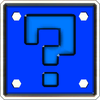 Flipswitch Panel |
Blue panels that turn yellow when Mario steps on them. Stepping on all of the panels in a confined area turns the switches green and triggers access to a new area or the appearance of a Power Star. | |
Gravity switch |
Switches that shift the gravitational pull from the floor to the ceiling. They only occur in areas on 2D planes. | |
 Ground-Pound Switch |
Buttons that trigger a change in the surrounding environment when Mario Ground Pounds them. A Ground-Pound Switch is only useable once. There are wooden and stone variants that are destroyed when activated. | |
 Lever Switch |
Levers that physically change the surrounding area, usually by granting Mario access to a new area by making a door or bridge appear. Mario uses one by spinning near it. | |
| Platforms | ||
 Airship |
Bowser's flying ships. Enemies patrol the decks. Some are equipped with cannons that fire hazardous projectiles. There are hatches on the floors of some airships. Ground-pounding one brings Mario inside the cargo hold. | |
 Assembly Block |
Multi-shaped platforms. They initially float in space far away from Mario, but will immediately assemble into an established configuration if he approaches the intended space. They fall away if Mario moves away from the intended space, meaning the player does not have a permanent visual as to where the platforms are going to appear. | |
 Bolts |
Three giant bolts on a metal rod. The rod connects two distant areas. Walking perpendicular to the rod on the bolts makes them rotate, allowing Mario to travel between the areas. | |
Cloud |
Floating platforms that Mario is normally too heavy to stand on. He can only do so in his Bee form. There are raining gray variants that move along set paths. | |
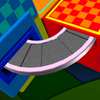 Conveyor Belt |
Platforms with moving surfaces. A blue Conveyor Belt has giant chocolate bars built into it. | |
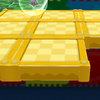 Flip Tile |
Yellow squares that flip downwards and turn indefinitely when stepped on. | |
 Float[31] |
Floats sink in water when stepped on, then rise back up. | |
 Flower |
Floating flowers that recede if Mario makes contact with them. He can only stand on them while in his Bee form. | |
 Ice |
Ice reduces Mario's traction and causes him to slide, but spinning causes Mario to start skating. | |
 Lift |
Moving platforms. Their designs and environmental context for moving depends on where they are encountered. Four wooden lifts attached to a pivot point appear in Honeyhive Galaxy that spin continuously, and there are similar lifts that look like lollipops in Toy Time Galaxy. | |
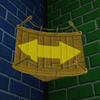 Ramp[32] |
Wooden ramps that enable traversal between two gravitational planes. | |
 Robot turtle |
Buoyant Koopa-like platforms that moves across the surface of water. | |
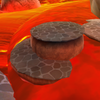 Rock platform[33] |
Rock platforms that sink into lava once stood on. | |
 Shrinking platform |
Checkerboard platforms that disappear once stood on. | |
 Starshroom |
Mushroom-shaped starships with their own centers of gravity. They were created by the Lumas for the Toad Brigade. | |
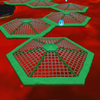 Steel platform[34] |
Platforms that sink in lava when stepped on, then rise back up. | |
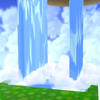 Waterfall |
Water overflowing the sides of elevated drops. In Beach Bowl Galaxy, a series of waterfalls can be ascended when Mario wall jumps between them in his Ice form. | |
| Other objects | ||
 Arrow Sign |
Signs that direct players towards the intended focus of the mission they enter. | |
Beacon |
The comet at the center of the Comet Observatory that gives it its energy. Collected Power Stars are fed to it. Grand Stars make it grow larger and unlocks new areas of the observatory to explore. | |
 Bob-omb dispenser |
Bob-omb dispensaries. A single Bob-omb dispenser only releases one Bob-omb at a time: the current one out must explode before it releases another one. The Bob-ombs are usually active, but the Bob-omb dispensers in Bob-omb Blasting only release legless variants that can be picked up by Mario. | |
 Bubbler |
Creates air bubbles. | |
 Butterfly |
Butterflies are sometimes found near flowers. In galaxies, trailing a butterfly with the Star Pointer causes it to release a Star Bit. Mario will automatically direct his gaze towards a butterfly if it is in his vicinity. One may land on his head if he falls asleep near it. | |
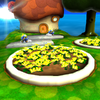 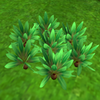 Flower / Grass |
Flora that rustles when walked through. Some release Star Bits or coins when disturbed. | |
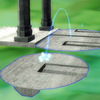 Matter |
Matter can take two forms: bouncing droplets that reveal circular parts of the planet's terrain, and spotlights that move in a set path revealing parts of the planet in their range. | |
 Portrait |
A painting of a 1-Up Mushroom. Touching a nearby ? Coin makes a 1-Up Mushroom emerge from it. Portraits of Boos and Bomb Boos also occur, and continuously release the enemies in the areas they are found. | |
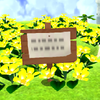 Sign |
Posted signs that contain information on actions. Most signs are inanimate objects that give Mario insight on his surroundings or actions when read. However, a few signs are speaking characters that give specific instructions on how to use objects or power-ups that change how Mario is controlled. | |
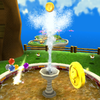 Water spout |
Mario is briefly carried into the air when he enters a water spout. When in his Ice form, Mario can freeze the surface of the water to form temporary ice platforms. | |
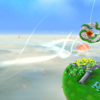 Wind |
Wind is usually generated by fans triggered by switches. Riding the currents in a bubble or with a Floating Fluff brings Mario to distant areas. | |
Music
- Main article: Super Mario Galaxy Original Soundtrack
The majority of the music in Super Mario Galaxy was composed and arranged by Mahito Yokota, who penned the entirety of the soundtrack for Nintendo EAD Tokyo's first title, Donkey Kong Jungle Beat (2004). Longtime series composer Koji Kondo contributed four tracks himself and mentored Yokota in developing a sound appropriate for the title. It is the first Super Mario game to feature a fully orchestrated soundtrack.[17] The game's orchestra performed at the Sound Inn Studios in Tokyo and consisted of roughly fifty members dubbed the "Mario Galaxy Orchestra". Koji Haishima, who had conducted pieces from Square Enix's Final Fantasy series and Capcom's Monster Hunter series, served as conductor.[35] Some of the pieces are orchestral arrangements of Kondo's compositions from Super Mario Bros., Super Mario Bros. 3, and Super Mario 64.
Yokota was professionally trained in orchestral composition and championed the use of an orchestra to producer Shigeru Miyamoto during the game's development. He was met with reluctance due to the anticipated expenses and the thought that it would detract from the player's immersion, which is why live instrumentation had seen only occasional use in prior Nintendo games.[17] It was ultimately decided that a live orchestra would be appropriate for Super Mario Galaxy after Yokota spent three months trying to develop the best sound with little success. Based on the music of prior titles in the series, Yokota's first attempts derived from Latin and pop music. Though approved by director Yoshiaki Koizumi, Kondo was displeased. When Yokota presented his work to him, he said, "Yokota-san, if somewhere in your mind you have an image that Mario is cute, please get rid of it... Mario is cool." This experience and the strenuous three months of work briefly made Yokota consider leaving the project.[17] A musical direction was definitively established when Yokota presented Miyamoto with three pieces – one orchestral, one a mix of orchestral and pop, and one entirely pop – and asked which he felt was the best style for Super Mario Galaxy. Miyamoto chose the fully orchestrated one, remarking that it sounded "the most space-like". This piece, titled "Egg Planet", was penned by Koji Kondo. It accompanied the game's debut trailer during E3 2006 and is incorporated as the level theme for Good Egg Galaxy in the final product.[17][35] Miyamoto's preference for it is what allowed Yokota to find his sound.
Mahito Yokota composed roughly thirty pieces for Super Mario Galaxy and oversaw their recording at Sound Inn. Unlike most orchestras, a metronome was used during recording sessions that was set to a tempo adjacent to Mario's running speed. He did this because he did not want the music to sound like a passive background element – he wanted it to sound like an organic part of the game.[17] Another major way this was accomplished was with the music itself being an influenceable element.[36] For example, there are three variations of "Rosalina in the Observatory", the waltz that plays on the Comet Observatory. The first variation is what plays in the earliest portion of the game, when many areas are inaccessible and the observatory is largely cast in shadow. This variation is simplistic in orchestration. As the player accumulates more Power Stars and more areas on the Comet Observatory become accessible to the player, the variation that plays is progressively more richly orchestrated.[37] Within the levels themselves, unique sound effects and musical queues correlate with the actions performed by the player in real-time. Sound director Masafumi Kawamura established this by building on what he had integrated in The Legend of Zelda: The Wind Waker (2003) and Jungle Beat, which comparably included instances where the player's actions would influence the music in limited, context-specific instances. In Super Mario Galaxy, the player can influence sound throughout the majority of the game. It was accomplished by synchronizing a stream of the raw recording data from the orchestra with Musical Instruments Digital Interface (MIDI) data. This effect enhances the player's sense of rhythm and immersion within the game world.[17][37][36]
On January 31, 2008, two soundtracks were made available in Japan through Club Nintendo. One is a standard edition with 28 tracks on a single disc. The other is a "platinum edition" that has 81 tracks across two discs. The platinum edition was released in Europe on the same date.[35] The standard edition eventually saw a localized release in the United States on October 23, 2011 through its inclusion in a Wii console bundle.[38] The platinum edition would not become available in the US until the release of Super Mario 3D All-Stars on September 18, 2020. Select pieces from Super Mario Galaxy are included in Super Mario History 1985-2010 Sound Track CD, Nintendo Sound Selection: Endings & Credits, and The 30th Anniversary Super Mario Bros. Music. Music from Super Mario Galaxy has been rearranged and incorporated into succeeding video games by Nintendo, including Super Mario Galaxy 2, Super Mario 3D Land, Super Mario 3D World, Mario Kart 8 (2014), Captain Toad: Treasure Tracker (2014), Super Smash Bros. for Wii U (2014), Super Mario Odyssey (2017), and Super Mario Maker 2 (2019). Film composer Brian Tyler incorporated select compositions into melodies he penned for The Super Mario Bros. Movie. Music from Super Mario Galaxy has been performed live in concert by the Kanagawa Philharmonic Orchestra, the WDR Rundfunkorchester Köln, and the London Philharmonic Orchestra.[39][40][41]
Media
- For a complete list of media for this subject, see List of Super Mario Galaxy media.
| File info 3:12 |
| File info 0:30 |
| File info 0:30 |
Staff
- Main article: List of Super Mario Galaxy staff
Super Mario Galaxy was developed by Nintendo EAD Tokyo, a development team established in 2003 that previously developed Donkey Kong Jungle Beat.[17] It is smaller than the Kyoto branch of the same name that developed the majority of the previous Super Mario games and consists of younger, less experienced staff.
Series creator Shigeru Miyamoto conceived of the game and served as one of its producers. Yoshiaki Koizumi, a friend and protégé of Miyamoto who has been involved with the series since Super Mario 64, served as director. This represents the first time he would serve as the sole director of a Super Mario game, after having co-directed Super Mario Sunshine with Kenta Usui. He previously directed Jungle Beat and believed that that game's development allowed the staff of Nintendo EAD Tokyo to get familiar enough with each other to confidently pursue a game as complex as Super Mario Galaxy.[17]
This is the first Super Mario game to feature the current voice actors for Princess Peach, Bowser, and Bowser Jr.: Samantha Kelly, Kenny James, and Catey Sagoian, respectively.
The staff credits in the Nvidia Shield TV version shows three people in charge of Chinese localization as well as an "iQue testing group". It is possible that the game was fully translated for the iQue Wii release before the console was canceled.[42]
Development
1997–2004: Super Mario 128 and Donkey Kong Jungle Beat
Super Mario Galaxy was developed to address the problems with 3D game design established by Super Mario 64.[18] That game was one of the first 3D titles ever published and has had a significant foundational influence on how 3D games are made, not just at Nintendo but throughout the entire industry.[43][22][8][44][45] Despite its influence, some members of Nintendo's staff observed that the game caused a divide between potential players that did not exist during the 2D era of video games, with some people feeling that 3D games are too difficult for them to play. Yoshiaki Koizumi, one of the assistant directors on Super Mario 64, believed that this perceived difficulty came from their attempts to keep the player from experiencing depth misperception, getting lost, and feeling motion sickness. The solutions created to mitigate these problems, most significantly camera controls, resulted in systems that were too cumbersome or at least intimidating for players.[18][17]
After Super Mario 64 was released, Shigeru Miyamoto assembled a team within Nintendo EAD to develop a successor tentatively titled Super Mario 128 to address this problem.[46][47] At SpaceWorld 2000, it was presented to the public as a technology demonstration for the Nintendo GameCube. Directed by Koizumi, the player controlled 128 Marios on a saucer-shaped platform that dynamically changed its shape over the course of the demo. This iteration of Mario 128 was never released as a full game, but Miyamoto did extrapolate the idea of having Mario run around "spherical worlds" from the demo.[48][49][47] It was believed that this concept would resolve many of the problems with previous 3D games in deemphasizing the need to control the camera and decreasing the likelihood of the player getting lost. When shared with Koizumi, he agreed this had the potential to become a full game, but was technically near-impossible.[17]
While Super Mario 128 continued development, Nintendo published Super Mario Sunshine for the GameCube in 2002. It was the first entry in the Super Mario series released since Super Mario 64 and shared many elements with it. However, Miyamoto asserted that Super Mario Sunshine was unrelated to Super Mario 128 and was best viewed as a continuation of Super Mario 64, not a proper successor that built on the concepts it introduced.[50][51] Super Mario Sunshine was the last 3D-related project Koizumi helped develop for several years, having served as one of its co-directors. He regretfully oversaw the integration of a camera system in Super Mario Sunshine that he felt was even more cumbersome than Super Mario 64's and came to the perspective that it was too difficult to produce the "perfect 3D control environment", where the game was both fun to play and not needlessly stressful for the player.[18][17]
Koizumi's next project was at the newly-formed branch Nintendo EAD Tokyo where he directed Donkey Kong Jungle Beat, a 2D action-adventure platformer released in 2004 for the GameCube. The player controlled Donkey Kong with the DK Bongos, a controller with fewer input options than the conventional GameCube controller. The experience of directing Jungle Beat made Koizumi realize that one could create a robust action game with only a few button inputs required of the player. They had established what Koizumi called "contextual binding", where available player actions change depending on the context, resulting in more diverse ways of play without increasing the number of buttons. Koizumi also observed that an exaggerated presentation delighted bystanders that were not directly playing the game, allowing more people to gain from the experience than just the player. These were concepts he brought to Miyamoto, who was still working on Super Mario 128 as its sole director.[47] In 2003, before they had started development on Jungle Beat, a staff member expressed interest in making the next Super Mario game. The experience of working together as a team for Jungle Beat made Koizumi realize that this was something they could do. They had the technical skill needed to succeed the struggling Super Mario 128 project and bring Miyamoto's spherical world concept to fruition.[18][17]
2005–2007: Super Mario Revolution
In 2005, Koizumi prepared an outline for "Super Mario Revolution" for the GameCube's successor, the Wii. Adapted from the Super Mario 128 demo and building on what EAD Tokyo had accomplished with Jungle Beat, the core concept of "Super Mario Revolution" was for it to be a 3D action platformer with Mario running around spherical worlds. These worlds would have their own centers of gravity that prevent Mario from falling off the edge.[19][18] There would be few walls or ceilings on the worlds to obstruct Mario's path. If he kept moving forward in one direction, he would return to his starting position. This would mitigate the chances of the player becoming lost. After the project was greenlit by Nintendo's executives, Koizumi spent three months creating a small prototype with several other EAD Tokyo employees to present to Miyamoto for his feedback. The prototype was set in space because it was believed that most players would interpret the spherical worlds as small planets. This set a precedent where Miyamoto would be the first one to playtest all of the game's builds. A system was eventually set up that allowed the staff to send him a build from the Tokyo studio to his office in Kyoto as soon as it was finished. In the last few months of development, Miyamoto made frequent in-person visits to EAD Tokyo.[17]
Development progressed with the involvement of more staff. It succeeded the indefinitely-stalled Super Mario 128 project and was recognized as the "true" successor to Super Mario 64 by Miyamoto during development.[20][48] At some point it was renamed Super Mario Galaxy to reflect the game's outer space setting. An important tenet that informed development was to prioritize what Koizumi refers to as "ease of play" - to make the control system as unobtrusive to the player as possible. The number of button inputs required by the player was kept to a minimum. The spin move was added to supplement jumping actions, which Koizumi believes can be imprecise in a 3D environment.[18] Originally they made it so that Mario could spin indefinitely by shaking the Wii Remote, but Miyamoto had them integrate a delay after the spin to make the game more challenging.[17] Employing contextual binding resulted in the development of scenarios within the game that change what button inputs do, such as in the rolling ball levels, ray surfing, and controlling power-ups. Pointer controls were thoroughly integrated into Super Mario Galaxy to supplement or even replace traditional button inputs, as the team felt they were more intuitive.[17][18] To keep the player from "thinking about the camera", another tenet of development, EAD Tokyo developed a new camera system called the "planet camera". It gently follows Mario as he runs across a spherical world without sudden jerks or obscuring his positioning. It requires no input from the player.[18] This element of the game was very important to the staff because they did not want any players to experience motion sickness. To ensure the game was comfortable to play, they heavily relied on the feedback of playtesters, something that was also employed extensively during Jungle Beat's development.[17]
In concert with Nintendo's goal of making the Wii appeal to demographics beyond their core consumers, the team wanted Super Mario Galaxy to appeal to people who do not play video games.[17][48] One of the ways they did this was by integrating a cooperative multiplayer mode called Co-Star Mode. One player controls Mario and a pointer (P1) while a second player only has a pointer (P2). It was seen as a good way for family and friends to play together even if one of them was inexperienced with games.[18] Co-producer Takao Shimizu originally envisioned pointer controls being the same for both players, but Miyamoto had them restrict some actions to P2. This completely changed the balance of the game. For example, they originally allowed P1 to hold moving obstacles in place with the pointer. Staff felt that restricting this action to P2 improved the game's flow.[17] The desire to engage non-players also informed Super Mario Galaxy's theatrical cutscenes and lively character animations. This made the game fun for bystanders to watch.[18]
There were concentrated efforts to make the game easily accessible for beginners, such as with the integration of Bee Mario. Believing that one of the joys of a Super Mario game was simply moving around, Koizumi oversaw the integration of areas without enemies or objectives. The earliest builds of the game were too easy, however. Miyamoto reminded staff that it was important for a game to feel challenging to play, otherwise the player might feel disengaged. Measures were subsequently taken to ensure the game was still healthily challenging, such as by reducing the life meter from eight bars (as was done in Super Mario 64 and Sunshine) to three. Coins were made rarer, health-restoring items.[17]
EAD Tokyo was pressured to finish the game close to the Wii's launch, as several executives were disappointed by Super Mario Sunshine not being a GameCube launch title and thought that an earlier release could have helped the console's commercial performance. When Super Mario Galaxy was first shown off to the public during E3 2006, Miyamoto stated it would release within six months of the Wii's launch. However, EAD Tokyo felt it was more important to make a game they were really happy with, resulting in it launching eleven months after the Wii.[17]
Pre-release and unused content
When first showcased at E3 2006, Toads with star-shaped spots appeared in the game that provided the player hints and could transform into rabbits. Lumas serve this role in the final game. Rosalina was originally conceived as "related" to Princess Peach and had a similar design reflecting this. Bonefin Galaxy was intended to be much darker, as was Deep Dark Galaxy. These were changed in the interest of playability. Guppy was first envisioned as a friendly character and had a design comparable to the Dolphins from Super Mario World (1990). Artwork of Sea Slide Galaxy and Beach Bowl Galaxy suggests that they were conceived as a single galaxy, with Beach Bowl's main planet in the center of Sea Slide's ring. The staff were sentimental for this piece of concept art titled Fortress because it was one of the first drawings made during development.[52] The planet shown in the art is not in the final game, but it has some similarities to Good Egg Galaxy, Beach Bowl Galaxy, and Bowser Jr.'s Robot Reactor. The development team wanted to incorporate Yoshi and he appears in the 2005 "Super Mario Revolution" proposal documents, but he is relegated to cameos in the final release.[53]
Glitches
- Main article: List of Super Mario Galaxy glitches
Floating Toad
To perform this glitch, the player should go to the level "Tarantox's Tangled Web". Mario should go to the final planet where Tarantox is fought and launch the green Toad onto the platform. Then, the player should jump into the sling pod and launch Mario onto the same platform so it breaks. If the player looks at Toad closely, he can be seen floating.
Freezeflame Galaxy out of bounds
To perform this glitch the player should go to the Freezeflame Galaxy's mission "Hot and Cold Collide". Mario should reach the second planet and triple-jump in the walkway between the sides of the planet. The player should use the slope-climbing glitch to reach the top of the planet. When the player walks on the planet, random textures of ice water will appear. The planet surface will also appear in the wrong spot or be invisible.
Notable promotions
Trading cards
- Main article: List of Super Mario Galaxy trading cards
Trading cards were developed by EnterPlay to correspond with the release of Super Mario Galaxy. Each pack (called Fun Paks) contained two regular cards, a trivia card, a standee, and a temporary tattoo.[54]
Buzz Aldrin promotional events
To correspond with its release in the United States, Nintendo of America hosted an event with MTV in Las Vegas, Nevada on November 3, 2007 where someone dressed as Mario entered the reduced-gravity aircraft G-Force One with former astronaut Buzz Aldrin.[55][56] It was coordinated with the Zero Gravity Corporation, who owns the aircraft.[57] Patches labeled "Super Mario Galaxy Flight Team" were created for the suits worn by Aldrin and the assisting crew.[58]
On November 13, 2007, Aldrin attended a press event held by Nintendo Ibérica in Madrid, Spain alongside marketing director Nicolás Wegnez and Wii brand manager Ernesto Fernández, during which they demonstrated Co-Star Mode. Aldrin shared his impression of Super Mario Galaxy, noting that while he found it "quite the challenge" for someone who did not play video games, he felt it encouraged him to problem solve from new perspectives.[59] He also felt that the game invoked one's imagination about space travel, similar to the science fiction comics of his youth.[60]
Press Start 2008 concert
On September 14, 2008, Famitsu hosted the concert Press Start 2008 -Symphony of Games- at Bunkamura Orchard Hall. It was an intercompany celebration of video game music. One of Nintendo's contributions to the setlist was "Super Mario Galaxy 2008", a medley of the game's music arranged by Mahito Yokota and conducted by Taizo Takemoto. Koji Kondo and Yokota attended the event as guests.[39] A recording of this piece is featured on a compact disc included with the Super Mario 25th Anniversary Commemorative Book published in 2010.
Super Mario-kun adaptation
The events of the game are adapted in three volumes of the manga Super Mario-kun. The first volume, 38, was published October 28, 2008 and follows the conclusion of a story arc based on Super Paper Mario (2007). It sees Mario becoming demoralized after failing to rescue Princess Peach during the Star Festival, but his confidence is restored by Rosalina and the Lumas. He travels across various galaxies alongside them and other characters from Super Mario Galaxy. In vol. 39, published March 27, 2009, Mario plays with most of the game's power-ups and rescues Luigi. The arc concludes in vol. 40, published November 27, 2009, and is followed by a storyline adapted from Mario & Luigi: Bowser's Inside Story (2009).
Reception
Reviews
Super Mario Galaxy is universally acclaimed. It has an aggregated score of 97.64% from 78 reviews on GameRankings. By the time of its closure in 2019, Super Mario Galaxy was the highest rated game on the site to have at least 20 different reviews.[61] Similarly, Super Mario Galaxy has a Metascore of 97/100 on Metacritic from 73 accredited outlets and 91% from 3,434 site users as of January 7, 2024, reaching the threshold for "Universal Acclaim" on both accounts.[62] As of January 9, 2024, it has the fourth highest Metascore on the site, following The Legend of Zelda: Ocarina of Time, SoulCalibur (1999), and Grand Theft Auto IV (2008).[63]
Reviewers have consistently praised the game's artistic fidelity, complimenting the character animations, lush vistas, environmental effects, enemy designs, audio design, and orchestrated soundtrack.[64][65][66][67][68] Aaron Linde of Destructoid described Super Mario Galaxy as "one of the most beauitufl games [he]'s seen in years,"[69] while Penki Yamamoto of Famitsu remarked that the game looked so nice that it was enjoyable to just watch other people play.[70] Controlling Mario was notably intuitive and comfortable, being instantly understandable for people who do not have a lot of experience with platform games while also feeling excellent for seasoned players.[65][66][69][70] The level design of Super Mario Galaxy was widely praised as some of the best of any 3D platformer at the time, and regularly subverted the player's expectations.[69][66] Several reviewers felt that there was no certainty on the scope or unique gameplay mechanic that would be introduced in a galaxy. "You just follow the fun, chasing star trails and distant glimmers across oceans of empty sky. Levels form and dissolve under your feet, rotating and revolving," as put by Margaret Robertson for Eurogamer.[67] This unpredictability and variety was widely acclaimed.[64][65][70] The game was often likened to Super Mario 64, succeeding the game in many respects and building upon the foundation of what it had established in the 3D platform genre.[64][70] It was asserted to be a superior game to Super Mario Sunshine, which had a more tepid response from critics.[65][66][67][68]
The controls that come directly from the unique capabilities of the Wii Remote, namely spinning and moving the Star Pointer, were viewed as some of the best integrations of the console's features at the time, and starkly contrasted with Wii games from other developers.[70][68] Edge elaborated that the Pointer allowed the player to engage with the game in two different ways simultaneously, all without making it feel cumbersome.[71] Ball rolling and ray surfing were praised as some of the best examples of motion controls on the console.[67][65][72] The game's camera, and the ease with which it automatically followed the player, was viewed positively. Edge even described it as flawless.[71] However, most reviewers noted that it would struggle in areas that would benefit from more manual control,[69][64] such as in the sprawling Honeyhive Galaxy.[68] For Matt Casamassina of IGN, the camera was one of the few issues he had with an otherwise near-flawless experience. In the decade following his review, he anticipated that Super Mario Galaxy would be celebrated as a classic, much like some of its predecessors.[65]
Famitsu gave Super Mario Galaxy a score of 38/40, with critics highlighting the variability of mechanics and accessibility of the controls.[70][73] Chris Scullion of Official Nintendo Magazine gave the game a 97%, referring to it the best game of the decade while praising its visuals, sound, and gameplay elements.[74][75] In 2011, Super Mario Galaxy was ranked number fifty-first in Game Informer's "Top 200 Games of All Time".[76][77] Nintendo Power ranked it as best mainline Super Mario game in its May 2012 issue and deemed Rosalina the "Best Supporting Character", stating "there are a lot of things in the Super Mario series that are fun, but very few are emotionally powerful; Rosalina is one of them."[78][79] In their final issue, they ranked Super Mario Galaxy as the third greatest game of all time.[80] In Japan, a 2021 poll conducted by TV Asahi with over 50,000 participants found Super Mario Galaxy amongst the top 100 video games of all time, ranked number 56.[9][10] The game has been praised by Gregg Mayles, Warren Spector, and Tim Schafer.[81][82][83][84]
In terms of criticism, the opening cutscenes of Super Mario Galaxy were viewed as superfluous and overdrawn by some.[67][66] The lack of scripted voice acting for dialogue was more consistently criticized, especially during these cutscenes.[72][65] Writing for VideoGamer, Tory Orry believed that Super Mario Galaxy would have benefited from having a more centralized, character-driven story like other games of its generation.[68] Others believed narrative elements, such as Rosalina's Story, felt forced[72][85] and needlessly dark in an otherwise joyful experience.[65] Tim Rogers had a negative assessment of the game, feeling it spent too much time explaining actions to the player rather than building courses that intuitively convey them, as was done in Super Mario Bros. 3 and Super Mario 64.[72] He also felt Super Mario Galaxy was easy to a disengaging degree,[72] a sentiment partially shared by some positive outlets as well.[65][71] That being said, most critics felt the game struck an ideal, comfortable balance between being needlessly difficult and easy.[67][70] In a 2018 review on his YouTube channel Nitro Rad, James Lewell noted that the levels in Super Mario Galaxy tend to funnel players down specific paths and do not encourage exploration in the same way its 3D predecessors do. Even if it was a more refined experience, he felt the open sandbox-styled design of Super Mario Sunshine was a superior direction for 3D Super Mario games.[85] Scores and comments from some of the review outlets discussed above are provided below.
| Reviews | |||
|---|---|---|---|
| Release | Reviewer, Publication | Score | Comment |
| Wii | Aaron Linde, Destructoid | 9.6/10 | "To say that they've succeeded almost isn't enough; Super Mario Galaxy is so incredible that it improves upon flaws in Mario 64 that I hadn't even noticed until, y'know, Galaxy did it better. And though there's little in the way of "innovation" of the genre, it's the refinement of the genre that solidifies Galaxy as the most essential platforming experience yet created." |
| Wii | Edge | 10/10 | "Since the end of the N64 era, as Nintendo has explored new pastures and methodically tended old ones, it's been easy to forget the times when every major release from the company felt like this. It's a bravura piece of design that pulls off stunts no one else has even thought of." |
| Wii | Margaret Robertson, Eurogamer | 10/10 | "The great challenge in making a follow-up to Mario 64 was always that to do it justice, you'd have to make a game which is as much its own as Mario 64 was. That's no easy task when you also have to integrate the traditions of two decades of Mario games and the expectations of millions of fans. Sunshine, despite its dazzle, ultimately collapsed under that weight, becoming repetitive and sometimes cumbersome as it tried to find the balance. Where Galaxy matches Mario 64 is not quite in its quality of execution - alongside the brilliance of some stars are others which fall a bit flat, and there isn't the overall sense of implacable perfection that that game had - but in its confidence and originality. Another decade needs to go by before we'll know whether it will come to be as revered as 64 did. For now, all that matters is that the waiting is finally over." |
| Wii | Alex Navarro, GameSpot | 9.5/10 | "The stellar presentation and fantastic level designs combine to make Super Mario Galaxy the Wii's game to beat and one of Mario's greatest adventures yet." |
| Wii | Matt Casamassina, IGN | 9.7/10 | "Galaxy isn't quite perfect. There are some minor issues -- tiny blemishes, if you will, hiding on the backside of a supermodel. There's the auto-camera, which works exceptionally well most of the time, but every so often stumbles. And there's the overall difficulty -- a little too easy to 60 stars and to defeat bosses for my tastes. But even with these potential drawbacks, Nintendo's Tokyo studio has created a platformer that deserves its place among the very best and will surely be remembered in another decade as a classic." |
| Wii | Anthony Dickens, Nintendo Life | 10/10 | "Super Mario Galaxy is a fantastic game, a game that displays Nintendo's continuing ambition to explore the possibilities of a 3D platformer, something that no-one else has really managed to do. It's considerably better than Super Mario Sunshine on all accounts, with the new emphasis on gravity it becomes once again a game that requires skill and timing rather than just an exploratory mind. This will be an instant hit and surely go down as one of the best Mario games. A must have for all." |
| Wii | Tom Orry, VideoGamer | 9/10 | "In the hands of anyone who's been longing for a true sequel to Mario 64, Super Mario Galaxy could well be the game of the year, but it's nowhere near as revolutionary as Mario 64." |
| Aggregators | |||
| Compiler | Platform / Score | ||
| Metacritic | 97 | ||
| GameRankings | 97.64% | ||
Sales
Super Mario Galaxy was a commercial success, selling 350,000 units in Japan within its first few weeks of sale.[86] In the United States, the game sold over 500,000 units within its first week of release, earning it the highest first-week sales for a Super Mario game in the country at the time.[87] Within its first two days on sale in the United Kingdom, the game was the fifth best selling piece of software.[88] In 2008, Nintendo reported that the game was one of the titles that significantly contributed to a rise of console sales for the proceeding fiscal year.[89] Super Mario Galaxy has the ninth best lifetime sales of all Wii software and the third best of software to have never been bundled with the console, having sold 12.8 million copies worldwide as of September 30, 2023.[90]
Accolades
Among game media outlets, Super Mario Galaxy was regarded as 2007's "Game of the Year" by the editing staff of IGN,[91] GameSpot,[92] Kotaku,[93] Yahoo! Games,[94] GameTrailers,[95] and Edge. It received the award for "Best Audio Design" from Edge as well in their annually published Edge Awards.[96]
Within a month of the game's release, Super Mario Galaxy won two awards at Spike TV's 2007 Video Game Awards in the United States.[97] The game subsequently received thirteen nominations from six different organizations throughout 2008. On February 8th, the game won the award for "Adventure Game of the Year" from the Academy of Interactive Arts & Sciences at the 11th Annual Interactive Achievement Awards.[98] It was nominated in five other categories, including "Overall Game of the Year" for which it was a finalist.[99] At the 8th Annual Game Developers Choice Awards on February 22, Super Mario Galaxy received nominations in two categories, one of which was another "Game of the Year" award.[100] In March, the game was nominated for five awards and won two at the 7th Annual NAVGTR Awards from the National Academy of Video Game Trade Reviewers.[101] In Japan, Super Mario Galaxy won "Game of the Year" alongside Capcom's Monster Hunter Freedom 2 at the 2007 Famitsu Awards. It was graciously accepted by Yoshiaki Koizumi.[102] At the Japan Game Awards 2008, the game received the "award for excellence" in the Game of the Year Division from the Computer Entertainment Supplier's Association.[103] The game was nominated for three awards at the Golden Joystick Awards 2008 later that year.[104]
During 2009, in what was recognized as a "surprise" by the BBC,[105][106][107] Super Mario Galaxy won "Best Game" at the 5th British Academy Games Awards and was the first Nintendo game to ever receive the award.[108] It was accepted on behalf of the development team by senior product manager Rob Lowe, who took the opportunity to defend the title against claims that it is not a "gamer's game."[105] Super Mario Galaxy was nominated for the "Gameplay" and "Use of Audio" awards as well, but lost to Activision's Call of Duty 4: Modern Warfare and Electronic Arts' Dead Space, respectively.[109] At the 2012 Kids' Choice Awards, Super Mario Galaxy was nominated for "Favorite Video Game" a year after its sequel was.[110] It lost to Just Dance 3.[111] Each organization to recognize Super Mario Galaxy and its respective award nominations are listed below.
| Awards | ||||||
|---|---|---|---|---|---|---|
| Date | Organization | Country | Award | Result | Ref. | |
| 9 Dec. 2007 | Spike Video Game Awards | United States | Best Action Game | Won | [97] | |
| Best Wii Game | Won | |||||
| 8 Feb. 2008 | Interactive Achievement Awards | United States | Overall Game of the Year | Nominated | [99] | |
| Console Game of the Year | Nominated | |||||
| Adventure Game of the Year | Won | |||||
| Outstanding Innovation in Gaming | Nominated | |||||
| Outstanding Achievement in Game Design | Nominated | |||||
| Outstanding Achievement in Game Play Engineering | Nominated | |||||
| 22 Feb. 2008 | Game Developers Choice Awards | United Kingdom | Game of the Year | Nominated | [100] | |
| Game Design | Nominated | |||||
| 25 Mar. 2008 | NAVGTR Awards | United States | Game of the Year | Nominated | [101] | |
| Control Design | Won | |||||
| Control Precision | Nominated | |||||
| Game Design | Nominated | |||||
| Game Sequel Children's | Won | |||||
| 26 Apr. 2008 | Famitsu Awards | Japan | Game of the Year | Won | [102] | |
| 9 Oct. 2008 | Japan Game Awards | Japan | Award for excellence | Won | [103] | |
| 31 Oct. 2008 | Golden Joystick Awards | United Kingdom | The Sun Family Game of the Year | Nominated | [104] | |
| Nintendo Game of the Year | Nominated | |||||
| BBC 1Xtra Soundtrack of the Year | Nominated | |||||
| 10 Mar. 2009 | British Academy Games Awards | United Kingdom | Best Game | Won | [109] | |
| Gameplay | Nominated | |||||
| Use of Audio | Nominated | |||||
| 31 Mar. 2012 | Nickelodeon Kids' Choice Awards | United States | Favorite Video Game | Nominated | [111] | |
Controversy
Super Mario Galaxy was the first Super Mario game to be officially localized to French for Quebec. This region had previously received games in English. This followed a deal between the Office québécois de la langue française and the video game industry to have every game available for that region in French by 2009. In the Quebec localization, non-playable characters (particularly the Lumas and the Toad Brigade) make heavy use of Joual, a social dialect of Quebec French. This localization choice sparked a minor controversy, with representatives of the Office québécois de la langue française and the Union des artistes criticizing it for promoting poor literacy to children.[112] Nintendo of Canada marketing director Farjad Iravani stated that Joual was integrated to "localize the game for the market" in mind, with Quebec making up 25% of Canadian sales for Nintendo at the time.[112]
Following the negative press surrounding Super Mario Galaxy and the similarly localized The Legend of Zelda: Phantom Hourglass (2007), nearly all subsequent Québécois releases have been in standard French. As of 2024, the only exception has been Paper Mario: Sticker Star (2012), which also features the Joual dialect.
Themes
Super Mario Galaxy has been noted for its narrative themes, the very presence of which has been described as exceptional when compared to other titles in the Super Mario series.[20][85] The game explores themes of isolation, grief, found family, acceptance, and rebirth.[21][113][114][115]
The game invokes feelings of isolation and sadness through its outer space setting. Most galaxies are enveloped by vast, dark skies pierced by stars and distant suns. There are story scenarios, missions, locations, and musical cues interlaced in the game that intentionally draw attention away from its more vigorous, joyful elements to focus on the dispassionate coldness of space, amplifying Mario's relative insignificance to a vast, endless universe. Video essayist Jacob Geller notes that these conditions give the player a moment to decompress after action-orientated gameplay and foster contemplativeness. Such conditions are interpreted as existentialistic and sad,[85] but not despairing.[21][114][115] Grace Benfell of GameSpot describes the evoked feeling as an "existential, joyful melancholy."[113]
Benfell also comments on the integration of Lumas in the game.[113] The childlike creatures are predestined to become celestial bodies at the end of their life cycles. The objects Mario directly interacts with are implied (and sometimes even directly demonstrated) to have once been Lumas themselves, with Launch Stars having once been yellow Lumas, Pull Stars once blue ones, and so on. As a gameplay mechanic, Hungry Lumas permanently transform into wholly new planets and galaxies once fed a requested number of Star Bits. These planets are instantaneously lush with flora and sometimes already bear communities of people and creatures living on them. As Benfell argues, this mechanic implies everything in the game, from whole worlds to animals to small objects, are "made" out of Lumas.[113] This interpretation is confirmed directly in the game.[116] The cycle of rebirth in Lumas likely derives from the life cycle of real stars and the knowledge that the majority of elements, including all the ones that make up living things, were created and distributed across the universe by dying stars.[117] Benfell equates transformation with death, an often negative theme in art. However, she elaborates that it is in dying that new life comes to be, including newborn Lumas, so it is an essential component to how the universe functions in an entropic cycle of continuous rebirth.[113]
The game's themes are most deeply and explicitly channeled through the characterization of Rosalina.[85][21][113][115] As overseer of the domestic Comet Observatory and caretaker of the Lumas, she is widely perceived as a maternal figure that supports a warm, securing environment only amplified by the contrasting, cold backdrop of space. She is also presented as a figure of reliable support with godlike abilities. She is omnipotent, wise, and a timeless entity that has lived for centuries.[113][115] Mario cannot be harmed on the Comet Observatory, and it is implied that she is the one who brings him back to safety if he falls off the side. No harm can come to the player as long as they are with her.[21]
However, despite the security and warmth she radiates, she is simultaneously presented as reserved, longing, and melancholic. The context for this is not explained to the player unless they enter the library on the observatory, an optional element of the game not tied to any completion criteria.[21] It is here that she reads a storybook detailing her past. Long ago, Rosalina lived on Mario's home world. Her mother died while she was a child, and she was still grieving that loss when she encountered one of the Apricot Luma's predecessors. He too had lost his mother before crash-landing on her world, and he was waiting for her to return to him. Rosalina befriended and chose to wait for her with him. After several years of waiting, they traveled into space to directly look for her. It is while in space that Rosalina takes on the role of "mama" for the Luma, when he comes to tearfully accept that his mother is really gone. Over time, more lost Lumas come to Rosalina and recognize her as their mother. Towards the story's emotional climax, with Rosalina overwhelmed with memories of her mother, the Apricot Luma transforms into a comet so that she may be able to travel the stars and visit her home world again. It is through this selfless act that Rosalina realized that she was not truly alone. She realized her own purpose in life,[113][115] embracing the role of mother for the Lumas, her family,[114] as her own mother did for her.
Sociologist Ciara Cremin adapted Gilles Deleuze's analysis of cinema to Super Mario Galaxy, providing a foundation for how video games can be studied as a discrete artform. She understood it to be a masterpiece of the form.[7]
Legacy
Shigeru Miyamoto considers Super Mario Galaxy to be the "true" sequel to Super Mario 64, not Super Mario Sunshine.[20] Though originally not characterized as such,[20][118][119][120][121] the game has been internally recognized as a different type of 3D game from its predecessors and for having directly informed the structure of the subsequent three 3D Super Mario games, collectively called the course clear-style games.[3] One of these games, Super Mario Galaxy 2, is a direct sequel and the first one to have been released on the same console as its predecessor since Super Mario Land 2: 6 Golden Coins. Building upon the first game's design principals, its courses are more linear and reliant on 2D sections. The outer space theming is subdued. Gameplay components like the world map and Prankster Comets are less complex. The hub world is smaller than the Comet Observatory, and the unique narrative elements of Super Mario Galaxy are muted. These changes were made to further foster accessibility to a wider audience and reduce dependency on camera controls.
The design of 3D Super Mario was further streamlined in Super Mario 3D Land and Super Mario 3D World, the other two course clear-style games. They were perceived to have adopted more design principals from the concurrent New Super Mario Bros. games than the hakoniwa ones of their 3D predecessors.[119][120][4] Super Mario Odyssey was the first 3D game to not be explicitly tied to Super Mario Galaxy in fifteen years, but it still incorporated elements derived from the game. The Moon Kingdom was created to contrast with Super Mario Galaxy specifically, with more realistic topography.[122] Gravity is generally weaker in the lunar kingdoms, making jumps floatier, and a few 2D areas include spherical worlds. Kenta Motokura cites the game as the inspiration behind Snapshot Mode.[123] Multi Moons are analogous to Grand Stars, as are the Royal Seeds of Super Mario Bros. Wonder (2023).
Iconography from Super Mario Galaxy has been incorporated into nearly all space-themed settings in subsequent spinoff games. Rosalina has become a recurring character in the mainline games and spinoffs. She often appears alongside older Super Mario characters in physical Nintendo advertisements, such as at Narita International Airport.[124] Lumas, Star Bits, and the Toad Brigade have also become recurring elements in the franchise. The Toad Brigade Captain has appeared in five subsequent mainline games and even starred in a dedicated title. The starting planet of Gateway Galaxy appears on the Yoshi's Adventure ride at Super Nintendo World, and Ray appears in the Mario Kart: Bowser's Challenge ride. For more specific callbacks to Super Mario Galaxy, see below.
Super Mario Galaxy was the last game directed by Yoshiaki Koizumi, who has taken on producorial roles for subsequent Super Mario projects. From 2013 to 2023, he was the representative director at 1-UP Studio, a sister studio to Nintendo EAD largely dedicated to developing 3D Super Mario games. The level-design director for Super Mario Galaxy, Koichi Hayashida, inherited the role of director for all subsequent course clear-style 3D titles. Super Mario Galaxy was the last Super Mario title to see "serious" involvement from Miyamoto until Super Mario Run (2016).[125]
Super Mario Galaxy was not the first video game to integrate spherical worlds that pan under the player character's feet. However, it is often de facto example of spherical world design, with games that touch upon similar concepts often likened to Super Mario Galaxy even if they were published before it. That being said, few games have even attempted to integrate the 3D spherical world design of Super Mario Galaxy. From Nintendo themselves, Super Mario Galaxy 2 was the last game to incorporate those types of levels.[121] In 2008, Fantawild published a knockoff for the Chinese market titled Duludubi Star that includes spherical worlds.[126] Rosalina was proposed as a new playable character in the earliest phases of Super Smash Bros. for Nintendo 3DS / Wii U, explicitly with the desire to replicate the feel of Super Mario Galaxy in her aerial movements.[127] The game has been cited as a source of inspiration for Armillo (2014),[128] Gravity Ghost (2015),[129][130] Gears 5 (2019),[131] Solar Ash (2021),[132] and Mario + Rabbids: Sparks of Hope (2022).[133]
Rereleases and ports
Wii U eShop
The game was added to the Wii U eShop in late 2015 and early 2016, five months after its sequel was released on the console.[134][135][136] It remained available for purchase on the eShop until its closure on March 27, 2023. It was the seventh Wii game distributed on the eShop and one of the 35 overall to ever be released. The eShop version runs off the Wii U’s backwards compatibility with nearly all Wii software as if the game disc was physically inserted, loads it through the Wii Menu, and accesses any save data already present on the console. The Wii U GamePad can be used to pause the game and return to the Wii U Menu, but it otherwise can only be controlled with the Wii Remote and Nunchuk.
Nvidia Shield TV
Super Mario Galaxy was rereleased to the Nvidia Shield TV microconsole and digitally distributed on March 22, 2018, exclusively in China.[137] It was the first of six Wii games to be made available on the Nvidia Shield TV. It remained available for download until late 2021, when all Wii games were removed from the Shield. The game was emulated on the console, enabling it to run at 1080p. Sprites and textures were upscaled to match the higher-definition display. Inputs have been modified for the more conventional Shield controller, which cannot track motion like the Wii Remote can (see above). Unused assets present in the data of the Wii release were removed. The game was officially localized into Chinese (Simplified Chinese) by iQue. As the Shield does not support Miis, they are not available for save file icons in this version of Super Mario Galaxy.[138] The copyright information displays "© 2007-2008 Nintendo". It is unclear what 2008 means in this context, but it potentially refers to the year Super Mario Galaxy was planned for release on the iQue Wii before the console failed to make its way into the Chinese market.[138]
Super Mario 3D All-Stars
- Main article: Super Mario 3D All-Stars
In correspondence with the 35th anniversary of Super Mario Bros., Nintendo released Super Mario 3D All-Stars for the Nintendo Switch on September 18, 2020 worldwide.[6] It is a compilation that includes upscaled versions of Super Mario 64 and Super Mario Sunshine in addition to Super Mario Galaxy. This version of the game is comparable to the Nvidia Shield TV release and they share similar revisions, though it does not include the Chinese localization. It only offers menu translation for the Chinese-speaking audience. This is reportedly due to the translation not being fully owned by Nintendo.[139] Like the Shield version, Miis cannot be chosen as save icons even though the Switch has an integrated Mii creation tool. The compilation had a limited physical release at retail outlets and was available to download on the Switch's eShop until March 31, 2021.[6] The official description of Super Mario Galaxy in the compilation is as follows:
It's the night of the Star Festival, and Star Bits are falling from the sky! As everyone celebrates, Bowser suddenly appears and lifts the castle—and Princess Peach—into space, leaving Mario stranded in orbit! It's here that Mario meets a curious star child, Luma, and a mysterious woman in blue...This game introduced new ways to control Mario, like pointing and shaking the Wii Remote, as he explores miniature planets with fun forms of gravity.
References to other games
- Super Mario Bros.: Fire Mario appears. One side of a planet looks like Small Mario's sprite while the other resembles Small Luigi's. The backgrounds of several galaxies are based on the sprites in this game. "Super Mario 2007" is an arrangement of "Ground Theme". "Space Athletic" is an arrangement of "Underground Theme". "Cosmic Comet" incorporates both pieces. Collecting notes sometimes plays the "Underground Theme" or "Underwater Theme".
- The Legend of Zelda: Electrogoombas and Roctos resemble Octoroks. Bats resemble Keese.
- Super Mario Bros.: The Lost Levels: Luigi jumps higher and has worse traction than Mario.
- Super Mario Bros. 2: Luigi scuttles his legs when he performs a Triple Jump.
- Super Mario Bros. 3: Airships appear. Montys behave like Rocky Wrenches. "Blue Sky Athletic" and "Airship Armada" are arrangements of "Athletic Theme" and "Airship Theme", respectively.
- Super Mario World: Yoshi makes several cameos. Magikoopas, Mecha-Bowsers, Torpedo Teds, and Urchins appear. A planet is shaped like a Yoshi's Egg.
- Mario Kart series: Red Shells home-in on nearby targets when thrown.
- Super Mario World 2: Yoshi's Island: The Magikoopa in the opening cutscene is localized in English as "Kamek".
- Super Mario 64: Princess Peach invites Mario to her castle at the beginning of the game. Levels are completed by collecting Power Stars. Rabbits, a manta ray, penguins, Tox Boxes, and Bomps appear. Tarantox has suction cup-like feet, a trait shared with Scuttlebugs and Skeeters. "The Fiery Stronghold" is an arrangement of "Koopa's Road". After the credits, an ending screen is displayed where Mario says "Thank you so much for playing my game!"
- The Legend of Zelda: Ocarina of Time: Ice bats resemble Ice Keese.
- Paper Mario: Bowser abducts Princess Peach by pulling her castle into the sky. A race of celestial star children have a prominent role in the story.
- Luigi's Mansion: "Luigi and the Haunted Mansion" parodies and subverts this title, with Mario rescuing Luigi from a powerful ghost.
- Super Mario Sunshine: Cataquacks and Pokey Heads appear. Variants of Plurps and Wind Spirits called Cluckbooms and Bone Twisters, respectively, are introduced. Fire Shooters and Water Shooters resemble FLUDD. The first boss resembles Petey Piranha. The goal in ray surfing is shaped like a Shine Sprite.
- Mario Kart: Double Dash!!: Several Toads in the prologue resemble Toadette.
- Super Mario 64 DS: Silver Stars appear.
- Donkey Kong Jungle Beat: Banandelions appear. Guppy has the same Japanese name as Orco.
References in later media
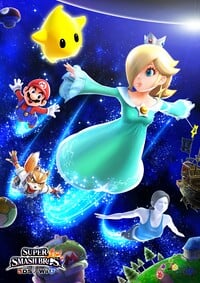
- Metroid Prime 3: Corruption: If the player has saved data for the game on their system, a sticker of Mario's emblem appears on Samus's Gunship.
- Mario Kart Wii: Rosalina is a playable character and is easier to unlock if the player has Super Mario Galaxy save data on their system. Star Bits surround Rainbow Road, and "Egg Planet" is incorporated as a countermelody to the course's theme music. Spiky Topmen appear as bosses in multiple online tournaments on a course named Galaxy Colosseum. The countdown sequence for ray surfing and Bob-omb Blasting was repurposed for the sequence for starting races and battles in this game.
- Mario & Luigi: Bowser's Inside Story: Bowser can use a rolling move similar to one he can perform during "The Fate of the Universe".
- Mario & Sonic at the Olympic Winter Games (Wii): Both the Individual and Team versions of Dream Ski Jumping take place in the Good Egg Galaxy. Several music tracks from Super Mario Galaxy are available in the in-game shop.
- New Super Mario Bros. Wii: During the credits, Princess Peach can be heard reading a version of the letter she sends to Mario at the beginning of Super Mario Galaxy. Clampys return in this game.
- Super Mario Galaxy 2: A dedicated sequel with many shared elements.
- Super Mario 3D Land: An arrangement of "Waltz of the Boos" is used for this game's Ghost Houses.
- Mario & Sonic at the London 2012 Olympic Games (Wii): Dream Spacewalk takes place in Synchro Battle Galaxy, a location partially based on Good Egg Galaxy. The event also features sound effects from Super Mario Galaxy and characters can spin. Dream Hurdles takes place in the Battlerock Galaxy. Rearrangements of the music pieces "Dino Piranha", "Battlerock Galaxy", and "Purple Comet" appear in the game. A Mii outfit based on Bee Mario can be unlocked in the game, and Mario's special dash has also been updated to resemble the spin.
- Mario Kart 7: Queen Bee can be unlocked as a playable character. The Comet Observatory, Gateway Galaxy's starting planet, a Starshroom, and several domes appear in the background of Rosalina's Ice World.
- Mario Party 9: "Enter Bowser Jr.!" was rearranged for some of the minigames with Bowser Jr.
- Mario Tennis Open: A Luma can be unlocked as a playable character. Galaxy Arena is based on this game, with "Rosalina in the Observatory" rearranged for the court's background music. "Egg Planet" was remixed for the music in Galaxy Rally, itself influenced by Super Mario Galaxy. The Comet Observatory appears in the background of the title screen.
- Paper Mario: Sticker Star: "Waltz of the Boos" was arranged for part of the Enigmansion's background music. Another, big-band-styled version plays when the Boos escape from the Book of Sealing.
- Mario Party: Island Tour: Rocket Road is based on this game and "Egg Planet" is incorporated into the board's background music. Rosalina and Lumas appear in the background.
- Super Mario 3D World: Rosalina and the Toad Brigade Captain appear as playable characters. Rosalina's unique attack is the spin. Electrogoombas, Lumas, and the Comet Observatory appear in Super Galaxy, itself based on Super Mario Galaxy. Star Bits appear in the background of special worlds that occur in outer space. The original "Rosalina in the Observatory" plays in World Crown. "Champion Road" is an arrangement of "Gusty Garden Galaxy". "Captain Toad Goes Forth" is an elaboration on "The Toad Brigade".
- Mario Golf: World Tour: Rosalina is a DLC character. Mario's Star uses elements from Super Mario Galaxy. "The Honeyhive" was rearranged for the background music of Wiggler Park.
- Mario Kart 8: The airline company Galaxy Air uses a Luma as its mascot. "Gusty Garden Galaxy" was rearranged for a portion of "Cloudtop Cruise".
- Super Smash Bros. for Nintendo 3DS / Wii U: Rosalina & Luma appear as newcomers. In the Wii U version, Mario Galaxy is based on this game and resembles Gateway Galaxy's starting planet. Trophies of Apricot Luma, The Toad Brigade, Bee Mario, Boo Mario, Spring Mario, and Rainbow Mario appear in the game. There is a Trophy Box dedicated to this game. "Rosalina in the Observatory / Luma's Theme" and "Egg Planet" are rearrangements of the original game's music.
- Captain Toad: Treasure Tracker: The red Starshroom appears.
- Mario Party 10: An arrangement of "Rosalina in the Observatory" titled "Rosalina's Theme" can be heard when Rosalina's amiibo is being controlled in amiibo Party.
- Style Savvy: Fashion Forward: A yukata based on Rosalina was released as free DLC. A Luma is embroidered on the sash.
- Puzzle & Dragons: Super Mario Bros. Edition: Rosalina, Bee Mario, and Boo Mario appear as Helpers for the player's team. "Gusty Garden Galaxy" music is used in the game's credits.
- Super Mario Maker: The victory and death themes from Super Mario Galaxy are used when the Rosalina costume completes a level or loses a life, respectively.
- Mario & Sonic at the Rio 2016 Olympic Games: An arrangement of "Rosalina in the Observatory" is available as a track.
- Mario Party: Star Rush: "Gusty Garden Galaxy" is one of the songs in the Rhythm Recital mode for this game.[140]
- Mario + Rabbids Kingdom Battle: Bee Mushrooms can be found on tubes of honey.
- Super Mario Odyssey: An 8-bit character of Rosalina appears in Dark Side and Darker Side. "The Odyssey: Power Up!" is an arrangement of the fanfare that plays when Mario collects a new power-up. The regional coins in the Moon Kingdom are shaped like Star Bits. There is a musical Easter egg on the pause menu where when pausing and selecting options, a simple arrangement of "Rosalina in the Observatory" can be heard.
- Super Smash Bros. Ultimate: With the exception of trophies, all of the elements related to Super Mario Galaxy from Super Smash Bros. for Nintendo 3DS / Wii U - including Rosalina & Luma - return. They have a revised Final Smash that uses the Grand Star. Boo Mario, Luma, Hungry Luma, and Queen Bee appears as spirits and use their artwork from Super Mario Galaxy. Queen Bee runs a Dojo.
- Super Mario Maker 2: The Wii sound effect causes "Gusty Garden Galaxy" music to play on a level.
- Mario Kart Tour: Ice Mario is a playable driver.
- Dr. Mario World: World 8 is based on the game. The Comet Observatory and planets from Good Egg Galaxy appear in the background. Dr. Rosalina and Dr. Luma were introduced with World 8 in October, 2019.
- Mario + Rabbids Sparks of Hope: Rabbid Rosalina is a playable character. The antagonist Cursa possesses Rosalina herself for most of the game. Sparks are part Luma. An arrangement of "Rosalina in the Observatory" plays when Rabbid Rosalina obtains a Purified Darkmess Energy Crystal. A music box rendition of the main melody's first three notes also plays when Rabbid Rosalina uses her Ennui move. An arrangement of the theme also plays when Rabbid Rosalina is introduced in the game's cinematic trailer.
- The Super Mario Bros. Movie: A Lumalee and bats are in the movie. "The Toad Brigade" is incorporated into "Strange New World". The piece overall is associated with Toad. An arrangement of "Gusty Garden Galaxy" plays in the credits.
- Super Mario Bros. Wonder Pumpkins bear a resemblance to Jack O'Goomba Pumpkins when a Wonder Effect is activated
Gallery
- For this subject's image gallery, see Gallery:Super Mario Galaxy.
Mario floating with a blue Luma
Concept art of the Toad Brigade in their Starshroom
Illustration from chapter 9 of Rosalina's Story
Names in other languages
| Language | Name | Meaning | Notes |
|---|---|---|---|
| Japanese | スーパーマリオギャラクシー[2] Sūpā Mario Gyarakushī |
Super Mario Galaxy | |
| Chinese (simplified) | 超级马力欧银河[143] Chāojí Mǎlìōu Yínhé |
Super Mario Galaxy | |
| Chinese (traditional) | 超級瑪利歐銀河[142] Chāojí Mǎlìōu Yínhé |
Super Mario Galaxy | |
| Korean | 슈퍼 마리오 Wii 갤럭시 어드벤처[141] Syupeo Mario Wii Gaelleoksi Eodeubencheo |
Super Mario Wii: Galaxy Adventure |
Trivia
- Coincidentally, a game titled "Super Mario Galaxy" was first mentioned in a fan letter written to Nintendo Power in 1991. The letter details a fantasy game console called the Raw Power System that would come bundled with a game named "Super Mario Galaxy", otherwise known as "Super Mario Bros. 24".[144]
- Insomniac Games' marketing director, Ryan Schneider, believed the game's spherical world concept potentially derived from Ratchet & Clank: Going Commando and Up Your Arsenal, which he thought was "flattering."[145] When asked if this was a correct observation in an interview with Official Nintendo Magazine, Shigeru Miyamoto shared he was unfamiliar with the Ratchet & Clank games and did not even know what consoles they were on.[146]
- An automated phone message sent to people who preordered the game at GameStop incorrectly stated Super Mario Galaxy is a Mature-rated game.[147]
- The galaxy image in the Super Mario Galaxy wordmark derives from this photograph of the Andromeda Galaxy.[148][149]
- Super Mario Galaxy has been used in neurobiology research to investigate how consistent engagement with interactive stimuli affects grey matter in elderly people.[150][151]
- This game does not have a Dutch translation, as Nintendo of Europe did not localize games into that language at the time. Despite this, one single message in the game was translated, being the prompt to insert the Nunchuk into the Wii Remote.
- The game was released under the name Super Mario Wii: Galaxy Adventure in South Korea because "galaxy" was already a registered trademark there.[152]
Notes and references
Notes
References
- ^ 浪玩堂 (5 Dec. 2017). 英伟达全球副总裁,中国区总经理张建中先生在现场为我们介绍国行英伟达SHIELD的最新消息,来看看他的游戏阵容!任天堂Wii上游戏将在SHIELD上与我们见面!. Sina Visitor System (Chinese). Retrieved 21 Mar. 2021. (Archived December 7, 2017, 17:57:54 UTC via Wayback Machine.)
- ^ a b Sakai, Kazuya (Ambit), kikai, Akinori Sao, Junko Fukuda, Kunio Takayama, and Ko Nakahara (Shogakukan), editors (2015). 『スーパーマリオブラザーズ百科: 任天堂公式ガイドブック』. Tokyo: Shogakukan (Japanese).
- ^ a b c Nintendo of America (17 Jan. 2017). Nintendo Switch Presentation 2017. YouTube. Retrieved 30 Jan. 2021.
- ^ a b c Trinen, Bill (14 Jun. 2017). What's in a Box?. Nintendo Treehouse Log. Retrieved 30 Jan. 2021.
- ^ Nintendo Co., Ltd. (31 Mar. 2020). IR Information : Financial Data - Top Selling Title Sales Units - Wii Software. Nintendo Co., Ltd. Retrieved 6 Mar. 2021.
- ^ a b c Nintendo of America (3 Sep. 2020). Super Mario Bros. 35th Anniversary Direct. YouTube.
- ^ a b Cremin, Colin (Jan. 2012). The Formal Qualities of the Video Game: An Exploration of Super Mario Galaxy With Gilles Deleuze. Games and Culture, 7(1), SAGE Publishing. Page 72–86.
- ^ a b Polygon Staff (27 Nov. 2017). The 500 Best Video Games of All Time. Polygon. Retrieved 30 Dec. 2022. (Archived March 3, 2018, 21:08:43 UTC via Wayback Machine.)
- ^ a b TV Asahi staff (27 Dec. 2021). 国民5万人がガチ投票!テレビゲーム総選挙. TV Game Sousenkyo『乃木坂46 賀喜遥香』 (Japanese).
- ^ a b Ashcraft, Brian (28 Dec. 2021). Poll: Here Are Japan's Top 100 Video Games Of All Time. Kotaku. Retrieved 30 Dec. 2022.
- ^ Black, Fletcher (2007). Super Mario Galaxy: PRIMA Official Game Guide (Collector's Edition). Roseville: Prima Games. ISBN 978-0-7615-5713-5. Page 12.
- ^ Juliusaurus (4 Jan. 2009). Super Mario Galaxy Co-op Fun: Midair Jumps. YouTube. Retrieved 6 Mar. 2021.
- ^ リンカー Linker / 紫月リン Rin Shizuki (6 Oct. 2011). スーパーマリオギャラクシーを実況プレイ Part52. YouTube (Japanese). Retrieved 27 Oct. 2019.
- ^ Chinese Nintendo [@chinesenintendo] (24 Mar. 2018). For some reasons, the A button when choosing a Galaxy has been bound to RT instead of A. (The second image is the same text from the original English release). Twitter. Retrieved 6 Mar. 2021.
- ^ Chinese Nintendo [@chinesenintendo] (19 Jul. 2018). And yes, tilting in Super Mario Galaxy has been replaced by simply the left analog stick on Nvidia Shield. Twitter. Retrieved 6 Mar. 2021.
- ^ ドラガリキノピコ (21 Jun. 2018). スーパーマリオギャラクシー Part2 ワールド2 バスルーム. YouTube (Chinese). Retrieved 6 Mar. 2021.
- ^ a b c d e f g h i j k l m n o p q r s t u v Iwata, Satoru (2007). Wii interviews: Super Mario Galaxy. Iwata Asks. Retrieved 7 Mar. 2012.
- ^ a b c d e f g h i j k l m Koizumi, Yoshiaki (27 Nov. 2007). Super Mario Galaxy: The Journey from Garden to Galaxy. Montréal: Montreal International Games Summit, Alliance numériQC. Retrieved 27 Feb. 2021. (Archived 24 Sep. 2016 via YouTube by Eric St-Cyr and A Hover.)
- ^ a b c d e Ashworth, Michael [Jasper] (29 Sep. 2020). How Spherical Planets Bent the Rules in Super Mario Galaxy. YouTube. Retrieved 27 Feb. 2021.
- ^ a b c d e f g h Kohler, Chris (4 Dec. 2007). Interview: Super Mario Galaxy Director On Sneaking Stories Past Miyamoto. WIRED. Retrieved 27 Feb. 2021.
- ^ a b c d e f g h i Geller, Jacob (15 Feb. 2019). The Quiet Sadness of Mario Galaxy. YouTube. Retrieved 30 Jan. 2021.
- ^ a b c Meintema, Ruben Aize (Apr. 2010). Planets as small as your house: A review of Super Mario Galaxy. Eludamos: Journal for Computer Game Culture, 4(1), University of Tromsø – The Arctic University of Norway. Pages 125–28.
- ^ "We have discovered an enemy base in the region!" – Polari after the player has accumulated enough Power Stars (12 Nov. 2007). Super Mario Galaxy by Nintendo EAD Tokyo (North American Localization). Nintendo of America. Retrieved 26 Apr. 2024.
- ^ a b "Luigi was kidnapped by the monster that lives here." – Toad Brigade Captain during "Beware of Bouldergeist" (12 Nov. 2007). Super Mario Galaxy by Nintendo EAD Tokyo (North American Localization). Nintendo of America. Retrieved 02 Mar. 2021.
- ^ Byford, Sam (28 Aug. 2017). Nintendo's Yoshiaki Koizumi on Super Mario Odyssey and the Future of the Switch. The Verge.
- ^ Beaumont, Peter (31 Jul. 2010). Antoine de Saint-Exupéry's Little Prince poised for a multimedia return to Earth. The Observer. Retrieved 22 Dec. 2023.
- ^ Black, page 145
- ^ Black, page 111
- ^ Super Mario Galaxy internal filename (ObjectData/ElectricBall.arc)
- ^ "Not bad! I guess I chose the right guy to be my archenemy." – Bowser during "Darkness on the Horizon" (12 Nov. 2007). Super Mario Galaxy by Nintendo EAD Tokyo (North American Localization). Nintendo of America. Retrieved 18 May 2023.
- ^ Black, page 159
- ^ Black, page 42
- ^ Black, page 298
- ^ Black, page 251
- ^ a b c Mario Galaxy Orchestra (1 Jan. 2008). Super Mario Galaxy Original Soundtrack. Nintendo of Europe. (Archived via Video Game Music Database.)
- ^ a b Napolitano, Jayson (23 Mar. 2010). A Blast from the Past: Koji Kondo and Mahito Yokota Talk Super Mario Galaxy. Original Sound Version. Retrieved 8 Apr. 2023.
- ^ a b Reale, Steven (2021). Analytical Traditions and Game Music: Super Mario Galaxy as a Case Study. The Cambridge Companion to Video Game Music, Cambridge: Cambridge University Press. Page 193–219.
- ^ Meyer, John (12 Oct. 2011). Nintendo Bundles Redesigned Wii With Mario. WIRED. Retrieved 8 Apr. 2023.
- ^ a b Famitsu (29 Sept. 2008). PRESS START 2008 -SYMPHONY OF GAMESの詳細リポートをお届け!. Famitsu (Japanese). Retrieved 9 Apr. 2023.
- ^ Greening, Chris (Sept. 2010). Interview with Symphonic Legends Producer (September 2010). Square Enix Music Online. Retrieved 9 Apr. 2023.
- ^ Lane, Gavin (11 Dec. 2020). Video Listen To The London Philharmonic's Super Mario Medley From Abbey Road. Nintendo Life. Retrieved 9 Apr. 2023.
- ^ Chinese Nintendo [@chinesenintendo] (1 Apr. 2018). iQue appears in the credits of Super Mario Galaxy on Nvidia Shield. It seemed that the game was fully translated for the iQue Wii release before the console was cancelled.. Twitter. Retrieved 21 Mar. 2021.
- ^ Barton, Matt (2019). "Super Mario 64: No Disc, No Problem." Vintage Games 2.0: An Insider Look at the Most Influential Games of All Time (2nd ed.). United Kingdom: CRC Press.
- ^ Bycer, Joshua (2019). "11.3 The Mario 64 Formula." Game Design Deep Dive: Platformers. United States: CRC Press.
- ^ Swink, Steve (2008). Game Feel: A Game Designer's Guide to Virtual Sensation. United Kingdom: CRC Press. Page 265–68.
- ^ Swan, Leslie, and Scott Pelland, editors (Aug. 1997). "Pak Watch E3 Report 'The Game Masters'." Nintendo Power (99). Redmond: Nintendo of America. Page 104–05.
- ^ a b c DidYouKnowGaming (10 Oct. 2020). Super Mario 128 Ft. Dunkey - DidYouKnowGaming. YouTube. Retrieved 17 Apr. 2023.
- ^ a b c Miyamoto, Shigeru (8 Mar. 2007). A Creative Vision. San Francisco: Game Developers Conference, Informa. Archived by CARSLOCK. YouTube, 9 May. 2011. Retrieved 17 Apr. 2023.
- ^ Gantayat, Anoop (21 Aug. 2006). Miyamoto Opens the Vault. IGN. Retrieved 17 Apr. 2023.
- ^ Gantayat, Anoop (10 Dec. 2002). Nintendo Talks Pikmin 2 and Mario 128. IGN. Retrieved 17 Apr. 2023.
- ^ Powers, Rick (10 Dec. 2002). Miyamoto Confirms Two Sequels. Nintendo World Report. Retrieved 17 Apr. 2023.
- ^ Black, page 350
- ^ Iwata, Satoru (2010). Wii interviews: Super Mario Galaxy 2. Iwata Asks. Retrieved 18 Apr. 2023.
- ^ Enterplay, LLC (19 Apr. 2007). Super Mario Galaxy Trading Card Fun Paks!. EnterPLAY. Retrieved 18 Apr. 2023.
- ^ Jonathan (7 Nov. 2007). Mario and Buzz Aldrin Take It to Zero-G. GameFront.com. Retrieved 19 Oct. 2023.
- ^ "MTV (6 Nov. 2007). Multiplayer: Mario in Zero-G - (Video Clip). MTV. Retrieved 19 Oct. 2023.
- ^ Sablan, Kevin (5 Nov. 2007). Creating Buzz for 'Super Mario Galaxy. The Orange County Register. Retrieved 18 Apr. 2023.
- ^ adolfin4ever (18 Jan. 2021). Here's a Super Mario Galaxy "Flight Team" sewing patch which was worn by crew (including Buzz Aldrin) during a promotional shoot for the game which consisted of bringing a giant Mario costume into a Zero-G plane. Thanks to Galaxy Master for the photo of the patch!. Reddit. Retrieved 18 Apr. 2023.
- ^ Polo, Fernando Borrego (13 Nov. 2007). Mario alcanza las estrellas de la mano de Buzz Aldrin. MeriStation (Spanish). Retrieved 19 Oct. 2023.
- ^ q256 (13 Nov. 2007). Buzz Aldrin aterriza en la presentación de 'Super Mario Galaxy'. Ion Litio (Spanish). Retrieved 19 Oct. 2023.
- ^ GameRankings (3 Mar. 2009). Super Mario Galaxy. GameRankings. Retrieved 3 Mar. 2019. (Archived December 6, 2019, 04:07:48 UTC via Wayback Machine.)
- ^ Metacritic (2007). Super Mario Galaxy. Metacritic. Retrieved 9 Jan. 2024. (Archived January 10, 2024, 00:56:03 UTC via Wayback Machine.)
- ^ Metacritic. Best Games of All Time. Metacritic. Retrieved 9 Jan. 2024. (Archived January 10, 2024, 01:05:33 UTC via Wayback Machine.)
- ^ a b c d e f g h i Casamassina, Matt (8 Nov. 2007). Super Mario Galaxy Review. IGN.
- ^ a b c d e Dickens, Anthony (12 Nov. 2007). Super Mario Galaxy Review. Nintendo Life.
- ^ a b c d e f Robertson, Margaret (23 Nov. 2007). Super Mario Galaxy. Eurogamer.
- ^ a b c d e Orry, Tom (2007). Super Mario Galaxy Review. VideoGamer. Retrieved 10 Jan. 2024.
- ^ a b c d Linde, Aaron (12 Nov. 2007). Destructoid review: Super Mario Galaxy. Destructoid.
- ^ a b c d e f g Kamikaze, Nagata, Maria Yoshiike, Penki Yamamoto, and Gazō Aoyama (Oct. 2007). スーパーマリオギャラクシーのレビュー・評価・感想 (986). Weekly Famitsu (Japanese). Retrieved 21 Mar. 2021.
- ^ a b c Edge Staff (25 Nov. 2007). Super Mario Galaxy Review. Edge. Retrieved 10 Jan. 2024. (Archived June 9, 2012, 02:18:24 UTC via Wayback Machine.)
- ^ a b c d e Rogers, Tim (Dec. 2007). Super Mario Galaxy. Action Button Dot Net.
- ^ Dickens, Anthony (24 Oct. 2007). Famitsu Gives Super Mario Galaxy 38/40. Nintendo Life. Retrieved 21 Mar. 2021.
- ^ Scullion, Chris (Dec. 2007). Super Mario Galaxy review (23). Official Nintendo Magazine. Page 72–77. Retrieved 21 Mar. 2021. (Archived October 7, 2014, 11:08:29 UTC via Wayback Machine.)
- ^ Higginbotham, James (2007). Nintendo Magazine UK: Super Mario Galaxy Review. Pure Nintendo. Retrieved 21 Mar. 2021.
- ^ McNamara, Andy, editor (Dec. 2009). "Top 200 Games of All Time." Game Informer (200). Minneapolis: GameStop.
- ^ dantebk (2011). Game Informer's Top 200 Games of All Time. Giant Bomb. Retrieved 21 Mar. 2021.
- ^ Slate, Chris, editor in chief (May 2012). "Ultimate Super Mario." Nintendo Power (278). San Francisco: Future US. Page 60–69.
- ^ White, Reggie, Jr. (18 May 2012). Nintendo Power Ranks the Super Mario Series. GAMING ROCKS ON. Retrieved 21 Mar. 2021.
- ^ Thomason, Steve, editor in chief (Dec. 2012). "NP's Favorite Games of All Time." Nintendo Power (285). San Francisco: Future US. Page 10–28.
- ^ Kim, Shane (13 May, 2008). Banjo-Kazooie: Nuts and Bolts Q&A. Computer and Video Games. (Archived July 5, 2008, 16:19:26 UTC via Wayback Machine.)
- ^ Gillen, Kieron (13 Feb. 2008). RPS Exclusive: Warren Spector Interview. Rock Paper Shotgun.
- ^ Schafer, Tim [TimOfLegend] (11 Jan. 2016). I LOVE the Mario Galaxy games (even though Psychonauts did relative gravity first :D {And I think Ratchet did it before us}). I like the more challenging platformers too, but I think those would have to be an optional thing, like on a harder difficulty setting, so they don't exclude more story-minded players. Reddit.
- ^ Turczyn, Coury (26 Dec. 2017). Q&A: Tim Schafer's never-ending quest to inject storytelling into video games. PopCult.
- ^ a b c d e Lewell, James [Nitro Rad] (19 Jan. 2018). Super Mario Galaxy - Nitro Rad. YouTube.
- ^ Kohler, Chris (21 Nov. 2007). Super Mario Galaxy Makes Sales Splash In America. WIRED. Retrieved 21 Mar. 2021.
- ^ Raby, Mark (27 Nov. 2007). Super Mario Galaxy sees record first week sales. Tom's Hardware. Retrieved 21 Mar. 2021. (Archived December 8, 2017, 12:24:19 UTC via Wayback Machine.)
- ^ Martin, Matt (21 Nov. 2007). Super Mario Galaxy breaks 500k sales in first week. GamesIndustry.biz. Retrieved 8 Jan. 2024.
- ^ Nintendo Co., Ltd. (2008). Analysis of Operations and Financial Review (PDF). Annual Report 2008.
- ^ Nintendo Co., Ltd. (30 Sept. 2023). the original IR Information : Financial Data - Top Selling Title Sales Units - Wii Software. Nintendo Co., Ltd. Retrieved 8 Jan. 2024. (Archived December 5, 2023, 01:16:09 UTC via Wayback Machine.)
- ^ IGN staff (13 Jan. 2008). IGN Best of 2007. IGN. Retrieved 21 Mar. 2021. (Archived January 13, 2008, 20:37:07 UTC via Wayback Machine.)
- ^ Editing staff (2008). GameSpot's Best of 2007. GameSpot. Retrieved 21 Mar. 2021. (Archived November 30, 2009, 09:56:36 UTC via Wayback Machine.)
- ^ Crecente, Brian (28 Dec. 2007). Kotaku's Overall Game of the Year – 2007 Goaties. Kotaku. Retrieved 21 Mar. 2021. (Archived October 8, 2012, 05:10:51 UTC via Wayback Machine.)
- ^ Silverman, Ben (18 Dec. 2007). Best Overall Game of 2007. Yahoo! Games. Retrieved 21 Mar. 2021. (Archived December 24, 2007, 06:39:05 UTC via Wayback Machine.)
- ^ GameTrailers (1 Jan. 2008). GameTrailers Game of the Year Awards 2007. GameTrailers. Retrieved 7 Jan. 2024. (Archived via archive.today.)
- ^ Edge Staff (20 Dec. 2007). THE EDGE AWARDS 2007. Edge Online. Retrieved 21 Mar. 2021. (Archived October 18, 2012, 16:57:51 UTC via Wayback Machine.)
- ^ a b Digital Tech News staff (8 Dec. 2007). Spike TV VGA 2007 - Video Game Awards Winners. Digital Tech News. Retrieved 4 Jan. 2024. (Archived September 28, 2018, 22:55:01 UTC via Wayback Machine.)
- ^ Nintendo of America (8 Feb. 2008). Did You Know? Nintendo Wins Two Interactive Achievement Awards. Nintendo Official Site. Retrieved 21 Mar. 2021. (Archived February 13, 2008, 22:24:04 UTC via Wayback Machine.)
- ^ a b Academy of Interactive Arts & Sciences. Super Mario Galaxy. 2008 11th Annual Interactive Achievement Awards. Retrieved 5 Jan. 2024.
- ^ a b Informa Tech (28 Apr. 2021). Archive - 8th Annual Game Developers Choice Awards. Game Developers Choice Awards. Retrieved 5 Jan. 2024.
- ^ a b Famitsu (14 May 2008). 【動画追加】'ファミ通アワード2007'の大賞は『モンスターハンターポータブル 2nd』と『スーパーマリオギャラクシー』に決定!. Famitsu (Japanese). Retrieved 5 Jan. 2024.
- ^ a b Computer Entertainment Supplier's Association (9 Oct. 2008). Japan Game Awards 2008 'Games of the Year Division' Award Winners Chosen. Japan Game Awards 2008. Retrieved 4 Jan. 2024.
- ^ a b GamesRadar_UK (31 Oct. 2008). All the Golden Joystick Awards Winners. GamesRadar+. Retrieved 4 Jan. 2024.
- ^ a b Ward, Mark (10 Mar. 2009). As it happened: Bafta Game Awards. BBC News. Retrieved 5 Jan. 2024.
- ^ Oduba, Ore, Leah Gooding, Sonali, Hayley Cutts, and Ricky Boleto (11 Mar. 2009). Super Mario Galaxy's surprise win. CBBC Newsround. Retrieved 5 Jan. 2024.
- ^ Cellan-Jones, Rory (11 Mar. 2009). Three Baftas for Call of Duty 4. BBC News. Retrieved 5 Jan. 2024.
- ^ Nelson, Randy (11 Mar. 2009). Super Mario Galaxy voted 'best game' by BAFTA. Engadget. Retrieved 21 Mar. 2021.
- ^ a b British Academy of Film and Television Arts. Games in 2009. BAFTA Awards. Retrieved 6 Jan. 2024.
- ^ Goodacre, Kate (17 Feb. 2012). Nickelodeon Kids Choice Awards 2012: Nominations in Full. Digital Spy. Retrieved 4 Jan. 2024.
- ^ a b Gold Derby News Desk (31 Mar. 2012). Kids' Choice Awards 2012: Complete List of Winners. GoldDerby. Retrieved 5 Jan. 2024.
- ^ a b Parent, Marie-Joëlle (8 Nov. 2007). Nouveaux jeux Nintendo: un français lamentable. Canoë (French). Retrieved 21 Mar. 2021. (Archived via archive.today.)
- ^ a b c d e f g h Benfell, Grace (12 Nov. 2022). Super Mario Galaxy Showed Us Something the Series Hadn’t Before, and Hasn’t Since. GameSpot.
- ^ a b c Kim, Minsoo (22 May 2023). Super Mario Galaxy (and why it’s important to me). Medium.
- ^ a b c d e Webb, Sophie (13 Nov. 2023). Super Mario Galaxy: In Space No-One Can Hear You Mamma Mia. University of Birmingham Guild of Students: Redbrick.
- ^ "The Luma that's been traveling with you may also grow up to become a star someday. Some Lumas become planets...some become comets...and a few become Power Stars." – Rosalina during "Gateway's Purple Coins" (12 Nov. 2007). Super Mario Galaxy by Nintendo EAD Tokyo (North American Localization). Nintendo of America. Retrieved Retrieved 4 Jan. 2024.
- ^ Melina, Remy (15 June 2023). Are we really all made from stars?. Live Science.
- ^ Hoffman, Chris (Oct. 2007). "Reach for the Stars." Nintendo Power (220). Redmond: Nintendo of America. Page 34–39.
- ^ a b Slate, Chris (Oct. 2011). "Keys to the Kingdom." Nintendo Power (272). San Francisco: Future US. Page 48–54.
- ^ a b Kohler, Chris (21 Nov. 2013). Nintendo, Please Make Me a Single-Player Mario Game Again. WIRED.
- ^ a b Phillips, Tom (5 Sept. 2015). Super Mario Galaxy 3 possible, but not before Nintendo's next console. Eurogamer.
- ^ Yoshida, Rikuto (2019). "Moon Kingdom" in The Art of Super Mario Odyssey by Kazuya Sakai, kikai, Rachel Roberts, and Jenny Blenk, editors (First English Edition). Milwaukie: Dark Horse. Page 281.
- ^ Z (20 Oct. 2017). The Power of Fun: Kenta Motokura and Yoshiaki Koizumi Talk 'Super Mario Odyssey'. GeekDad.
- ^ iggynosuupu (17 Sept. 2019). Mario and Friends Now Welcoming Visitors to Narita Airport. NintendoSoup.
- ^ Kohler, Chris (15 Dec. 2016). Super Mario Run Is Here — and Shigeru Miyamoto Told Us 7 Surprising Things About It. WIRED.
- ^ DidYouKnowGaming (29 Feb. 2020). China's Super Mario Galaxy Rip-Off - Region Locked ft. @ashens. YouTube.
- ^ djmurr and PushDustIn, translators (4 Jul. 2015). "Image Transcriptions of Project Proposal for Smash for Wii U/3DS". Source Gaming. Retrieved 28 Apr. 2023.
- ^ McFerran, Damien (18 Jan. 2013). Developer Interview: Fuzzy Wuzzy Games Talks Armillo And Developing For The Wii U eShop. Nintendo Life. Retrieved 6 Jul. 2023.
- ^ Hamilton, Kirk (18 Jun. 2013). A Fresh Look At Gravity Ghost, The Little Indie Mario Galaxy That Could. Kotaku.
- ^ Game Developer Staff (20 Apr. 2016). 7 examples of great game physics that every developer should study. Game Developer.
- ^ Sinclair, Brendan (19 Nov. 2019). Making Gears of War click for more than the hardcore. GamesIndustry.biz. Retrieved 28 Apr. 2023.
- ^ Wood, Austin (15 Sept. 2021). Solar Ash lives up to its "dumb elevator pitch" of Super Mario Galaxy meets Shadow of the Colossus. GamesRadar+. Retrieved 28 Apr. 2023.
- ^ Deschamps, Marc (27 Oct. 2022). Mario + Rabbids Sparks of Hope Director David Soliani Reveals Inspirations, Nintendo's Limits, and More. ComicBook.com. Retrieved 28 Apr. 2023.
- ^ Cite error: Invalid
<ref>tag; no text was provided for refs namedwiiuJP - ^ Cite error: Invalid
<ref>tag; no text was provided for refs namedwiiuUS - ^ Cite error: Invalid
<ref>tag; no text was provided for refs namedwiiuEU - ^ Cite error: Invalid
<ref>tag; no text was provided for refs namedshield - ^ a b Chinese Nintendo [@chinesenintendo] (24 Mar. 2018). Super Mario Galaxy (Nvidia Shield) screenshots. Images provided by @brian02031. Twitter. Retrieved 15 Mar. 2021.
- ^ Old_Bag_EN [@MetalMarioJSKR] (5 Sept. 2020). I got in touch with people who worked on Nintendo's Chinese localization. SM3D All-Starts arrived at the localization team very early. Everyone thought they could just slap the existing Chinese ROMs from iQue/Nvidia, but negotiations weren't successful. Twitter. Retrieved 19 Apr. 2023.
- ^ Koopman, Daan [NintenDaan] (22 Sept. 2016). [Mario Party: Star Rush] Rhythm Recital Gameplay 2. YouTube. Retrieved 24 Sept. 2016.
- ^ Nintendo of Korea Co., Ltd. (2007). Super Mario Galaxy Korean Trailer. YouTube (Korean). Retrieved 21 Mar. 2021. (Archived 16 Jul. 2009 via Japancommercials4U2.)
- ^ Nintendo (Hong Kong) Limited (4 Sept. 2020). 《超級瑪利歐64》、《超級瑪利歐陽光》和《超級瑪利歐銀河》。3款歷代的3D瑪利歐收錄在Nintendo Switch的《超級瑪利歐 3D 收藏輯》,將於9月18日發售!. 任天堂(香港)有限公司網站 (Chinese). Retrieved Sept. 2020.
- ^ Nvidia (2018). 超级马力欧银河. NVIDIA SHIELD (Chinese). Retrieved 21 Mar. 2021.
- ^ Peterford, Jimmy (Dec. 1991). "If Only We Had 27 Fingers!" Nintendo Power (31). Redmond: Nintendo of America. Page 6.
- ^ Doree, Adam (3 Oct. 2007). Ratchet and Clank Future: Tools of Destruction for PS3: Insomniac Interview, October 2007. Kikizo. Retrieved 7 Jan. 2024.
- ^ Jackson, Mike (14 Dec. 2007). Miyamoto's 'never seen' Ratchet and Clank. Computer and Video Games. Retrieved 7 Jan. 2024. (Archived December 30, 2007, 06:57:35 UTC via Wayback Machine.)
- ^ GoNintendoRMC (14 Nov. 2007). Super Mario Galaxy - rated Mature?!. YouTube. Retrieved 30 Dec. 2015.
- ^ Captain Byte! [@CometMedal] (20 Aug. 2020). I found the full image of the galaxy depicted in Super Mario Galaxy's logo - an edited image of Andromeda Galaxy taken by Robert Gendler in 2005. It took some tricky work to confirm, but I pulled it off. Twitter. Retrieved 15 Mar. 2021.
- ^ Captain Byte! [@CometMedal] (6 Dec. 2020). Here's the exact edited image used by Nintendo, from Sonzaijiten, Vol. 21 (Space / Planets). Twitter. Retrieved 15 Mar. 2021.
- ^ West, Greg L., Benjamin Rich Zendel, Kyoko Konishi, Jessica Benady-Chorney, Veronique D. Bohbot, Isabelle Peretz, and Sylvie Belleville (6 Dec. 2017). Playing Super Mario 64 increases hippocampal grey matter in older adults. PLOS ONE, 12(12). Public Library of Science.
- ^ Moussa, Diarra, Benjamin Rich Zendel, Jessica Benady-Chorney, Caroll-Ann Blanchette, Franco Leporé, Isabelle Peretz, Sylvie Belleville, and Greg L. West (15 Dec. 2018). Playing Super Mario increases oculomotor inhibition and frontal eye field grey matter in older adults. Experimental Brain Research, 237(3), Springer Science+Business Media. Page 723–33.
- ^ Patent Trial and Appeal Board (13 Dec. 2006). 2006년 상표출원 제0063212 SUPER MARIO GALAXY. Daejeon: Korean Intellectual Property Trial and Appeal Board (Korean).
External links
- Mario Portal Game Archive (EN) (archive)
- Mario Portal Game Archive (JP)
- noclip.website
- Official Chinese site (archived)
- Official Japanese instruction booklet
- Official Japanese site
- Official Korean site (archived)
- Official North American English site (archived)
- Official North American instruction booklet (EN/FR/ES)
